
Tlte LYRE ACR O IIPN E €, D ISTNCT hIAL E IIIAY f99O ' :a
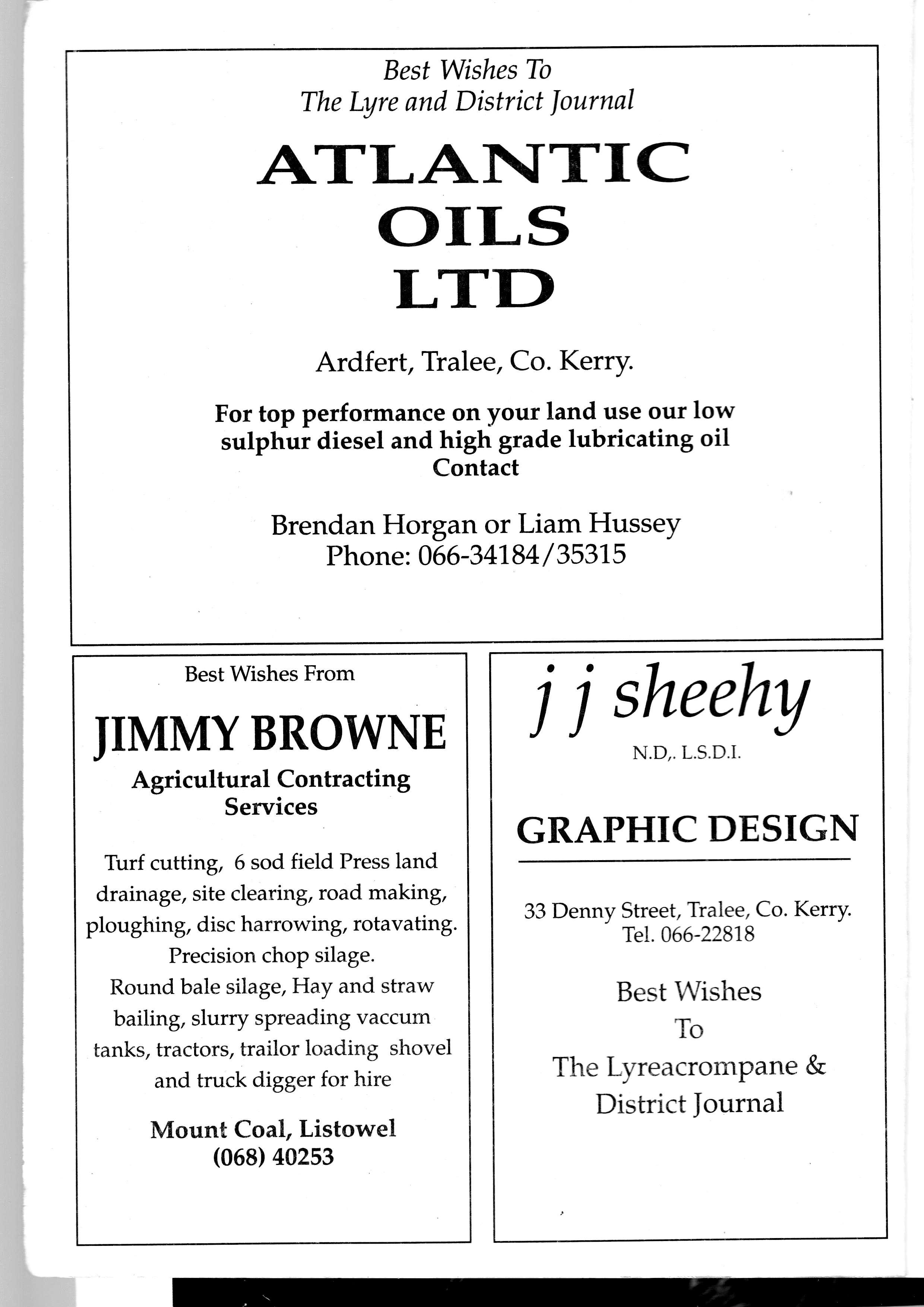
Best Wishes To The lryre and District lournal ATLANTIC OILS LTD Ardfert, Tralee, Co. Kerry. For top performance on your land use our low sulphui diesel and high grade lubricating oil Contact Brendan Horgan or Liam Hussey Phone: 066-34184 / 3531'5 Best Wishes From IIMMYBROWNE Agricultural Contracting Serwices Turf cutting, 6 sod field Press land drainage, site clearing, road making, ploughing, disc harrowing, rotavating. Precision chop silage. Round bale silage, Hay and straw bailing, slurry spreading vaccum tanks, tractors, trailor loading shovel and truck digger for hire Mount Coal, Listowel (068) 402s3 iisheehy N.D,. L.S.D.I GRAPHIC DESIGN Best Wishes To The Lyreacrompane & District ]ournal 33 Denny Street, Tralee, Co. KerrY. Tel.066-22818
I \ THIS, tre tir:t issue of the I Lr,rruti.'11i1 .tttL' Lttti District I lourttai r ou rr ill f ind articles, \ erse an.l photographs relating to Lvre and its people now and in the past. This is not the complete ston' - just bits and pieces. There is much more to be told about Lvreacrompane and the people who inhabit the area in the general vicinitv cf the River Smearlagh.
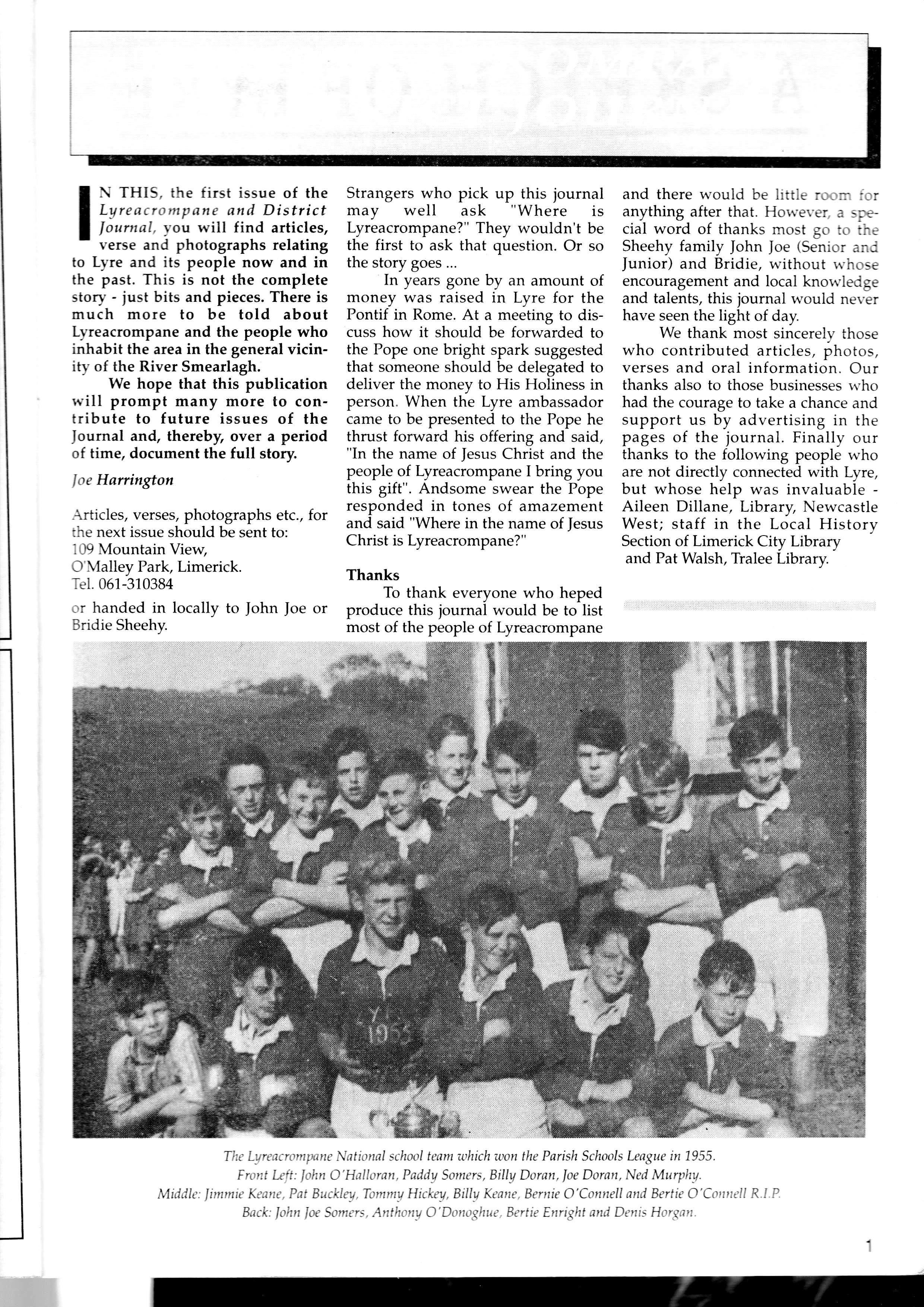
We hope that this publication rvill prompt many more to contribute to future issues of the Iournal and, thereby/ over a period of time, document the full story.
l.t Harrington
-{rticles, verses, photographs etc., for the next issue should be sent to:
1@ Mountain View, O'Malley Park, Limerick. Tel. 061-310384
or handed in locally to |ohn |oe or Bridie Sheehy.
Strangers who pick up this journal may well ask "Where is Lyreacrompane?" They wouldn't be the first to ask that question. Or so the story goes
In years gone by an amount of money was raised in Lyre for the Pontif in Rome. At a meeting to discuss how it should be forwarded to the Pope one bright spark suggested that someone should be delegated to deliver the money to His Holiness in person. When the Lyre ambassador came to be presented to the Pope he thrust forward his offering and said, "In the name of ]esus Christ and the people of Lyreacrompane I bring you this gift". Andsome swear the Pope responded in tones of amazement and said "Where in the name of Jesus Christ is Lyreacrompane?"
Thanks
To thank everyone who heped produce this journal would be to list most of the people of Lyreacrompane
and there u'ould be irtr,. :-.:- : anything after that, Flor,,'e,,.r -: :---:-cial word of thanks ntoit j. , :-. Sheehy family John ioe (Senrci ,..:: Junior) and Bridie, u-ithout rr h. s. encouragement and local knorr'1e.iqe and talents, this journal \r'trulgi p..'.have seen the light of day.
We thank most sincere.lr' those who contributed articles, pht,ro:, verses and oral information. Our thanks also to those businesses rr'hcr had the courage to take a chance and support us by advertising in the pages of the journal. Finallv our thanks to the follorving people n'ho are not directly connected n,ith Lvre, but whose help n,as invaluable Aileen Diilane, Library, Nervcastle West; staff in the Local Historv Section of Limerick City Librarv and Pat Walsh, Tralee Librarv.
Thc Lyreacrompne National school team tahich won the Parish Schmls kague in 1955.
Front
kft: lohn O'Halloran, Paddy Som*s, Billy Doran,loe Doran, Ned Murphy.
Middle: limmb Keane, Pat Buckley, Tommy Hickey, Billy Keane, Bemie O'Connell and Bertie O'Connell R.I.P. kck lohn le fumos, Anthony O'Donoghue, Bertie Enight and Denis Horgan.
OF LYRE
]oe Harrington
Lvreacrompane is situated midway be.tu.een the tow,ns of Listowel and Castieisland irr the valley of the Smearlagh River as it flows between the Glenaruddery Mountains and the Stacks Mctuntains. The ton,nland conttrins approximatelv 960 acres at an altitude. rlf 400 to 5ll0 feet above sea kvei.
It is difficult and probably irnpossible to determine with any degree of accuracv the time when Lyreacrompane and this general district was first inhabited. The boglands provide ample evidence thit the area was once almost totally under forest. A thousand years ago any scattered natives would have been irunters who, by their nature, lcft behind very little evidence of their eristence.
To the west of Clahanenaleragh lies a deep valley opening down from the mountains to the lowlands around the "New Line" on the Tlalee side of the "Halfway Ba1'. This impressive gorge is called Glenaleama and local legend attributes its name, the GIen of the Leap, to a challenge posed to Fionn McCumhail and the Fianna as they hunted in the area. To prove his identity to the doubting locals Fionn leaped the Glen and in a fit of bravado declared that he could also leap it backwards. However he fell short on the second attempt and landed with such force that he left the print of his heels on a rock in the valley.
Developments in the direction of more organised human activity in the area probably came from the lowlands in the direction of LixnawKilflynn, and Kilsynan. In the dry summer months livestock may have been driven up into the hills iround Lyreacrompane. Those who remained with the herd probably built the first stone or mud iabins for protection. (Cloghane is translated as a stone beehive shaped hut. Cloughboola probably meins a stone shelter for cattle during the summer).
A rental of the Lord of Lixnaw dating back over 500 years refers to a rent of 21 marks for what was proba-bly Cloughboola. ( "Nofes towards History of Duagh" P. Lysaght).
Population set back
In 1580 the Desmond Rebellion was put down with extreme crueltyin Munster by British forces under Sir William Pelham. In his dispatches Pelham wrote:
"We passed through the rebel countries in two coffipanies, burning with fire all inhabitants and executing the people whereoer we found them".
Near Shanagolden over 400 people fleeing the terror were slain in a wood and at Castleisland pelham confiscated 2000 cattle as well as other livestock. Famine swept the province. The Chronicles of Ireland state
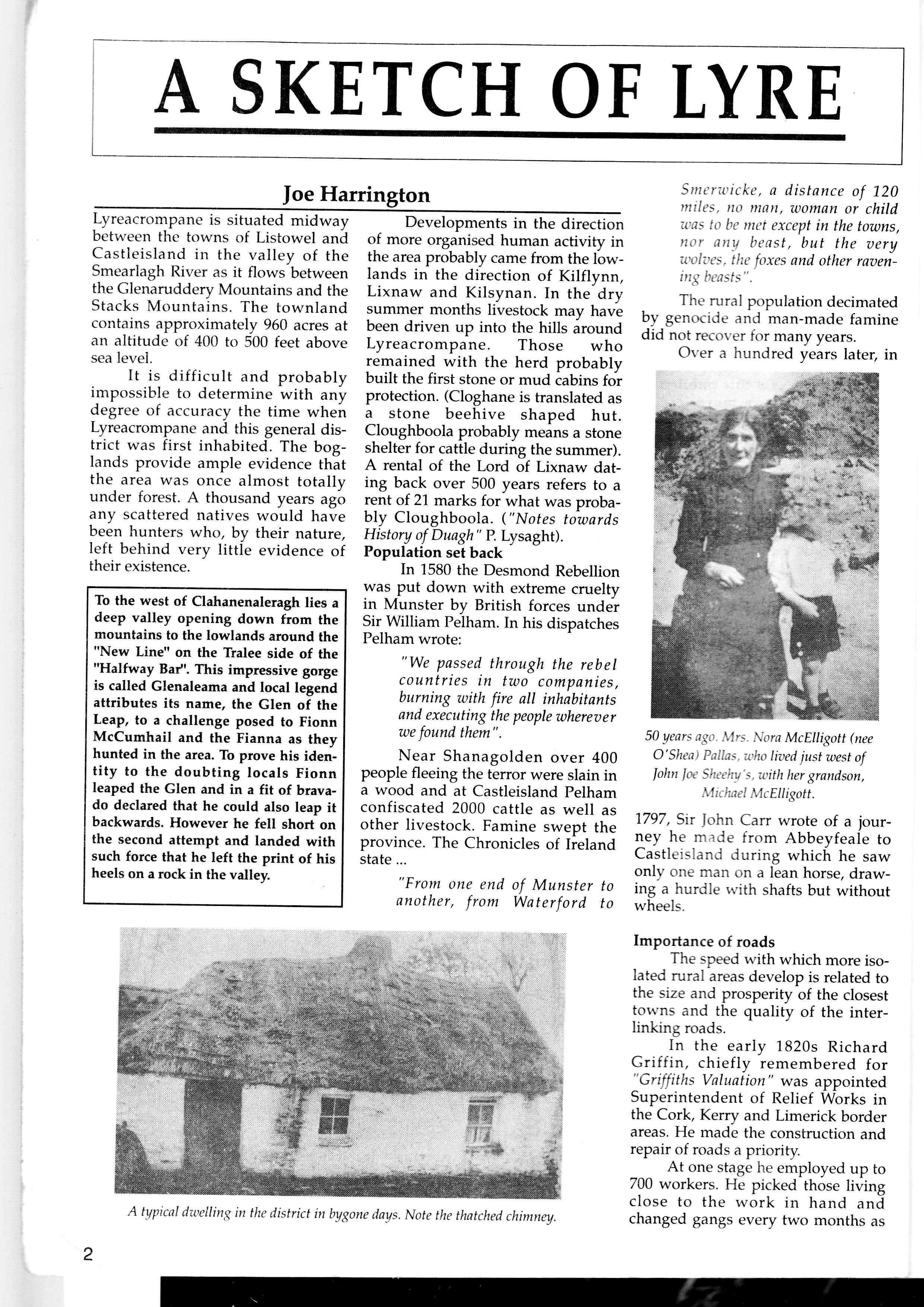
"From one end of Munster to another, from Waterford to
Smeru,icke, a distance of 120 miles, no man, tooman or child u,as to be met except in the totnns, nor any beast, but the aery zyoltes, the t'oxes and other rar)enirtg beasts".
The rural population decimated by genocide and man-made famine did not reco\:er for many years. Over a hundred years later, in
7797, Sir ]ohn Carr wrote of a jour1ey he made from Abbeyfeaie to Castleisland during which he saw only one man on a lean horse, drawing a hurdle with shafts but without wheels.
Importance of roads
The speed with which more isolated rural areas develop is related to the size and prosperity of the closest torvns and the quality of the interlinking roads.
In the early 1820s Richard Griffin, chiefly remembered for "Griffiths Valuation" was appointed Superintendent of Relief Wbrks in the Cork, Kerry and Limerick border areas. He made the construction and repair of roads a priority.
At one stage he employed up to 700 workers. He picked those living close to the work in hand and changed gangs every two months as
A SKETCH
50 years ago. Mrs. Nora McElligott (nee O'Sheil Pallas, irho lioed just west of lohn loe Sheehv's, with her grandson, Michael McElligott.
I A typical dwelling in the district in bygone days. Note the thatched chimney.
Newcastle
Abbeyfeale to Castleisland.
from Listowel in 1829, |ohnKelly, an engineer employed by the Knight of Kerry,
Abbeyfeale is
improaed in its appearance.
I sau it in 7823, there utas ()ne slated hotrse and tuto prtblic h,suses zoith a number of cabins. There nre now eleoen lnndsome slated lnuses, tuto stories high and eleten licensed public houses".
of the Crown lands
Ireland referred to "astonishing" improvements along the line of road irom Castleisland to Rathkeale.
wars, the genocide, the building of roads and the resultant iinprovements in towns and villages obvioush' did not directly impinge()n an isolated area like I-'u,reacrompane, but it would be rea:onable to sav that these things influc.ncc.d the pace at which its popuiation erpanded or contracted.
census of 1659 does not rlrention Lvreacrompane. The popuiation figure gir.en for the nearby torvn land oi Derrindaff is approxir-uatelv 30. Br' 1E-11 Derrindaff's pop-'rrlation had increased 8 times to 243 compared to 7-l for Lvre. If the popuiation of both ton-nlands rvas in the sanie proportion in 1tr59 this rvould :lle a pop,.rlation oi 9 for Lvreacrompane. \ot a \-er\- scientifiiallr" rt'orked out estinrate, hut n hatever the case, it is clear that the population of Lvre around 330 r'ear-s aso was verv smali or non-exiitent. The qrorvth in population u'ould
have followed the natural trend of rapid increase beginning about the middle of the 18th century and leading up to the famine.
The Census of 1851 gives information on the district in and around Lyreacrompane. (See box)
These figures seem to indicate that Lyreacrompane came through the famine with little, if any, loss of life. Perhaps the area was not completely dependent on the potato.Salmon and trout from the Smearlagh and its tributaries may have supplemented the local diet. (Many older people can recall even the smaller streams in the area teeming with fish before the advent of modern farming methods and monofilament nets). Highland dairying rather than low land tillage, may also have helped. In his "Notes towards a History of Duagh" P. Lysaght clams that Islandanny escaped the worst effects of the famine because the O'Mahony's of Kilmeany had a Scottish gardener who introduced turnips to the district.
During the famine years the population of the lowland townlands of Banemore, Clondouglas and Ballygrenane fell by 36%,75% and 35% respectively.

The 1851 Census of Ireland lists Lyreacrompane as being in the civil parish of Kilfeighny. Kilfeighnychurch was sited on the road between the New Line and Lixnaw where the ruins can still be seen. In 1870 the parish priest of Lixnaw, Fr. Roche, transferred the townlands of Carrigcannon, Clahanenagleragh, Clashnacree and Lyreacrompane to Duagh. According to f. Anthony Gaughan's "Listowel and its Vicinity", the transfer was probably carried out
on the understanding that Duagh would provide a chapel for the district. However, it wasn't until 1914 that Lyre church, (actually sited in Glounthane) was built by Fr. Beasley. Lyreacrompane is nowadays
Mrs. Ellen Naughton (nee llyan)
Knocknclare , u,it'e of Tom Naughton, utith baby Tommie and daughter Bridget figjT.
part of Duagh parish. However, the history of the parish throws little light on bygone days in the Lyre area. Situated in the fertile Feale valley, Duagh has been a centre of population for centuries. According to J. Anthony Gaughan's "Listoztel snd its Vicinity" the parish dates back to at least 1200. Thomas O'Connor was appointed parish priest in 1396. In 1,463-64 it was reported to Rome that a |ohn Neyl and later, a William Neyl held the parish although neither of them had been ordained. Patrick Fitzmoris rvas P.P. in 1517. On July 11 1704 Morrish Cahane was parish priest of both Duagh and Brosna. In 1806 a church n'as built to replace
Area Acres Population 1841 Population 1851 Number of houses 1841 1851 L\reacrompane Carrigcannon Cloghanenaleragh Braumaddra Banemore Irramore Pallas Knockclare Stack's Mountain Muingwee Knockaunbrack Knockalougha Bunglasha Cloghaneleskirt 980 962 577 379 72M 596 7077 797 846 287 493 1,244 216 875 :+ fr -J 21 22 266 793 183 49 84 36 728 159 45 30 -t )t 23 18 18 770 110 720 33 714 25 78 106 26 32 11 J 4 4 41 23 33 9 18 5 22 27 n 5 ii J 2 + 29 76 27 5 24 4 11 19 J 5 the road progressed. One of the routes was from
West, through
\\/riting
said: "The uillage of
much
Whan t'irst
The folloningyear, 1830, \Veale,]ames manager
in
The
The
3
one lvhich had surviveC for about rrrle lrundred years.
The nelv church was built bv Fr. J,,hn O Flahcrtv, O.P. arrJ hj.l a thatched roof. i'his church rr'as replaced in 1856 bl' the presc-nt one.
One hunclretl and thirtv tu'o vears ago. in 18r8, Clogl..aneeleskirt nas transferred from Abbeydorney to Duagh. This linked that townland with Dromada and Glounthane both of rvhich, together with Cloghboola, Glasananoon and Knocknaglogh, were already part of Duagh parish since, at least, 1820. At this time Clahane contained 5 houses and about 30 people.
Parish priests of Duagh since Lyreacrompane became part of that parish in 1870.
Rev. Fr. Moore 1868 - 1870
Rev. Fr. O'Regan 1870 - 1886
Fr. O'Regan administered the parish but was never officially parish priest.
Rev. Matt Dillon 1.886-1907
Rev. James Beasley 7907-7924
Rev. T. Griffin 1924-7949
Rev. Myles Allman 7950-1952
Rev. Denis Moriarty - 1952-1964
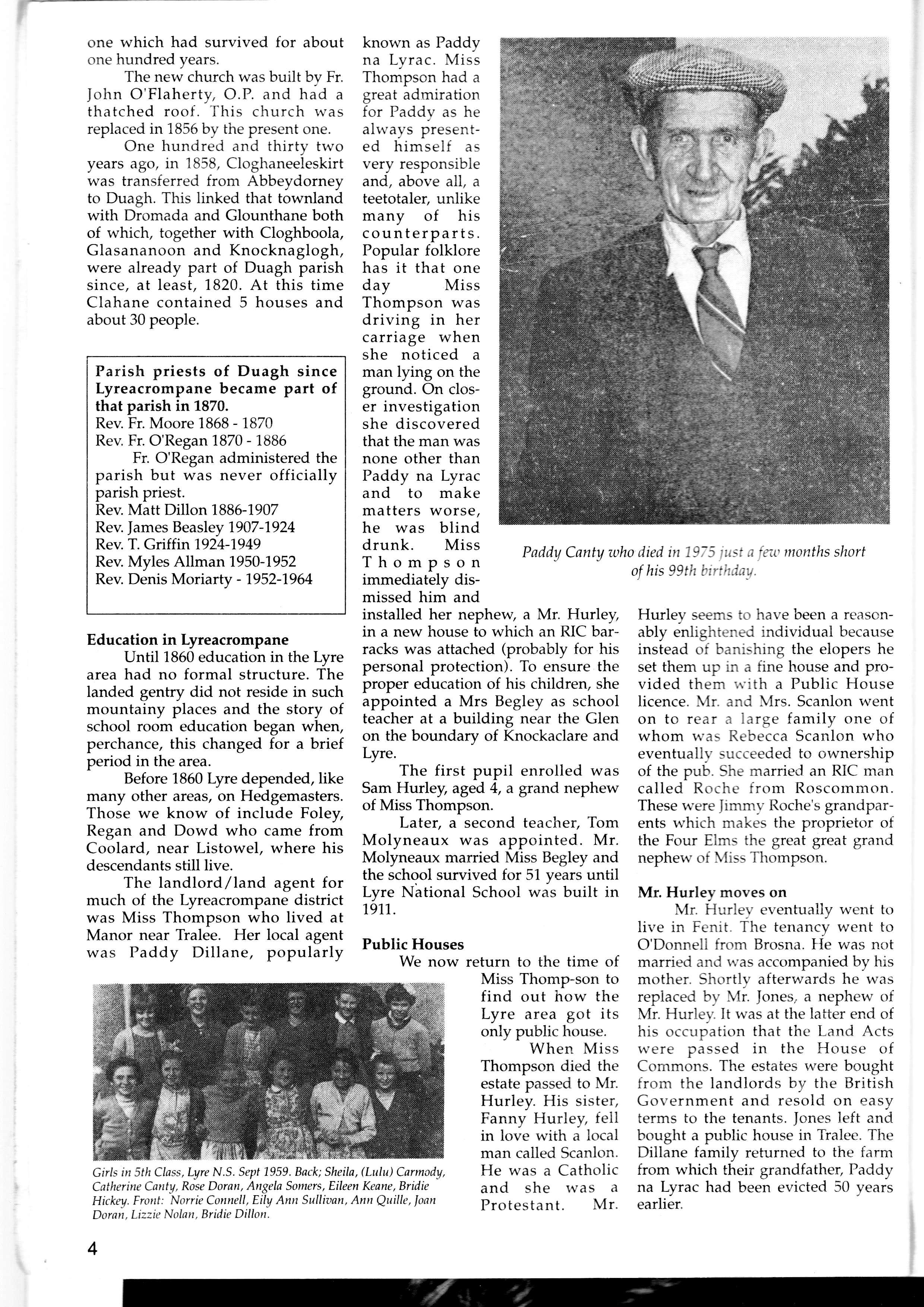
Education in Lyreacrompane
Until 1860 education in the Lyre area had no formal structure. The landed gentry did not reside in such mountainy places and the story of school room education began when, perchance, this changed for a brief period in the area.
Before 1860 Lyre depended, like many other areas, on Hedgemasters. Those we know of include Foley, Regan and Dowd who came from Coolard, near Listowel, where his descendants still live.
The landlord/land agent for much of the Lyreacrompane district was Miss Thompson who lived at Manor near Tralee. Her local agent was Paddy Dillane, popularly
knou,n as Paddv na Lvrac. Mis.c Thompson had a great adr.niration fcr Paddv as he aln'avs presented hirnseif as verv responsible and, above all, a teetotaler, unlike many of his counterparts. Popular folklore has it that one duy Miss Thompson n,as driving in her carriage when she noticed a man lying on the ground. On closer investigation she discovered that the man was none other than Paddy na Lyrac and to make matters worse/ he w'as blind drunk. Miss Thompson immediately dismissed him and installed her nephew, a Mr. Hurley, in a new house to which an RIC barracks was attached (probably for his personal protection). To ensure the proper education of his children, she appointed a Mrs Begley as school teacher at a building near the Glen on the boundary of Knockaclare and Ly.u.
The first pupil enrolled was Sam Hurley, aged 4,a grand nephew of Miss Thompson.
Later, a second teacher, Tom Molyneaux was appointed. Mr. Molyneaux married Miss Begley and the school survived for 51 years until Lyre Nhtional School was built in 1911.
Public Houses
We now return to the time of Miss Thomp-son to find out how the Lyre area got its only public house. When Miss Thompson died the estate passed to Mr. Hurley. His sister, Fanny Hurley, fell in love with a local man called Scanlon. He was a Catholic and she was a Protestant. Mr.
Hurley seems to have been a reascnably enlightened individual because instead of banishing the elopers he set them up in a fine house and provided them rr'ith a Public House licence. Mr. and Mrs. Scanlon went on to rear a large family one of whom rn'as Rebecca Scanlon who eventuallv succeeded to ownership of the pub. She married an RIC man called Roche from Roscornmon. These were Jimmv Roche's grandparents which makes the proprietor of the Four Elms the great great grand nephew of Miss Thompson.
Mr. Hurley moves on Mr. Hurlev eventuallv went to live in Fenit. The tenancy went to C)'Donnell from Brosna. FIe was not married and rvas accompanied by his mother. Shortlv afterwards he was replaced by Mr. Jones, a nephew of Mr. Hurler,. It was at the latter end of his occupation that the Land Acts were passed in the House of Commons. The estates were bought from the landlords by the British Government and resold on easy terms to the tenants. |ones left and bought a public house in Tralee. The Dillane family returned to the farm from which their grandfather, Paddy na Lyrac had been evicted 50 years earlier.
Paddy Canty who died in L975 iust a feur months short of his 99th birthday.
Girls in Sth Class, Lyre N.S. Sepf 1959. Back; Sheila, (Lulu) Carmody, Catherine Canty, Rose Doran, Angela Somers, Eileen Keane, Bridie Hickey. Front: Norrie Connell, Eily Ann Sullittan, Ann Quille,loan Doran, Lizzie Nolan, Bridie Dillon.
4
TALKING TO PADDY ENRIGHT
.'. -: .:'.: .: :l'.= -t.=.'::-': l. t-'. l':.:. : -',:.i. :I'-rrc ir, - '. -: :', i.: : - -l l'.r il. -1i Le -,tiaS bOfn : :l'.e -.: - .:-:--.::-. l;,-',. ), 1,. ',. ::. K:.thr, is three years '. -r'-in:LI ::-...:'. :r'.e. i met her fOr the --: :.:r-c :-.rr rri Leahy's Corner in *.-: -. .. ..irlheJ. He continued, i\'.. '...'er: ::-:arned 50 years ago next '-...r. -'\'e i',ar-e a daughter who is a : -ir'. r:1 Sacramento".
Paddv has seen many changes :1i.i.e he rlint to school in june 19b7. i\'e used to go to mass at the "Glen" r:: the house of Master Molyneaux. ','lass rvas said there every Sunday. i ir'as the school house for the rest of :he neek. Later the parish priest , Fr. Beasley fell out with the Molyneaux iamilv and the mass was transferred i Quills of Glasnacree" he recalls.
The first priest Paddy remem-':ers rvas a Fr. Dillon and he recalls :he horse and sidecar Fr. Beasley ,.rsed to get around. He went on, There was a curate named Fr. Ll Connor who was fond of fowling and a local lad who was young and innocent carried his bags for him. Some smart boys told him to ask the rriest to perform a miracle for him. Fr. O'Connor said he would and asked him to walk before him" The foolish young fellow did and the priest gave him a good kick on the b,ackside. "Did you feel that" asked the priest. "Why not I" said the lad. That's a pity", said the priest, T'rvould be a miracle if you didn't"

Paddy remembers the making .rf butter before creameries or even ihe separator came on the scene. He jescribed how the milk was put into pans on rvhat was called a Stellon. -{fter a ivhile the cream would rise to the top and be skimmed off into a rub. \\Ieeklv in the summers and fortnightlr' in the winter the cream ',rLrllld be put into a barrel. This was iurned br.' hand to produce the butler. The butter rvas then taken to Liston'el \larket and sold to dealers irom Tralee and Cork.
"The burtermilk rvas used for naking bread anC for making yellow :.real gruel. That rr'as a good feeding. n a good baker rr,r'seif. Hou, I start=l to make the bread ir-as that '.''ifemy broke her ankle and couldn't .iand so I had to learn, Tis in mv : ,:r'ei anr-rr'ar'. \1r' grar,rl uncle \\'as i' Enright rr-ho established the mi11s ::' Listor.,'eI." stated Paddv protrdlr'.
I asked him if he remembered
any of the old poetry or sceilg lists. He told me that most of them were offensive. The people enjoyed them in those days but the young crowd now would jail you for less than a poem. He gave a few lines but he warned; "Not For Publication"!
At this stage the kettle was boiled and the tea made and I was able to test Paddy's baking. While I enjoyed his homemade bread he told me how he joined the Volunteers in 1918. He went on.....
"There was 75 in the Lyre company. ]ohn Carey and myself were sent to Castleisland to learn First Aid.
Paddy also remembers the Wren Boys long ago......
"My song was about the Titanic. A three penny bit was the biggest you'd get. T'was usually a penny or two pence. Last year my grandsons Thomas and John Enright of Lyre made f,63 on Wren Day. T'was walking we went. All my school pals went with me - John |oe Murphy and Danny Stack". The talk came around to other forms of entertainment in the Post.
"I was only 15 years old when my father, God be good to him, paid Dan White 1.5/- for a week cutting hay. He asked me to go to a gamble with him over in Kilconlea. He had a date with a girl over there. We went to Cahills public house. T'was Cahills then;'tis the "Wounded Knee'now. I had 4 pints and I got drunk and White got drunk and we never went to the gamble. Porter was2t/zd a pint
tirat hme Pa;i', :r--:-...:
\1r'father ir'.'.';: :. - -. IJe built this house 1l[-r ve.::. ..:: The McKenna hrothers. i,'..:'. .rnd Willie were the builders. \1a...i',s at that time, along n,ith being p:id, would have to get pientv of pt r:er while on the job. If they didn t lhr.r' would leave you with a mdcaill such as a smoking chimney".
It was getting late. I said good night to Paddy and Katty and hit thc. road west through Lyre. I suppose the next time I will see both my old friends will be in the Kerryman celebrating their Golden Jubilee.
Bridie Sheehy
According to Paddy Enright the following is a short list of common plants found in the district:
Rangadhy
Tharrack
Canawauns
Thrawneengay
Poosha
Coonalimma Meenska
Paddy Enright,Tommy
Enright and Katty Enright
lohn B. Keane
From time to time readers ask me about characters from the essays and stories I have written over the years. Without doubt the greater number of queries concern a man who was affectionately known as the ram of God. He is dead now poor fellow and so are all his relations which is sad in one way but good in the sense that we are now free to discuss the short career of the ram in question. It was said of him that he sired countless offspring in the Stacks Mountains of my native North Kerry before finally departing to the state of Montana where he expired a few short years ago. It would not matter much if he had taken the precaution or had the common decenry, as they say, to marry before siring but this was not the poor fellow's way. The Ram was the youngest son of a small farmer who, for the want of something more fitting, was sent off at the tender age of eighteen to become a priest.
Two years before he was to become ordained however he discovered that he had no vocation so he returned shamefacedly to his home in the Stacks. In his heyday, from the beginning to the end of the second world war, he was without peer in the unholy art of seduction. He never broke hearts however. He made his intentions clear from the outset. There was never a slow waltzer or a cheek to cheek foxtrotter like him. His favourite song was: Say little hen! When will you lay me an egg for my tea?
His favourite hook was Robinson Crusoe and his favourite type of woman was red-haired. Oddly enough he was less successful with redheads than with blondes or brunettes. For some reason best
known to himself he always most assiduously avoided visiting Dan Paddy Andy's famous dancehall at the Cross of Renagown but one night in a pub in Tialee he announced that it was his intention to pay a call there. He was never to fulfill his promise. When Dan heard that the Ram of God was about to descend upon the innocent and sheltered females of Renagown and its hinterland he made one of his more memorable announcements from a musician's butterbox in his dancehall. "If the Ram of God makes the mistake of coming here" he warned "he'll go home a wether."
The Ram of God was so called because of the fact that he spent such a long time studying for the priesthood and because of his excessive and unseemly interest in the opposite sex. The fact that he flourished in that prohibitive clime and time sets him apart. "I had nothin' agin' the poor hoor personally" Dan Paddy once was heard to say "and his failing was the failing of many but I had my flock to look out for and I wasn't going to let him loose in Renagown."
After helping out on the family farm for the period of the war years the Ram hightailed it to Leicester City and afterwards to Montana where he set up a calf-fattening station some miles to the southeast of the town of Goose Creek. Very soon he was chasing females like nobody's business but this time the parents of his victims were gun-totin', orney sidewinders who didn't take too kindly to strangers molesting their womenfolk. With more than three score of shotgun pellets embedded in his buttocks he fled to New York where he worked as a barman until his demise a few years ago.
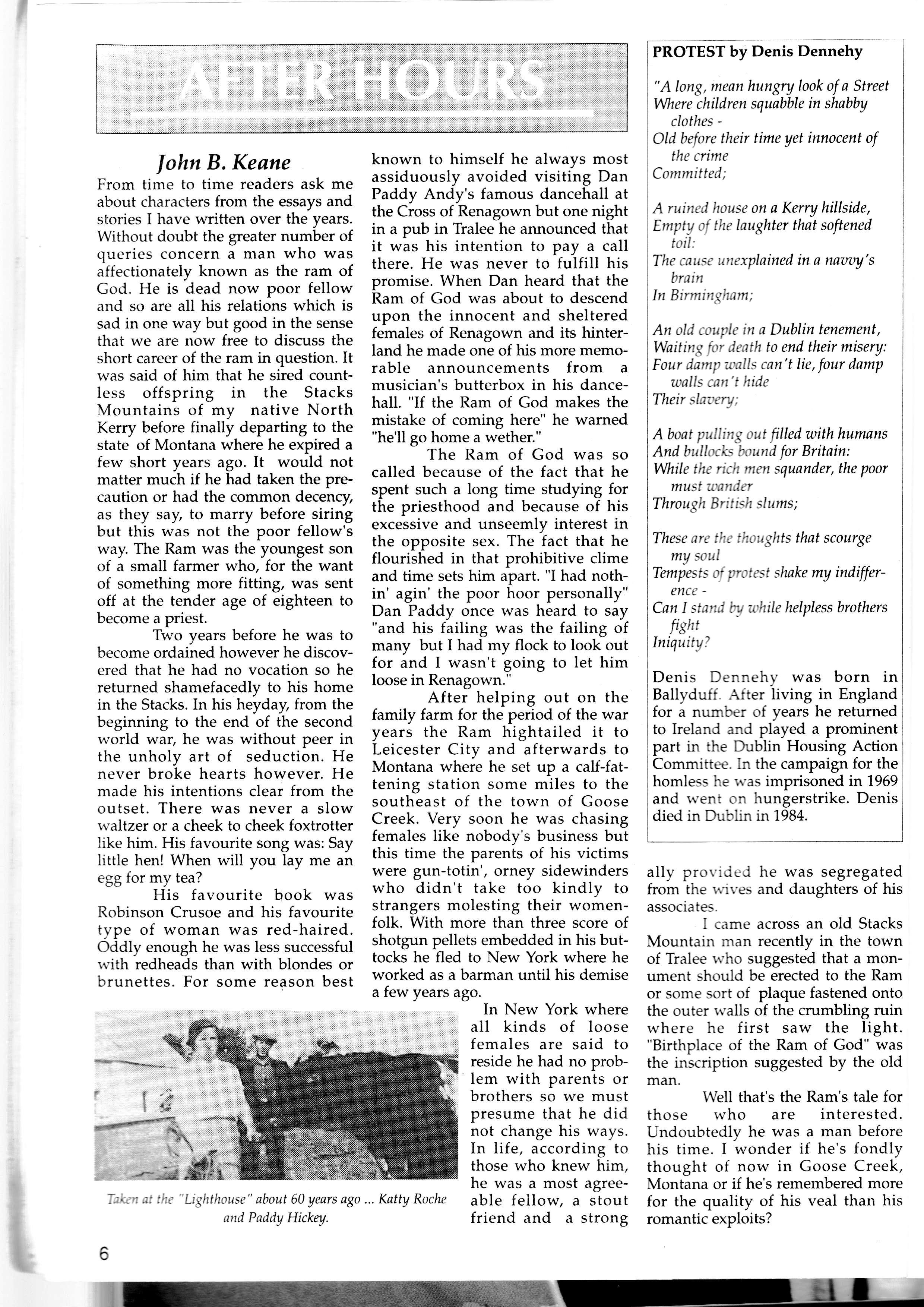
In New York where all kinds of loose females are said to reside he had no prob-'lem with parents or brothers so we must presume that he did not change his ways. In life, according to those who knew him, he was a most agreeable fellow, a stout friend and a strong
PROTEST by Denis Dennehy
" A long, mean hungry look of a Street Wrcre children squabble in shabby clothes
Old before their time yet innocent of the crime
Committed;
A ruineil house on a Kerry hillside, Empty of the laughter that softened toil:
The cauv unexplained in a nauay's brain
In Birmingham;
An old couple in a Dublin tenement, Waiting for ileath to end their misery: Four ilamp ualls can't lie, four damp unlls can't hide
Their slaoery;
A boat pulling out filled with humans And bullock bound for Britain:
While the rich men squnnder, the poor must uvnder
Through British slums;
These are the thoughts that scourge my nul
Tempests of protest shake my indifference
Can I stand bv uhile helpless brothers fisht lniquity?
Denis Dennehy was born in Ballyduff. After living in England for a number of years he returned to Ireland and played a prominent part in the Dublin Housing Action Committee. In the campaign for the homless he n'as imprisoned in 1959 and went on hungerstrike. Denis died in Dublin in 1984.
allv pror':o-l he was segregated from the r',.lr.es and daughters of his associa te:.
I came across an old Stacks Mountain :ran recently in the town of Tralee rr'ho suggested that a monument shtruld be erected to the Ram or sLrme sort of plaque fastened onto the outer rr'alls of the crumbling ruin rvhere he f irst saw the light. "Birthplace of the Ram of God" was the inscription suggested by the old man.
\Vell that's the Ram's tale for tho s e rvho are in teres ted. Undoubtedly he was a man before his time. I wonder if he's fondly thought of now in Goose Creek, Montana or if he's remembered more for the quality of his veal than his romantic exploits?
L
Ttka at the "Lighthouse" about 60 years ago Katty Roche and Paddy Hickey.
o
[fre gassirt tfte Sfeorl
The mehnl 17ns 71,ould qatlwr
On tlrc bank to cut the peat
With pike and slean and bog spade
To ioin them zuas a trent.
hilther rolling in the breqt thoughts itrside my hud ut tht dow uv rtxd the slean un our tlaily bread. Inglnnd lies deserted rtulk the long boreen tttrf lies neatly on the banks bogmen can't be seen Te once a hundred workers toiled 'in the humble sod. 'rf machine now trundles down place on which they trod nology has t'ound us - a reoolution gw
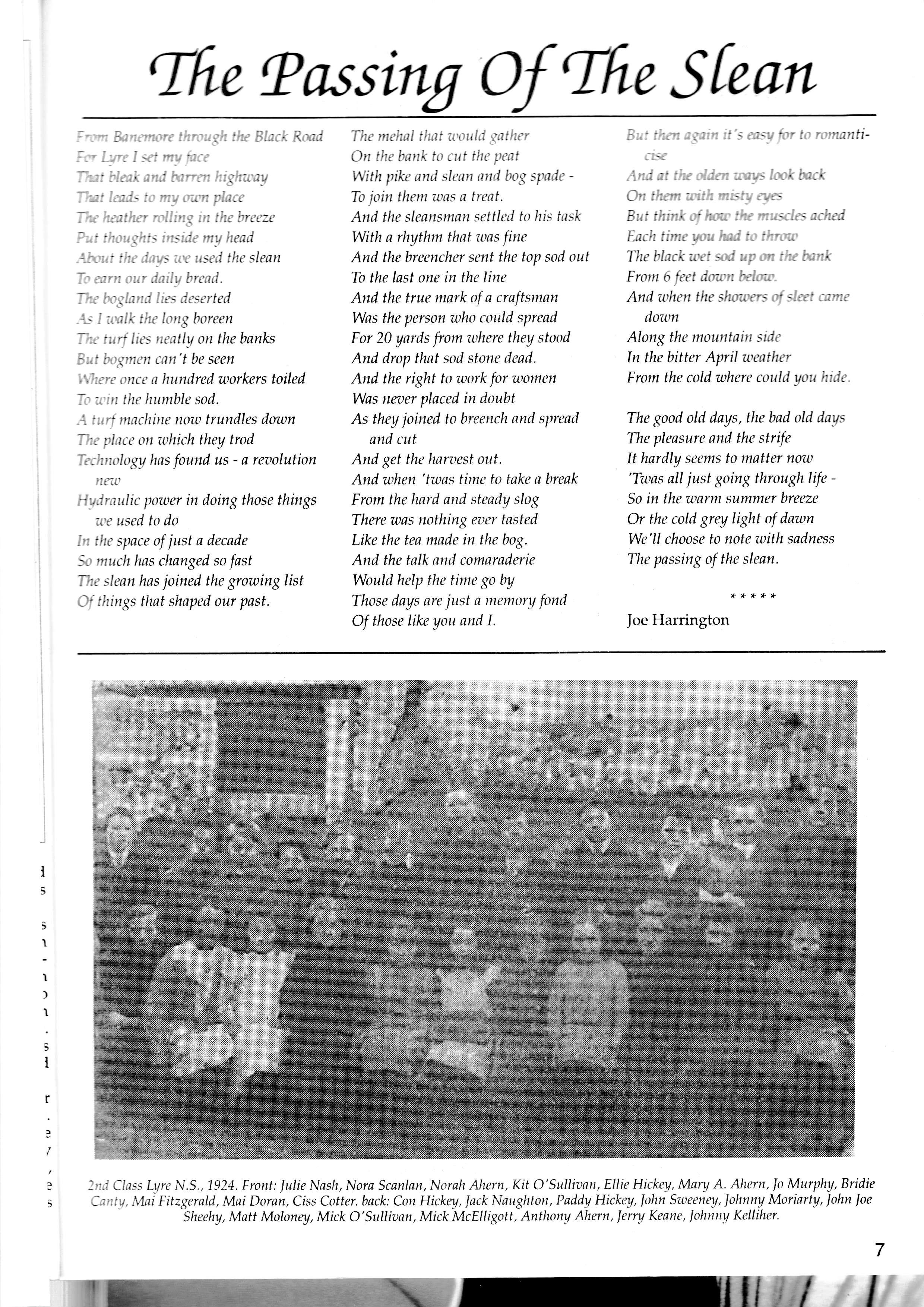
Hvrlraulic power in doing those things it'e used to do ln the space of just a decade
* much has changed so fast
The slean has joined the growing list Of things that shaped our past.
And the sleansman settled to his task With a rhythm that was t'ine And the breencher sent the top sod out
To the last one in the line
And the true mark of a craftsman Was the person ruho could spread
For 2A yards t'rom where they stood
And drop that sod stone dead.
And the right to work t'or women Was neaer placed in doubt As they joined to breench and spread and cut
And get the haruest out.
And when 'twas time to take a break From the hard and steady slog There was nothing eaer tasted Like the tea made in tlrc bog. And the talk and comqraderie Would help the time go by Those days are just a memory fond Of those like you and L
: - t_. -.:' i L;.
Frottt t t,','; .;, : AttLl icltttt liJa -.i:...,.,.. - - : r,... doit,tt Aktng tlrt ntotortr.n! j:.i.
In the bitter A1n.il irenr):;, F'rom the cold ttlrcrc cott/,J vo:r ,::,;.'.
The good old days, the bad 0lt1 tinus
The Ttleastrre nnd the strit'e
It hardly stt(:ms t0 tnstter nou, 'Tu,gs sll jtrst going through lit'e So in the ulonn sufltmer hreeze
Or the cold grey light of dawn Wc'll choose to note utith sadness 7'1rc po:sitrg of tlr:l,on.
|oe Harrington
S I r -':.r.l.rssLl/rr,N.S.,79?.1,Front:liieNnsh,NoraScanlnn,NorahAhem,KitO'Sullfnrt,EllieHickni,MnryA.Ahcrn,loMurplnl,Bridie: ..:'t ,
Jl,ti
F
itzgerLtltl, Mai Doran, Ciss Cotter. back: Cotr Hickey, lack Naughtorr , Paddy Hickeu, lohn Siuetnnl, Johnny Mariarty, John loe Shcehy, Matt Molonev, Mick O'sulliuan, Mick McElligott, Attthortlt Ahern, Jerrq Kennc,lolumtl Kelliher.
7trtlI I
IOHN I. SHEEDY
A man from the Lyre district sPent 27 years in Sing Sing Prison. However,Iohn J. Sheehy who was born in Dromada More, was never sentenced to serve a day. The six foot four inch, 22 stone giant was, in fact, the Principal Keeper of that infamous institution from 1926 to 1941.
Iohn I. Sheehy left Ireland as a youth and went to New York where he became a prison guard at Great Meadow Prison in Comstock in 1913. A year later he was transferred to Sing Sing where he moved up the ladder to Sergeant of the Prison Guard in 1918, Assistant Keeper in 1920 and Principal Keeper in 7926.In his years at Sing Sing he is estimated to have met over 31,000 prisoners and officiated at 300 executions - a task he apparently hated. Among those unforhrnates in the latter category were some notorious criminals from the gangster era such as Francis (TwoGun) Crowley. Women were among those he accompanied on "the last mile". The best known were Ruth Snyder, Mrs. Eva Coo, Mrs. Anna Antonio and Mary Creighton.
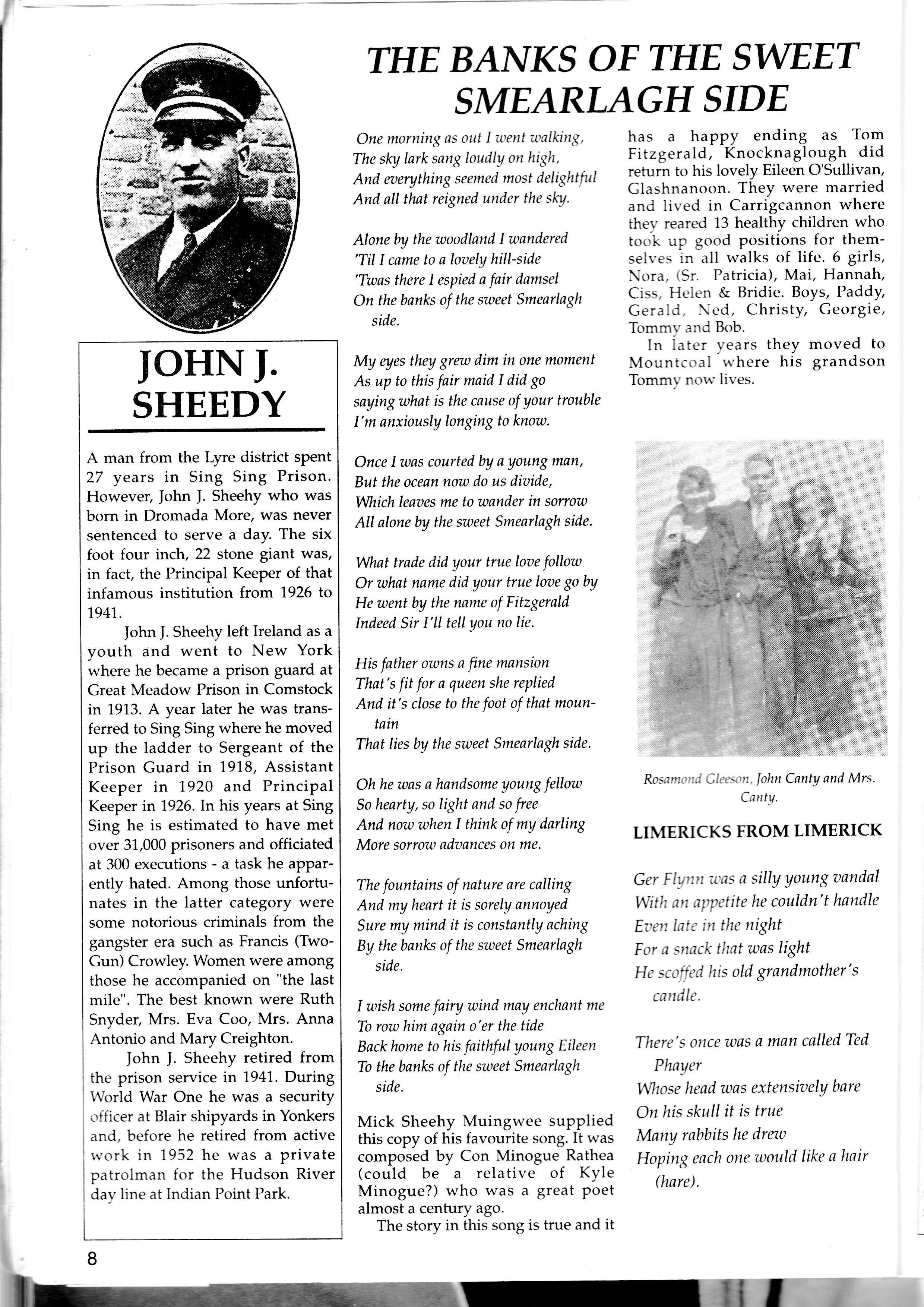
Iohn I. Sheehy retired from the prison service in 1941. During World War One he was a security officer at Blair shipyards in Yonkers and, before he retired from active work in 1952 he was a private patrolman for the Hudson River dav line at Indian Point Park.
THE BANI(S OF THE SWEET SMEARLAGH SIDE
One morning as out I utent walking, has a happy ending as- Tom The sley larkiang loudly on high, Fitzgerald, Knocknaglou^gh.- did And nerything seemed most iaigtrtJrt :",T* to his lovely Eileen o'sullivan' And ail tLat reigned ""ii,i",'r,"'fi,."'-' :jfilxylx Jl:,!.:;f"rffi::t thev reared 13 healthy children who Alone by the woodland I wandered took up good positions for them'Til I came to a loaely hilt-side selves in all walks of life. 6 girls, 'Twas there I espied-a fair damsel Nora, (Sr' Patricia), Mai, Hannah' On the hanks of the sweet Smearlagh Ciss' Helen & Bridie' Boys' Paddy' side. -'""'-""'-of"T*i'"")"*o.ct"i"tv' Georgie'
In iater Years theY moved to My eyes they gran dim in one moment Mountcoal where his grandson As up to this fair maid I did go Tommv nor+'lives. saying what is the cause of your trouble I'm anxiously longing to know.
Once I was courted by a young man, But the ocean nou) do us diaide, Whichleaaes me to wander in sorrout All alone by the *teet Smearlagh side
What trade did your true loae follow Or what name did your true loae go bY He went by the name of Fitzgerald lndeed Sir l'll tell you no lie.
His father owns a fine mansion That's fit t'or a queen she replied And it's close to the t'oot of that mountain That lies by tlrc xoeet Smearlagh side.
Oh he was a handsome young fellow So hearty, so light and so free And now when I think of my darling More sorrow adoances on me.
The fountains of nature are calling And my heart it is sorely annoyed Sttre my mind it is cttnstantly aching
By the banks ot' the sweet Smearlagh side.
I u,ish some fairy wind may enchant tne To rou him again o'er the tide Backhome to his t'nitht'ul young Eileen Tb the banks ot' the xtteet Smearlaglt side.
Mick Sheehy Muingu,ee supplied this copy of his favourite song. It n'as composed by Con Minogue Rathea (could be a rela tive of Kr'1e Minogue?) who was a great poet almost a century ago.
The story in this song is true and it
LINTERICKS FROM LIMERICK
Ger Flynn was a sillY Young ztandal
With an arytite he couldn't handle Eoen late in the night
For a snack that was light He scoffed his old Srandmother's candle.
There's once was a man called Ted Phayer
Whose head was extensioelY bare
On his skull it is true Many rabbits he drew Hoping each one would like a hair (hare).
Rwmonil Glemn,lohn Canty and Mrs CantY.
8
BORD NA MONA IN LYRE
MATT
DITLANE'S VISION
On a rvarm August day in or about the, year 1908, Matt Dillane from Glountane w'alked down from his home to Listou,el and back again, a round trip of about 22 miles. \\'hen abciut a mile from home on his return journer,', l-re left the road and entered Quilis mountain to take the short cut. l\Ihen he rvas a half mile on his u'a\,, he sat dorvn to take a rest. He fell asleep. He was awakened bv noise and on opening his eyes he saw men around him n,orking. He saw houses, and he saw what made the biggest impression of all on him - a railway train complete with wagons. When telling his story afterwards which he did nearly every day of his life, he laid most emphasis on the train. Naturally, nobody believed him, least of all his own family. But he told his story so often and so earnestly that people began to think there might be something in it. Years passed. A new generation qrew up and heard the strange tale, for indeed it was often recalled at tire winter fireside. Matt died about i6 or 17 years after his experience, but, still the story continued to be :.rld from time to time. Then came rhe year 1938, and we all w,oke up :o the fact that what Matt sau, in a i'ision on that sunny August evening thirty odd years before, ',\-as now there in reality. For where re had sat down to rest r4/as notrv :he headquarters of Lyreacrompane 3ord na Mona Works. Men were ',iorking there, there were buildings :here; a forge where machinery was ::paired, an office and a store. And :-',:re was a railway train running r. tracks, just as it should be. It was .r f.rct, a diesel locomotive pulling :-.iLlrteen wagons of turf to the road-l:].: tt deliverY to the w4iting lor-
Lyreacrompane Bog rvas first der-eloped by Bord na Mona in 1937 in a major drive bv the De \ alera sovernment to develop Lrur natural resources, and create \\'Lrrk at hrrlT.e
Three l.rnd ho1.1ings r..-ilh an acreage of t,5i-' acres \';L're bouihi :n 1937 for 10 - ar acre a ra:..: ir:ri ttrdav L\':I: :. Tr.. ::l.l ] :t'..r. emli..r'e,i at Lr re ,.r'erc Trm Su.1i,,':r. R.l P. Jer \auqh:..r'l R i ? an.i iack \aughton. Drarnrng and leveliinq rr'hich rr'as all .1r.ne l.r' hand ttrok place in 193f, and the first harrest rvas saved that summer. Three cottages rvere also built that year by BNM for senior management near the plant.
Most of the machinery used for harvesting of turf was imported from Germany, a few Germans worked for a number of years at Lyre to instruct the locals in the operation and rnaintenance of the machines.
Up to 30 full time workers were employed at Lyre on a year round basis. At the height of production in the 1940s and 50s during the months of harvest up to 500 people, including whole families were employed. An area of turf called "a floor" would be marked out and a man or a group would foot it for a fee of 5 / - in 793740. |ack Naughton informs me that it would take a good man at full throttle 8 hours to complete a floor.
For the full time workers, cutting season meant round the clock work on 8 hour shifts. For their labours full time workers were paid E1-8-7d (minus Social Welfare stamp). In off peak time the workers put in a five and a half day week (half day Saturday) and from 8 o'clock in the morning, until 5.30, with only one break of half an hour. The wifes or mammies lunch would be supplemented by a cup of tea (price 3d a mug) provided by Nelius Nolans father, Billy, who had a small shop at the entrance to the bog.
Another feature of the summer in Lyre in the 40s and 50s was the number of travelling families from all over Kerry who camped in the vicinity of the bog with their colourful caravans and cars, and rvere emploved saving turf.
It became very difficult to recruit workers locally in the 1950s and lorries were sent daily to collect men from ail over the country, e"'en
Before the advent of a collection machine, the dry turf had to be carried in baskets on a persons back from the bog, up a timber plank and ir'as emptied into a rail car. This was :ack hreakins u-crrk n'hich was paid':r' !e::..rmdncc.. IS it surprising so ::'.a:.,, ',., "r: :.r ErrEI.lncl rt'here work lr ::;1.-rles :nJ on t,uilcling sites ,.r':s 'Ct::.:i ::ij. LVre bog had apprtr\ ^ ' rn;it. .ri rail tr..rck n'ith one. and itrr a trnre l. Irrctr: ttt pull the rr'agons ttr fhe lip hea.1.
The rr.ar \.ears ( l9lC_lr ) gar-e Lyre a national as rr-ell as a li,cal importance. The Armr- Constructir-rn Corps (men who rvere totr voltnq for the army) were sent to ensure that production of the vital turf supplv was not interrupted. Manv private bogs were also opened up at this time in the area.
The large young population and the importance of BNM to the area can be seen from the fact that in the 1950s Lyre and its environs could field 4 teams for the Healy Cup. Contrast that with the situation today!
The social and economic poverty of the 40s and 50s was devastating for Lyre and earned BNM the definition "a place or state of punishment where some workers suffer for a time before they go to England. Those who stayed in Lyre on small farms were provided with mucl', needed financial supplement by BNM.
Experiments were carried orlt on the cut away bog by Comhiacht Siucra Eireann in the 7960s, to see if sugar beet would grow there. The experiment did not prove verv productive and was discontinued. Trees later planted on the area limed for beet grew very well.
Although BNM has gone from Lyre the private production and sale of turf is stiil a verv important part of the local economv.
BNM and thi traditions that EIrew up around it has left an impression not alone on people in Lyre, but also on their children who settled all over the u'orld.
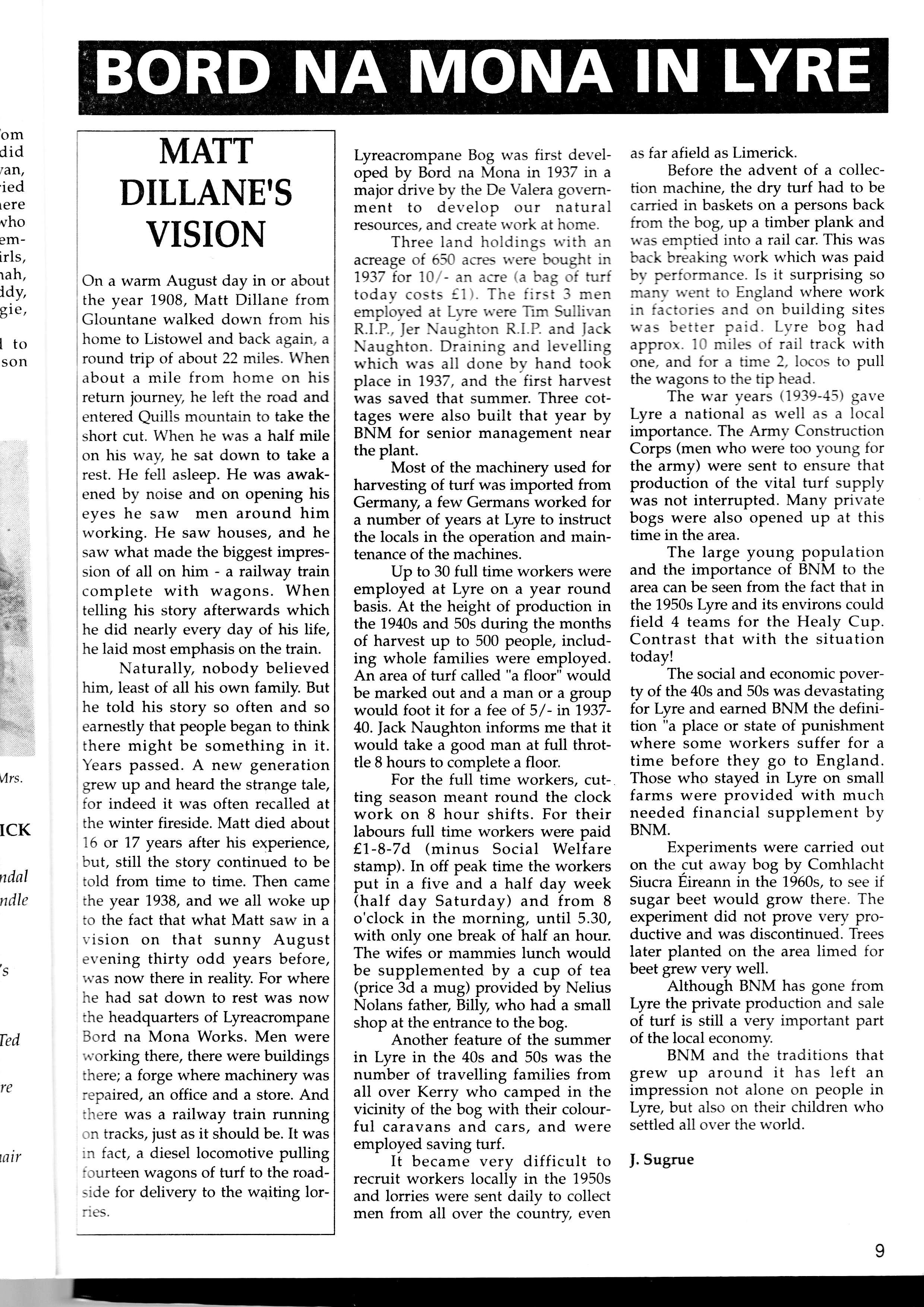
]. Sugrue
as far afield as Limerick.
I
' i,.:{ ,,:
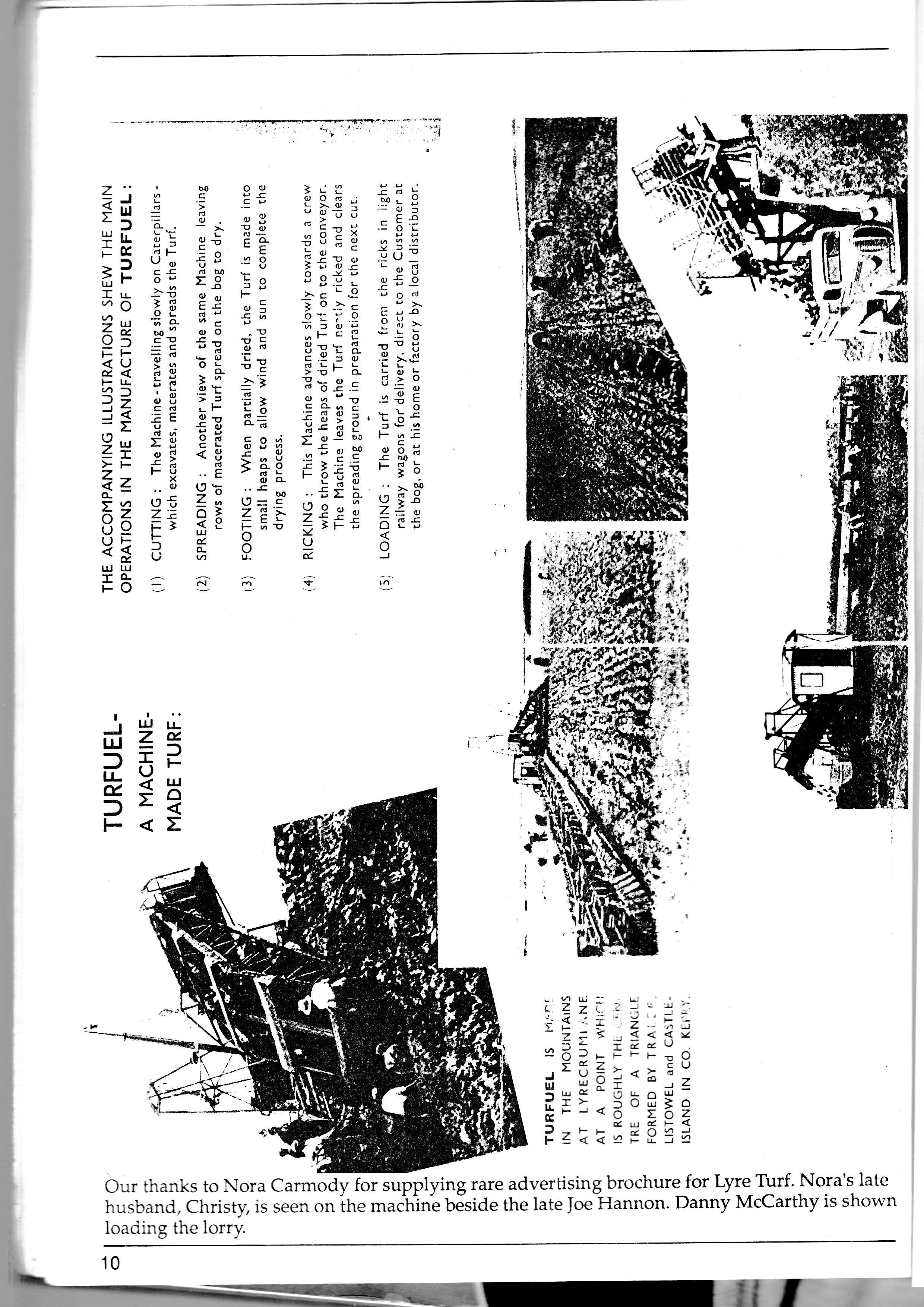
ji 't' *i. t idr :Hi s ${ - eE; o E- e .9 b'cii:: t j: 5eotEL..6 e si I st-E >.c -J P o di{is E;I-F c f +.! 6 EI: F E:i d LL L L Li;: I E: Bze.iz =! E F*i *'Ef ; ri;*" s F; -E.E E ..^16 g 't f 9:;lrf 5 o r€!24 9o d.J go booo, .= c-J 3 o,9 -\-l,oL d-9rr E I5s .=[dbo =3 :9 9or F-;: +;(, o -'t,5; E E s t L-oL'o! ;; ==';.; .E I L- L O+E 3= oa6 co"i CLa;jq <g s-g .. E 5 *gt4ofl. E ;Y o "- Mt g (9=.cor zP>< I tr;;pa (LO vlL oo L g '6o= dlu'o CS OP >€ >6 6E 7 CL u c! -do ig 
The first manager at Lyre Bog !{as a Mr. Switzer. Other managers rncluded Casey Connolly dnd Coote.
Tres Bocs oF LyREACRoIVTpANE
O)I Lt1,g t; r1,7i7,11 1; a Lv r c,t c r cr rl y,,1, 1,' L7o;t'oit I dreant oi thee And of the days ithen by Smearlagh shore
I wandered young and free How ot't on top of the Branner Hill At sunny morn I'ae stood And looked at Bogachnamalaaogue And thought it was no good At the rolling bogs and mountain tops
Spread plainly to isiew From Gloundearrg Bridge to Queenstown And to distant Booaaore From Poulcocadha to Knocknagloc From Cloghboola to Claunthain Stretch fifty thousand acres ot' bogland in Lyreacrompane.
So we'll gather a mighty army An army of dolemen They'll eastwards hail t'rom Abbeyfeale and westwards t'rom Kilflynn They'll northwards come t'rom Ballydut'f, Kilmore and Liscullane And we'll bring 'em down t'rom Reanagown
To the bogs of Lyreacrompane.
Little I thought in days of yore I neaer had such a notion That an lrish brigade of dolemen Would work in that boggy ocean With the lark high oaerhead And the quagmirc quiaering 'neath them
And four feet zuide and four toltnt'eet loe Sheehy and Mick Edgeworth
drrp
The drains theu'll sink, God speed them
And twenty thousand porurds we'll pitch lnto that oast boghole
And who deserves to get it lik us The army on the dole.
We'll sing a song as we'll mnrch along
With spade and pike and slean And we won't be "bate" (beat) But we'll rise a "hate" (heat) ln the bogs of Lyreacrompane.
Early euery morning
A large army you will see In columns and company's marching lnto that boggy sea.
And dozon into ottr trenches
Like true soldiers we will go And like heraes braae u:e'll start our work
To assault our boggy foe
Each man will haae a lit'ebelt We'll furue many a submsrine
The Red Cross cars at Glatnthiar. Cross
Will take the wounded off the SCCNC
And we'll fight t'or Ireland on that front
With pitch t'ork and Griffaun Abasinia has nothing worse Tlnn the bogs of Lyreacroffipane
We'll gather a mighty army
Our gallant brsue commander there
You usk me whence contes he From the green plains ot' Roscommon
Comes our hratte lames Hen-a-ry (Henry)
As our army school of music We haae Denis Daly here
He plays the second iiddle to ct German engineer
T'hat's Crazy Corl Gutheim
Sure you fieller sau the like
Of all the looney things he does
On the saddle of a bike
Patrick Buckley he'll be there
Count Plunket is the msr.
IMo stormed Brosnct Borrocks in the year of '21
And we haae the Papil Blessing too
Though nat t'ram Rcme its drttit,rt Far Paddy the Po1te gets pleniv scope
Itr the bogs ot' Lureacronrytortt. We'll gather a nriglttit orinr
GERMANS IN
lohn loe Buckley, drioer of the turf collector in Bord na Mona t'or many years, Christy C-trmody, machine driaer, Mickey Doran and Mick Sheehy, postman, tenor, gambler anil comedian at the Four Elms.
I 11 / /
Workers at Lyre Bog in October 1956.
Front (L. to R.): Sonny Nolan,Tim Cronin,lim Naughton,ler Callaghan,lohn Morrissey, Christa Harrington, Con Walker. Centre (L. to R): Paul Fitzmaurice,lack Buckley,lohn Keane, Pat Starken,lohn Shanahan, Pat Doodv, llillie Quirke, Brendan McKenna Back (L. to R.): Ned Somers,lohn Costelloe,ler Shanahan,lohn Naughton, Michael McKenna and Pat Kelly. (Photo. courtestv "The Kerryman").
THE MACHINE
The follouting desuiption of the loolkings of the turf cutting machine is from the thesis, Lyreauompane, My Natiae Place,by I.l. Sheehy.
The turf-cutting machine known as the bagges scraped up the raw bog into a revolving container, called the maceratos, then with the aid of a screw type implement it pushed it on through a chute, at the end of which the'column of bog was divided into two parts by means of a stationary vertical knife.
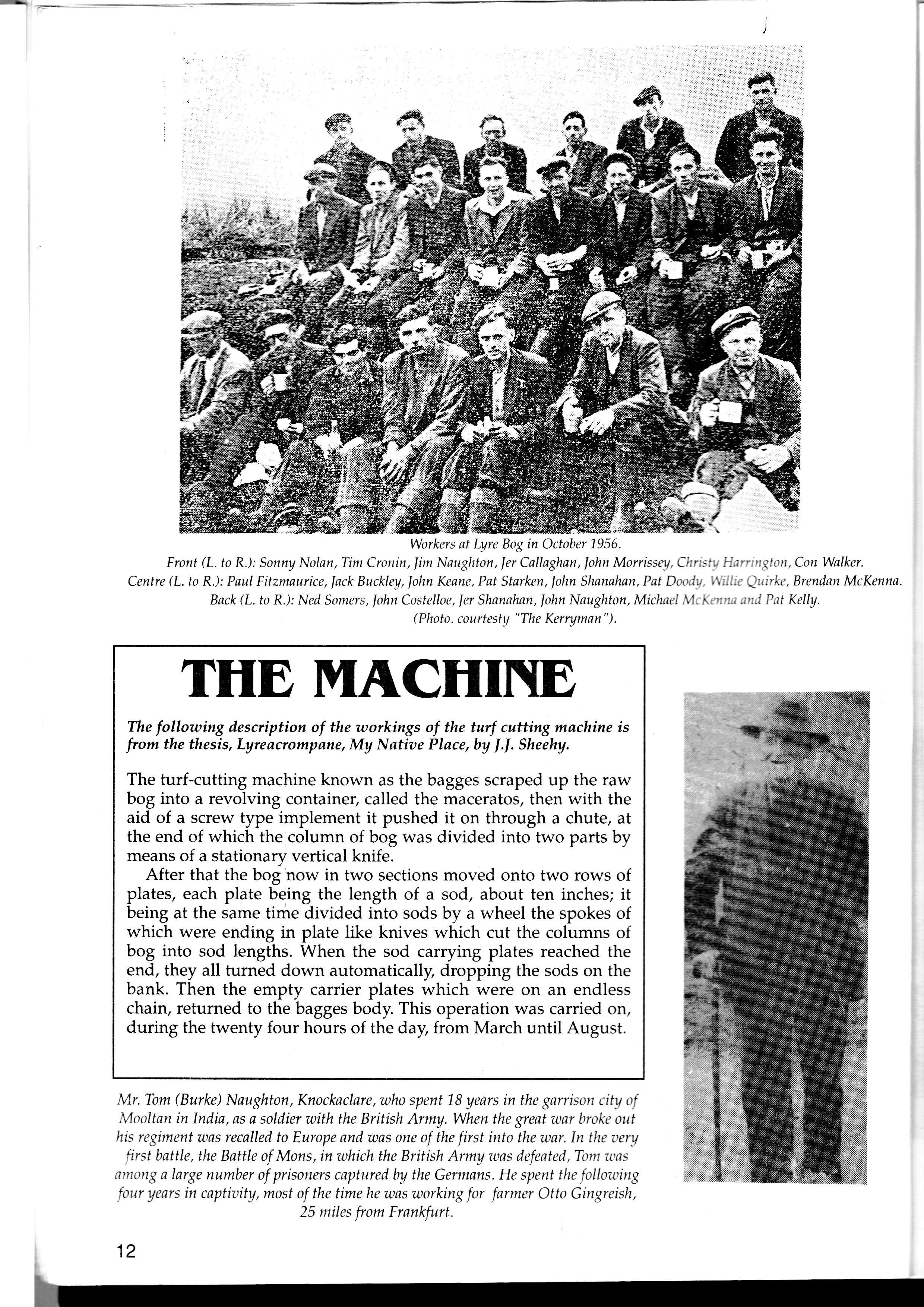
After that the bog'now in two sections moved onto two rows of plates, each plate being the length of a sod, about ten inches; it being at the same time divided into sods by a wheel the spokes of which were ending in plate like knives which cut the columns of bog into sod lengths. When the sod carrying plates reached the end, they all turned down automatically, dropping the sods on the bank. Then the empty carrier plates which were on an endless chain, returned to the bagges body. This operation was carried on, during the twenty four hours of the day, from March until August.
Mr. Tom (Burke) Naughton, Knockaclare, who spent 18 years in the garrison city of Mooltan in India, as a soldier zoith the British Army. When the great war broke out his regiment was recalled to Europe and was one of the t'irst into the war.ln the uery ftrst battle, the Battle of Mons, in which the British Army was defeated,Tom ttas among a large number of prisoners captured by the Germans. He spent the t'ollowing four years in captioity, most ot' the time he zuas working for farmer Otto Gingreish, 25 miles t'rom Frankfurt.
12 ) : ::,: :' :! r:
A Mountain of Turt
Approximatelv 250,t)00 torrs of sod peat rvas produced by Bord na Mona in Lr,'re Bog betrr'een I't3S and 1963. The annual output rvas about 10,000 tons. In 7964 the cut-away bog was transierred for plantinr ttr the Forestry Dept.
In 1958 Bord na lvlona began turf production on approximately 250 acres at Carrigcannon. In the earlr bl.ls the annual output rvas about 4,000 tons. Afterwards this levelled off at 3,000 tons. The number emploved at Carrigcannon varied n,ith the time of the year from 10 to 15.
Reproduced beior,r, is an extract from the accounts of the Turf Development Board for the year endine March 31,7945.
ACCOUNTS FOR YEAR ENDED MARCH
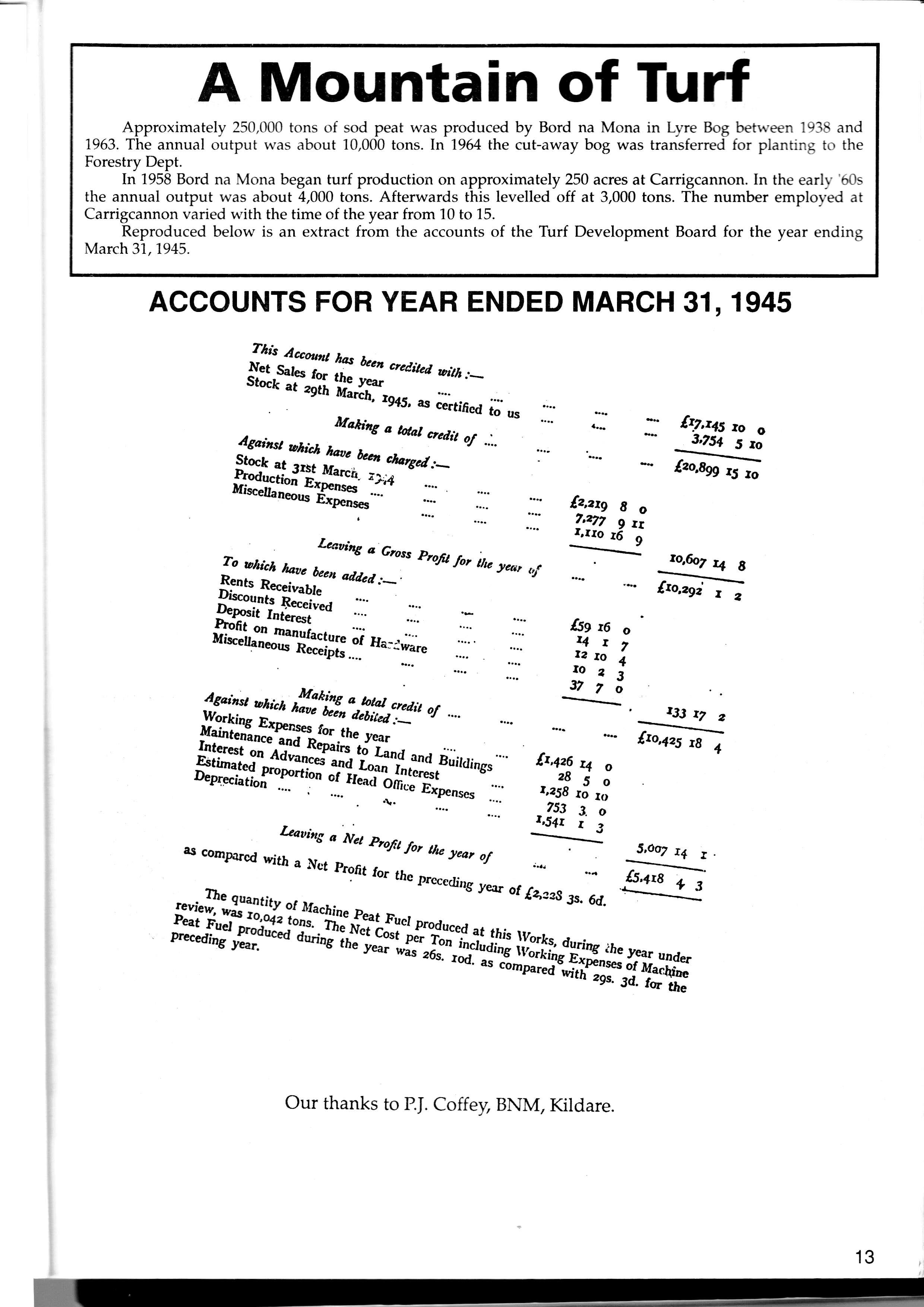
31 , 1945 roo 5ro 15 ro 8 2 Our thanks to P.J. Coffer,, BNM, Kildare. 13 29s. 3il. tor tie
TRAVELLERS FOOTING THE TURF INBNM
A "floor" of turf consisted of 32,000 sods which had to be lifted and placed 2 on2, four rows high with one on top a total of 9 altogqther. This method of footing was different from the local practice of placing the sods in roughly a pyramid shape. This method required a certain degree of skill and dexterity, and was required to ensure that the slean turf would dry. The machine turf was more compressed in its manufacture and therefore easier to "save". This lent itself to the horizontal "foot". The time required to "foot" a floor of turf varied according to who you ipeak to and like the fish that got away, improves with each telling.
The work was often carried out by the whole family with children joining parents after school. Not all "floors" were equal, some being dryer or on better ground than others. Regardless, the job required that 484 foots be made per hour. This involved handling over 60 sods per minute or one per second.
The work was back breaking and the black turf would rip the less weather-beaten hands, but payment was by the "floor" so it was up to each worker to sef his or her own pace.
Footing the turf was labour intensive and an unusual aspect was the influx of travellers each year to avail of the plentiful work. A verse written by John foe Sheehy sums up the relationship that existed between this migrant workforce and local people
The tinkers are footing
The times they are great
They're camped by the riaer on Paddy's estate. And old Charlie remarked as he pawed at the ground
The "bate" of the Lyre people Cannot be found.
The neighbours so t'riendly Inaite us to call
The deuil a refusal ute meet with at all And be sure t'utont be long 'Till you'll come the next time
As sure as my name is bold Chnrlie O'Brien. A bit of tobacco or eaen a t'ag Or an old boiled potato to stuff in my bag Or a sup of su,eet milk you don't need for the calf And Charlie moltes on With his step and a half
Perhaps even more back breaking than turf footing was work on the Collector. This machine was really a long conveyor belt stretching across the full width of the turf bank. It was then driven forward as 9 people lifted the sod "foots" and threw them into the collector. The belts continuously conveyed the turf to one side when it fell off to make one long reek about 7 feet high and 9 feet wide beside the loco tracks.
Later the reeks were "slated". This was done by overlapping the outside sods in the manner that a roof is tiled. The turf was then filled into the loco wagons and brought to the "tip" rvhere it rvas tipped into waiting lorries.
One of the biggest sources of discontent at the "Bord" was the speed of the Collector. The machine was the focal point of manv a disagreement and there are many accounts of workers taking direct action to slow the all-engulfing monster.
Dan Canty and Fr. Ka,in Sheehy (1979). The district was saddened recently on hearing of the unexpected death in Nigeria of Fr. Keain. Fr. Sheehy u,as bonr in Clahane on lanuary 30,1934 youngest sorr of the late Edmond and Mrs. Harunh Sheehy, ex N.T. He was ordained in Rome in 1958 and went to Nigeria in 1959. He administered for many years with the late Bishop Cotter,late of Abbeyt'eale.
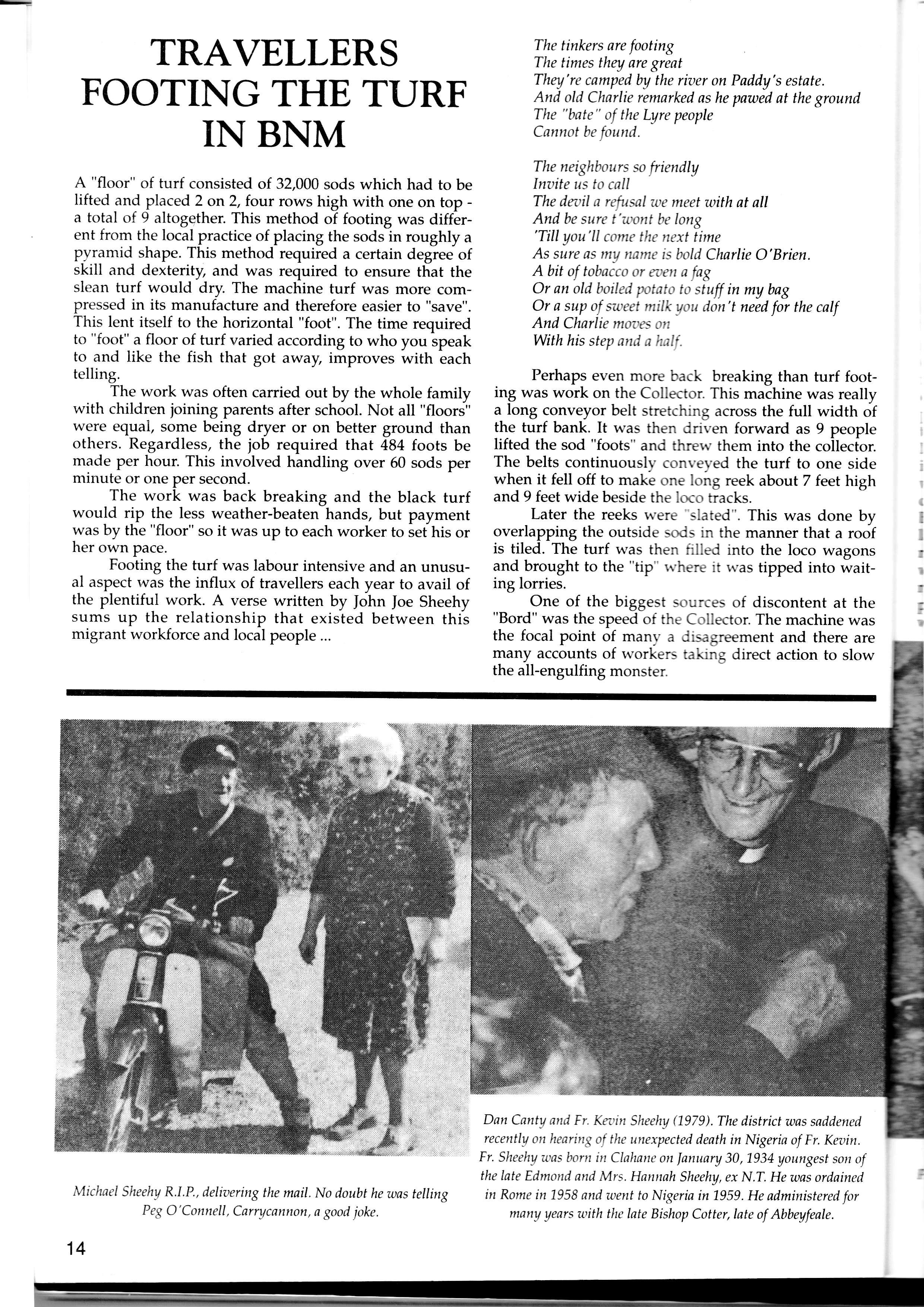 Michael Sheehy R.LP., deliuering the mail. No doubt he was telling Peg O'Connell, Carrycannon, a good joke.
Michael Sheehy R.LP., deliuering the mail. No doubt he was telling Peg O'Connell, Carrycannon, a good joke.
14
TOWARDS the end of lantary,1921, unusual activity on the part of the Crown Forces was observed in Listowel. Several lorries and armoured cars carrying Auxiliaries, Black-and-Tans and Military, had moved into the town, and, as many officers of the "Murder Gang" were noticed amongst the enemy, it was obvious that an offensive was planned. In charge of the British was the notorious Auxiliary Commande1 Major McKinnon, who had been implicated in many shootings, and who later paid the penalty for his crimes on the Tralee Golf Links. Our Battalion O/C at that time was the late Bob McElligott (R.t.P.), a most resourceful officer to whose alertness we owed our lives that night. Bob received early information that the purpose of the enemy concentration was to wipe out the North Kerry
Column, then billeted at Derk, some miles from Duagh. He immediately gave orders to a capable despatch rider to take us news of the attempted round-up. This was a most difficult task; yet, in spite of the fact that all roads round Listowel were closely watched, the scout succeeded in getting through and ultimately reaching Duagh the same night, which was wild, wet and stormy. There he contacted the Captain of the Duagh Company, and a Column Officer who had just crossed the River Feale with ammunition. All hurried on to Derk, where a consultation was held by the various Column leaders.
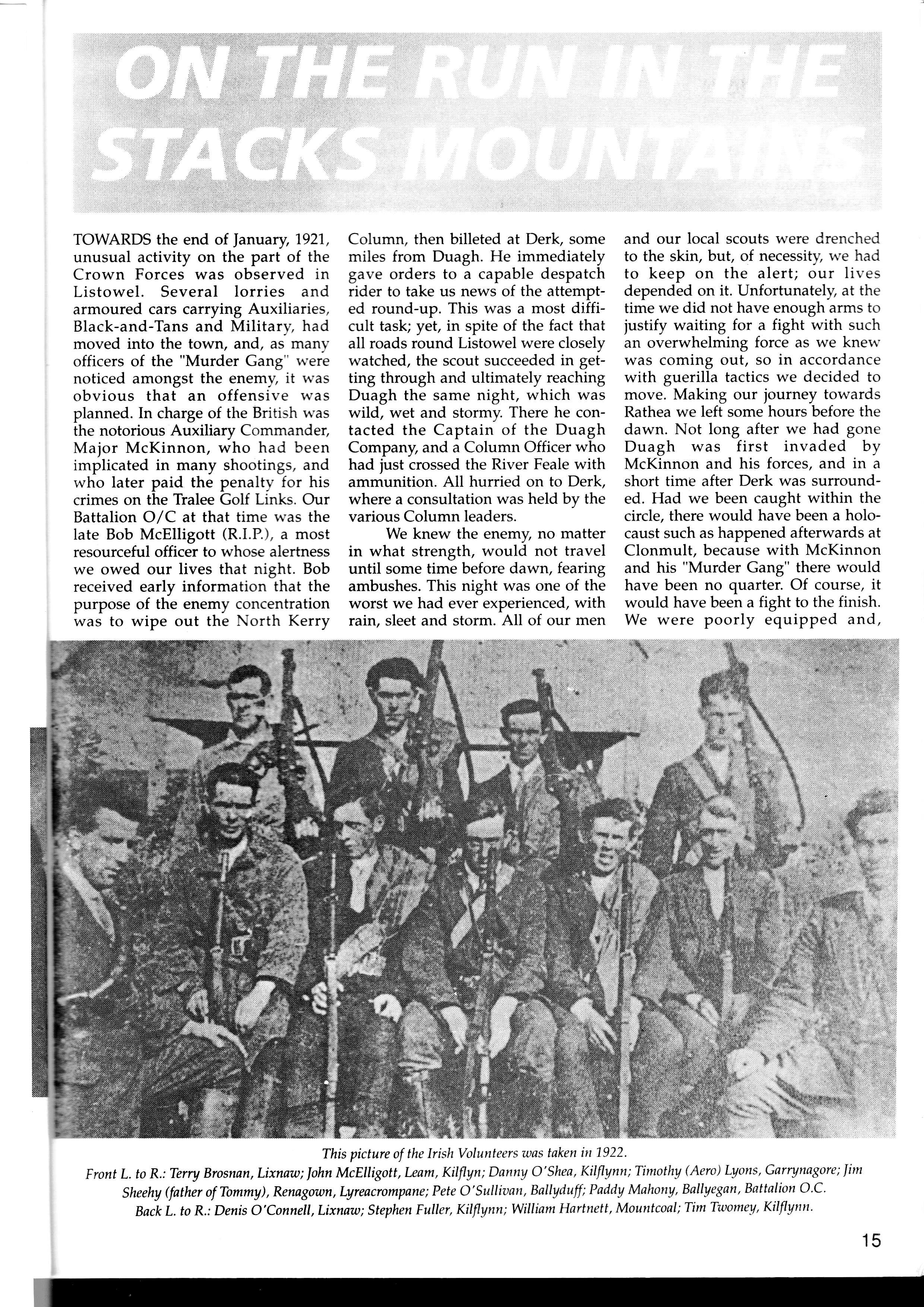
We knew the enemy, no matter in what strength, would not travel until some time before dawn, fearing ambushes. This night was one of the worst we had ever experienced, with rain, sleet and storm. All of our men
and our local scouts were drenched to the skin, but, of necessity, we had to keep on the alert; our lives depended on it. Unfortunately, at the time we did not have enough arms to iustify waiting for a fight with such an overwhelming force as we knew was coming out, so in accordance with guerilla tactics we decided to move. Making our journey towards Rathea we left some hours before the dawn. Not long after we had gone Duagh was first invaded by McKinnon and his forces, and in a short time after Derk was surrounded. Had we been caught within the circle, there would have been a holocaust such as happened afterwards at Clonmult, because with McKinnon and his "Murder Gang" there would have been no quarter. Of course, it would have been a fight to the finish. We were poorly equipped and,
This picture of the lrislt Volunteers was taken in 7922.
Front L. to R.: Terry Brosnan, Lixnata; lohn McElligott, Leam, Kilflyn;Danny O'Shea, Kilflynn;Timotlnl (Aerc) Lyons, Carrynagore; lirn Sheehy $ather ot'Tommy), Renagown, Lyreacrompane;Pete O'sulliunn, Bailytluff; Padtly Mahortrl, Ballyegan, tsattalion O'C'
Back L. to R.: Denis O'Connell, Lixnaw; Stephen Fuller, Kitflvnn; William llartnett, Motttrtcoal;Tim Ttuomev' Kilflynn'
15
though hand-to-hand fighting would have suited us and we would have inflicted several casualties, there could only have been one end, as we were heavily outnumbered.
Infuriated by our escape the Tans and Auxiliaries savagely beat up all the young men of the district, stabbing them with bayonets in the body, pulling their hair out with pincers. But their attempt to strike terror into people failed, their vicious savagery and wanton cruelty only serving to inflame the district into a more wonderful spirit of patriotism and, no matter what torture was inflicted at that or any other time, no information was given against us. The thanks of the Column men are due to all persons who ever helped us or who suffered on our account. In one district the only son of a poor old woman was savagely beaten and knocked insensible before her eyes. She herself was then threatened with murder, but still she would not let the enemy know even the direction in which our Column had gone. Pluckily she sneaked across country that night, herself, eluding the military scouts, to inform us of the raid. We could never have lost at this period, with such heroism, steadfastness and indifference to persecution exhibited by our people.
When we reached Rathea we were exhausted, hungry, cold and drenched, but some good friends there put us right. About twelve o'clock on the following day we heard that two lorries of Black-andThns, some of the search party, were scouring round the district. This was our chance. We took up positions adjacent to Rathea Chapel. By using
shotguns, desperate weapons at close quarters, surprising and striking terror into our foes with the first volley, we should be able to capture the lorries with the arms and ammunition. All was ready and while we were waiting tensely there, hoping for success and listening intently for the purr of the motors, a girl scout cycled up with the information that an arrnoured car was also travelling with the lorries. Thus we were foiled again and had to decamp, as we had no equipment to engage the enemy's armour. Rathea was combed for us on the following day in the same savage manner as was Duagh, but we had gone to Stack's Mountain and thus the game continued.
Late the following night while we were at Stack's Mountain our scouts informed us that seeing lights on the edge of a bog they investigated the matter and discovered a large number of Auxiliaries and other forces had collected and that they feared an attempt would be made by them to comb the district. We got ready at once and travelled to a place which would be more advantageous for a fight if we were cornered. The "Auxies", however, fearful because of their lack of knowledge of the district and the lateness of the night, never ventured down, but departed to Tralee. On the following day we slipped down towards Lixnaw and outwitted our pursuers by crossing the river there, a trick we used with much success during subsequent activities.
During the search for us at Rathea and Stack's Mountain at the beginning of February, the Crown Forces covered a wide district.
Unfortunately, they captured Bob Browne of Fealesbridge who was on the run at Knockalougha. Though he ivas unarmed, they beat him savagelv, afterwards taking him down a bve-road into a bog where they murdered him, thus adding another tragic chapter to the story of a glorious Irish family who had already suffered enough. This was the history England leit behind her in our countn'; cri ruined homes, torture, imprisonment and murder. A fleeting, seemins victory gained by such methods could never survive when dealing ir-ith a proud people who had such a u'onderful tradition of fightin* and resistance to oppression.
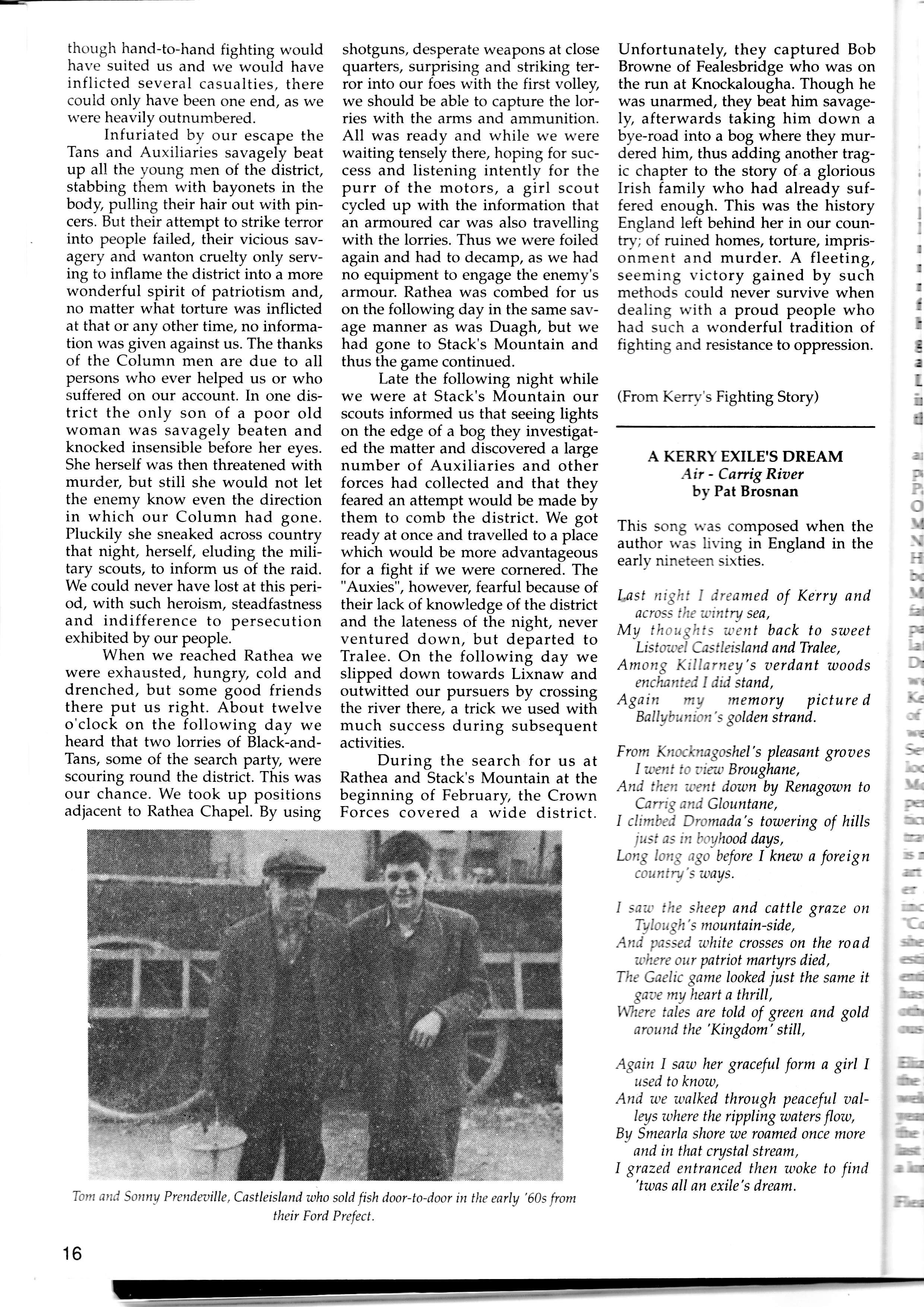 (From Kern's Fighting Story)
(From Kern's Fighting Story)
A KERRYEXILE'S DREAM Ah - Catig Rioer by Pat Brosnan
This song ivas composed when the author rvas living in England in the early nineteen sixties.
I*st night I dreamed of Kerry and across tlrc u,intry sea, My thoughts went back to suteet Listozrel C aqtleisland and Tralee, Among Killarney's oerdant woods mchanted I did stand,Again my memory picture d Ballybunion's golden strand.
From Knxkrwgoshel's pleasant groa e s I uvttt to viap Broughane, And thm u,mt ilown by Renagown to Ca^g and Glountane, I climbed Dromada's towering of hills just as in hoyhood days, Long long ago before I knew a foreign country's ways.
I sau, the sheep and cattle graze on Tylo u gh' s mountain-side, And passed white crosses on the road -rthere our patriot martyrs died, The Gaelic game looked just the same it gate my heart a thrill, Where tales are told of green and gold around the 'Kingdom' still,
Again I saw her graceful form a girl I used to know, And we walked through peaceful aalleys where the rippling waters flow, By Smearla shore we roamed once more and in that crystal stream, I grazed entranced then woke to t'ind 'twas all an exile's dream.
Tom and Sonny Prendeaille, Castleisland who sold fish door-to-door in the early '60s from their Ford Pret'ect.
16
There is little doubt that for an area of its size Lyre has produced many great and eminent p eople in various f ields. \aturally only a few can be named in an article of a general nature such as this, but one must never forget the great-hearted iine ordinary people behind the neadlines who seldom or ever qet mentioned. And in a way :lmost everyone who lived in Lvre in our time were each great :ndividuals and personalities in :heir own right.
Priests from the locality past .:,d present, some of them now .-,:ssed to their reward included: Fr. .:t O'Connor and Fr. Moss --' Connor, Fr. Roche, Fr. James .lcElligott, Fr. Danny Stack, Fr. John '. r-rlafl, Fr. Kevin Sheehy, Fr. :-iumphrey McMahon, New York , rrn late Fr. |ohn O'Connor, and .1.,nsignor |ames O'Connor whose '::her was a native of Knocknagoshel .-,:rish and whose mother was the .: l€ Mary Sheehy a native of :omadamore. These two priests tre first cousins of Mrs. Mary ' =ane Listowel (wife of Iohn B) and , lack Naughton, Glasnaree. They .re also second cousins of my own. ::', €rol nuns also grew uP in the ,ality with Sister Brigid (Bridie) I ..1oney of the Sisters of Charity .:::1nps being the best known, par-;larly because of her world-wide -.'. els and her writings. Sister Brigid - :,--rt alone a highly skilled artist and -: :eacher, but is also a prolific writ- ,:nd poet, some of her poems - -.uded "Sweet Smearla" and - rnie Brosnan's Forge". Recently . published a very full and inter-: : i book which she wrote herself': :,ed "Home on the Hill" and she . ,.iso written and edited several -.: books, publications and vari,::ticies.

Sister Brigid and her sister -,:reth who is also a member of , ::siers of Charity paid us a very , -. :1e visit during August of last , - ,: rvas also very nice meeting -.eeson sisters on one occasion - .;ir rvho are both in religion for : :lme as well.
luring the last All-Ireland : Cheoil in Listowel Sister
Eileen whom we used to know as Blondie Roche in her schooldays met me by chance, accompahied by her nephew Albert and looking very well.
Perhaps the best known Lyre personalityof our time was Dan Moloney a native of Carrigcannon who was a New Ireland Assurance agent and National Health official in his early days. Later he built up a thriving gara9e business in Listowel and also purchased for his home Gurtinard House the former residence of Lord Listowel. Dan entered public life in the late forties when he was elected as an Independent candidate to Listowel Urban Council. Later he joined Fianna Fail and was elected to Kerry County Council.
He contested a Dail by-election in North Kerry after the tragicdeath of Johnny O'Connor the Clann na Poblacta T.D. at the time, but was defeated in the attempt by |ohnny's daughter Kathleen.
In the 1957 general Election he headed the poll in North Kerry for Fianna Fail, but lost his seat in the next general election. Subsequently he became a member of Seanad Eireann, a position which he held until his sudden, sad and untimely death in Dublin during President Kennedy's visit in 1963.
Another Lyre man who has made it big in public life is |oeHarrington who now lives in Limerick City and who was elected to the City Council as a People's Democracy candidate. A Socialist newspaper "The Bottom Dog" of which he was editor, had a big readership there.
Dan O'Sullivan of Renagown who was better known as Dan PaddY Andy was the owner of the famous dance hall in that townland and a man of many parts, who incidentallY did his share for Ireland during the
War of Independence and the Civil War.
He attained a measure of fame that would be impossible to estimate mainly through the books and writings about his life and times by |ohn B. Keane, but sadly enough most of the recognition has come posthumously as is the case with so many other great men and women. Many local heroes emerged during the period of the Black and Tan and Civil Wars, but it would be unfair to all those who took part to pick out any of them for special mention here.
There were also many Lyre men who served in the Army, the Local Defence Force and the Local Security Force during the Emergency and they too deserve to be remembered for their commitment to the service of their country.
In another sphere one of our schoolmates Brother ChristoPher Kieran (Walter O'Connor) of the De La Salle Order who died a few years ago at a comparatively earlY age, became well-known for his dedica-
t
Ned and Catherine Gabin, Braumadilra
17 I
tion to sport and youth work during his many years in religion.
On the cultural side we had many great musicians in the locality, accordian players like the late Dan Canty and the late Ebbie Somers, Tom Doran, Paddy Doran, Patsy O"Sullivan, Pa Jo Aherne, the late Pat Lyons of Renagown and Mikey Lyons of Dromada. There were some fine fiddle players like the late ]erryLong, Jerry O'Connell, ]oseph Aherne who was also a singel, and Bill McKenna. The latter's son Billy, is also a well known tin whistle and concert flute player of the present generation.
Members of our own family were all singers and some were musicians as well. Tim and Dan and one of our nephews ]ohn, are all well-known and accomplished accordian players. Sean who has lived in New York for over thirty years is a singer and accordian pl4yer. My younger brother, Ando, often played music, step-danced, sang a4d recited at concerts with us and often did parts in plays as well, while Con and his two daughters Kathleen and Sheila also used to sing at concerts. For as long as we can remember the old family home in Dromada was never without an accordian. Another nephew, Tim's son Neilus is wellknown in North Kerry as a musician, singer and songwriter. Tim's youngest daughter, Mary (Ned Murphy's wife) who lives in Lyre is a champion stepdancer and wellknown dancing adjudicator. Other outstanding performers of the past included stepdancers Tom and Andy Sweeney of Lyre. Andy's daughter Peggie of Rathea became an AllIreland singing champion.
The late Tommy Hickey of Knockanebrack was also a fine stepdancer and so was Darby Naughton
who lived in Bromadra before he emigrated.
Perhaps the most versatile local singer of the forties was the late Mick O'Donoghue formerly of Bromadra, and he was also a good mouth organ player.
Other prominent local singers much in demand at house dances, concerts and parties included Moll Carey, |immy Roche and Charlie Collins of Carrigcannon/ Michael McMahon and Tommy Sheehy of Renagown, jack and Brendan McKenna of Glasnanoon, fohnny Reidy of Broughane, Tom Aherne of Knighsmountain, Nora O'Leary of Dromadamore and the late |im Cronin formerly of Dromadabeg.
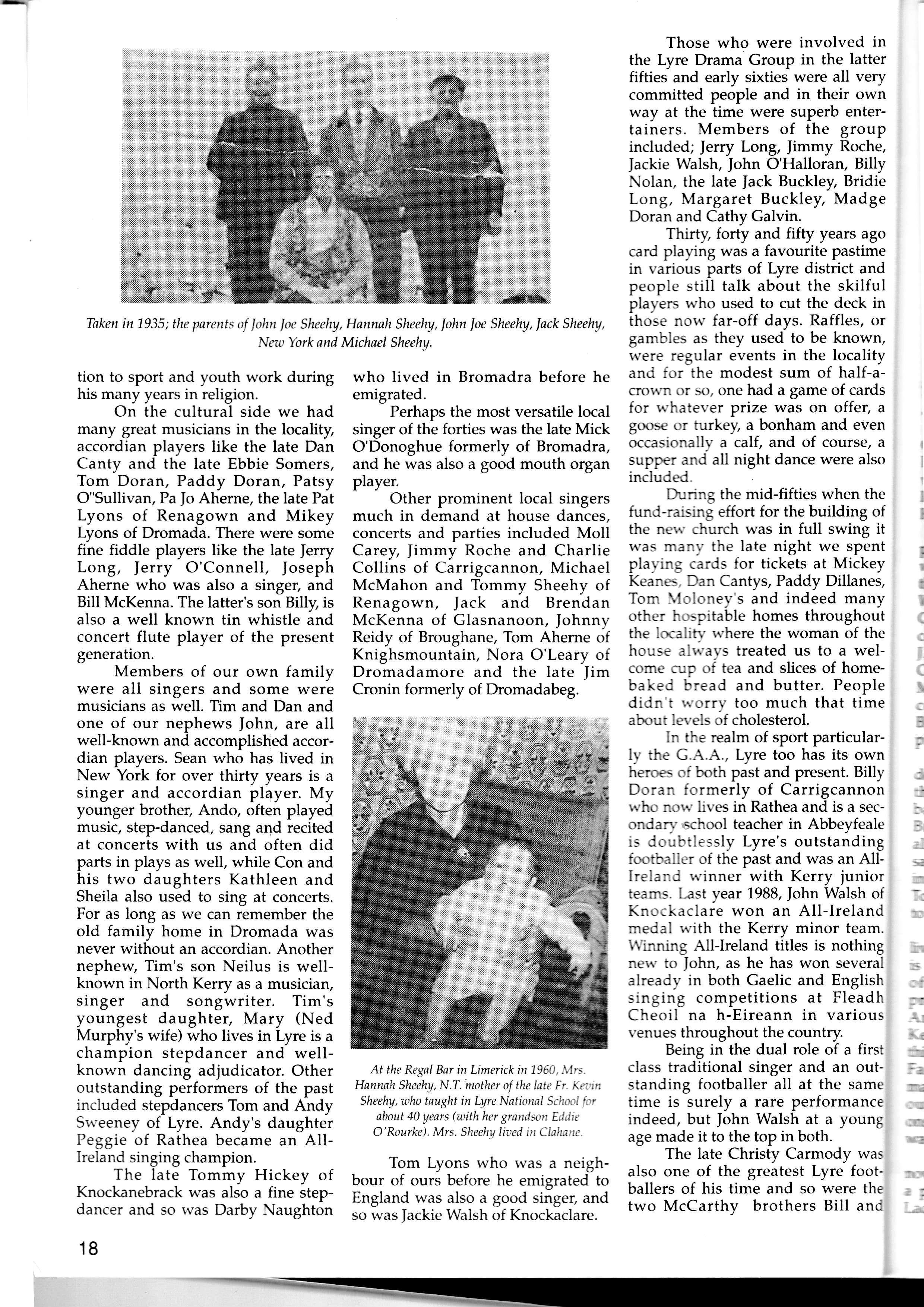
Those who were involved in the Lyre Drama Group in the latter fifties and early sixties were all very committed people and in their own w'ay at the time were superb entertainers. Members of the Broup included; Jerry Long, Jimmy Roche, Jackie Walsh, John O'Halloran, Billy Nolan, the late |ack Buckley, Bridie Long, IVlargaret Buckley, Madge Doran and Cathy Calvin.
Thirtr,, forty and fifty years ago card piaving was a favourite pastime in various parts of Lyre district and people still talk about the skilful plavers rvho used to cut the deck in those nr'rrl far-off days. Raffles, or gambies as they used to be known, rvere regular events in the locality an.i r..r the modest sum of half-acro\\'r. 0r So, on€ had a game of cards for ',r.h:tever prize was on offer, a got'rS€ trr turkev a bonham and even occa:ionailr' a calf, and of course, a supper and all night dance were also incluiec
D-rrnE the mid-fifties when the iunC-rar.ir'.s effort for the building of the n=i.,' church was in full swing it \\-dS rr.ir.'r' the iate night we spent plavr:.: ::ids for tickets at Miikey Keane. Da:r Cantys, Paddy Dillanes, Ton. \i--l,-.rer-'s and indeed manv otl'(: : :r:taL,le homes throughout the 1.-;a.rti' rr'here the woman of tne hous< :-i.'31'5 treated us to a welcorr,. .u: ..i tea and slices of homebake:':read and butter. People diin : ',r..rr.r- too much that time at'ou: -eve^s of cholesterol.
ir :i'.e realm of sport particulari.,' th.e G .{ A , Lvre too has its own he:.-e' ,.r both past and present. Billl' D0ilr. :,-.rmerly of Carrigcannon 11.1'.., L,r',r' lrves in Rathea and is a seconj:r,' s;hool teacher in Abbeyfeale r. ;c,'.:'rt-.=slv Lyre's outstanding f.-t i'!i...: of the past and was an AllIre -ar j rlinner with Kerry junior te:::'s Last vear 1988, ]ohn Walsh of Kn..ckaclaie won an All-Ireland r,elal ilith the Kerry minor team. \\'r:.ninq All-Ireland titles is nothing nei\' !o John, as he has won severai alrealv in both Gaelic and English srr.ging competitions at Fleadh Chetrrl na h-Eireann in various venues throughout the country.
At the Regal Bar in Limerick in 7960, Mrs. Hannah Sheehy, N.7. mother of the late Fr. Ka,in Sheehy, who taught in Lyre National School for about 40 years (with her grandson Eddie O'Rourke). Mrs. Sheehy lioed irt Clahane.
Tom Lyons who rvas a neighbour of ours before he emigrated to England was also a good singeq, and so was |ackie Walsh of Knockaclare.
Being in the dual role of a first class traditional singer and an outstanding footballer all at the same time is surely a rare performance indeed, but John Walsh at a young age made it to the top in both.
The late Christy Carmody was also one of the greatest Lyre footballers of his time and so were the tr,vo McCarthy brothers Bill anc
Taken in 1935; the parents ot' lohn loe Sheehy, Hannah Sheehy, John Joe Sheehy, lack Sheehy, Neus York and Michael Sheehy.
18
Dannv oi Clasnacree. There are many others too numerous to mention n,hose names will forever be associated with the C.A.A. in Lyre.
joe Qrrille who has lived for many years in Lirnerick City was at one time the youngest C.A.A. club secretary in lreland. In recent times his name. and voice became known to thousands of listeners throughout the city and countv when he was a disc jockey in a weekly Radio Luimni programme called "Mid Wer.k Music".
The late Tim Neville r-.i Carrigcannon formerly of N{ovr'.rne w'ho once pial,ed for the Nerr' \ork Kerry team won a district 1c'acue final with Carrig Sarsfields n-l-ren he rvas fifty', which again must have bec.n a very unlisual achieverrrer,t for a football player.
Tom O'Donoghr-re. formerly of Carrigcannon r.r'ho rr'as secretary of Lvre club during the mi.l-seventies was one of the -celectors oi the St. Kieran's team that rlon the 1988 Kerry countv chanrpionship final.
Other u'ell-knl.rr-n local G.A.A. personalities rr'ho n'ere associated with the re',,ir-al of the Lvre club in the early seventies ir-rciuded Jackie Walsh who is norr. .rlso chairman of Comhaitas Ceoltorri Eireann in the county, John \er i1le, Paddy Dillon, l.J Healr', Larrv Long, Timie O'Donoghue, lggl' Lvons, Ned Murphy, late \likev Nash and of course the late and great Jack Buckley rvho served so long as a plai'er official anJ ()r$aniser.
Another ma n rtho surely deserves special mention. if only for the long span oi trme he plaved football, is Tom Q PonLrghue. of Bromadra, uncle of Tom and Tim already mentioned. It has often been said around Lyre that r.nlr'for a hand injury sustained when he \\'as voLlng, Tom would have been gc.otl enough to make it to a much higher 1er el, Joe Walsh of Cordal rlho norv lives in Kilmoyley and n hose mother is the former Rita O'Connor a n.rti\-e of Dromadamore East is a ver\prominent hurler, while his si:ter Annette is a leading member of Kerry Ladies football team, ap;airr this vear's All-Ireland winners. Wi1lie Falvey who has lived in Lyre for many years won many hurling honours including county championships lt ith his native Crotta and he was also a useful footballer.
I{elena O'Connor of Maugha non, married to Tom O'Mahony was a prominent member of the Kerry Ladies football team for a number of
years and All-lreiand n,inner. Down through the years Lyre has know,n rnany interesting local personalities including popular writer, poet and bailad composer John Joe Sheehy, also Dinny Nolarr the local taiior, r.vho are both still hale and hearty. One of the greatest poets of the locality in former times was late Thade Corvran. He. was aiso a balladmaker and composed classics like "Yorkslrirc Pigs" and "The HighHeclcd Shoes", which were both products of the tim-e he spent in Lyre and which are still sung in many places. Others rvho have passed on included genial Al Roche who u'as proprietor of the Four Elms Bar and who was a great conversationalist, reciter and entertainer, Jerry P. Iv{oioney, w'ho \,vas a Peace Commissiclner and a man of manv talents, Jack (Council) Nolan ot Glountane one. of the best liked and most colourful characters of our time, Jer Collins who rt as a native of Duagh, but rvho lived in Giountane, Bili Nolan r,r'ho was local postmaster for manv years, Paddy Kirby who died only a short time ago, ]er Naughton and Mick Sheehy n'ho were both postmen, and my cousin Pa Sheehy r,r,hose brothe.r Iohn Joe rvas Chief Warden in Sing Sing Prison, Nern, York for many vears.
Br-rt the.re. w,ere manv outstanding u-omen irr Lvre district as w,ell, teachers such as iate' Mrs. Hannah Sheehv and \'larv Ann Nolan played a major role in tiie education of l6cal children. Onc. of our olvn tetrclrers at Renagor'r'n Schooi, I\{rs. Margaret O'Connor, n,as .rlso a native of Lvre. Mrs. Sarah O'Sullivan, nou, retired, was also an excellent teacher antl
spent many years in the profession, her late sister Elizabeth (Liz) McElligott was a nurse and was noted for her skill and kindness to local people whom she often visited and attended when they were sick.
Paddy Doran's wife formerly Mary Canty, was, and no doubt still is one of the most popular ladies in the locality, well-known for her cheerful manner and good humour. It was many the pleasant hour that ]ack Nolan, his brother Paul, some of the other local lads and myself, spent with herself and Paddy when they lived in Glountane. Rita O'Connor and late Nora Dillane were also regular visitors there. The wit and conversation used to be great. Later Paddy and Mary moved to Carrigcannon where they went into business with a shop, petrol station and taxi service.
It would of course be impossible in an article such as this to include all the many fine people around Lyre who treated me so well during my long term as a New Ireland and Irish National insurance agent, over thirty years ago. One can only thank them in a general way and assure those of them who still survive that the business they gave me, the dinners and cups of tea are still gratefully remembered. The same goes for all my old friends and neighbours in both Dromadamore and Dromadabeg. They are a great People.
What of the present time in Lyre and what are its prospects for the future? An industry of some kind to replace Bord na Mona and forestry employment is certainly badly needed, and hopefully may come in time.
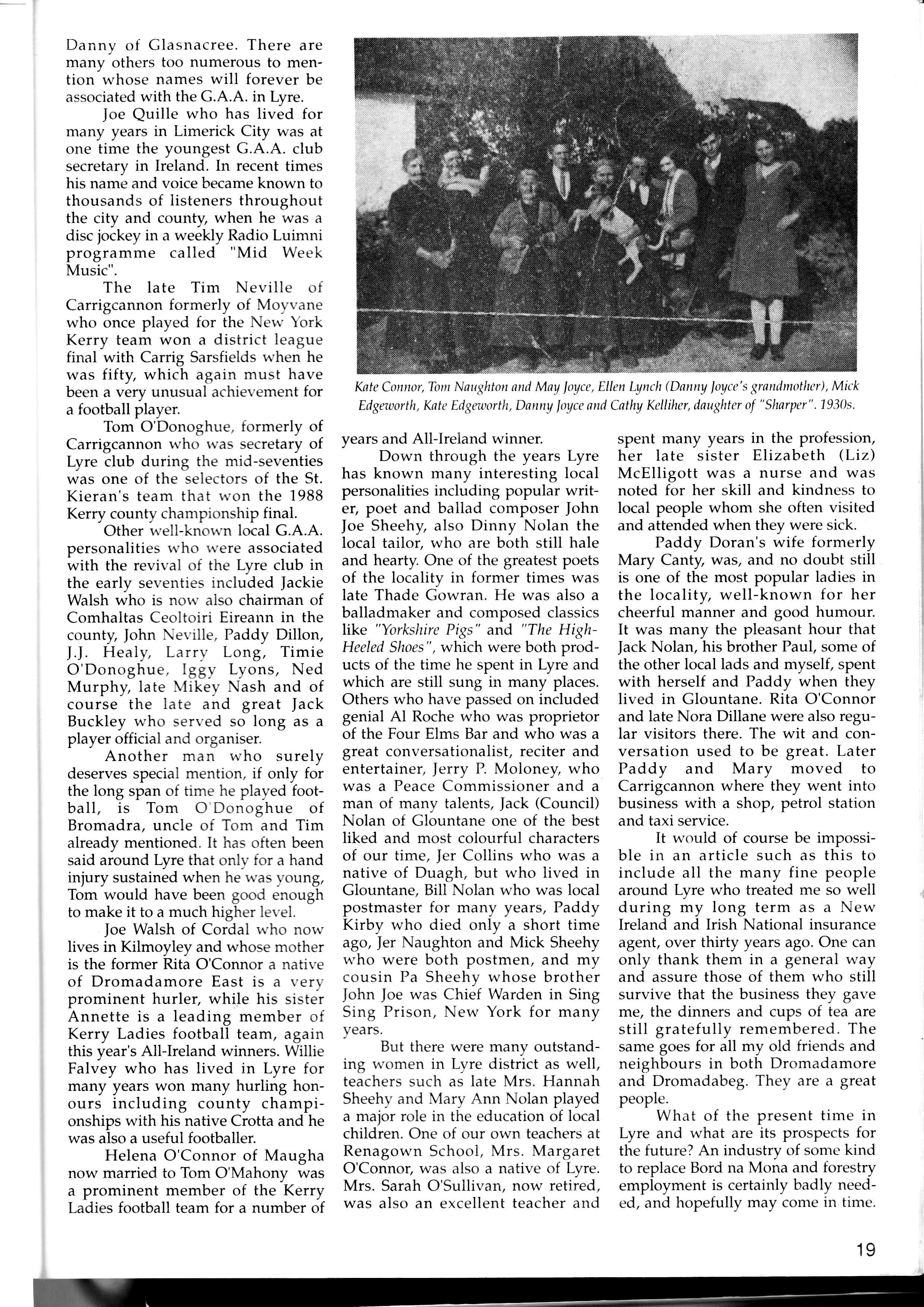 Kate Connor, Tom Naughton and Moy loyce, Ellen Lynch (Danny Joyce's grandmother) , Mick Edgeworth, Kate Edgeworth, Danny Joyce and Cathy Kelliher, daughter of "Sharper".19j0s.
Kate Connor, Tom Naughton and Moy loyce, Ellen Lynch (Danny Joyce's grandmother) , Mick Edgeworth, Kate Edgeworth, Danny Joyce and Cathy Kelliher, daughter of "Sharper".19j0s.
19
In the social and cultural context the area appears to be booming. It has been my pleasant task those past few years to adjudicate at the Irish and English singing competitions at the annual Lyre Feile Cheoil. There is some great talent among the young people there, and the standard in singing, dancing, and music is unbelievably high. The Walsh family of Knockaclare, |ohn already mentiqned, Karen, Padraig and Aiden have been county, Munster and AllIreland champions several times. There are some other very good young singers in Lyre at the-prEsent time, including the Kelly family, the Lyons family, the Naughtons, |ohn Healy, Albert Roche, Labhras Long, Liam Stack, Norma Murphy, the O'Callaghan sisters Caroline and Edel.
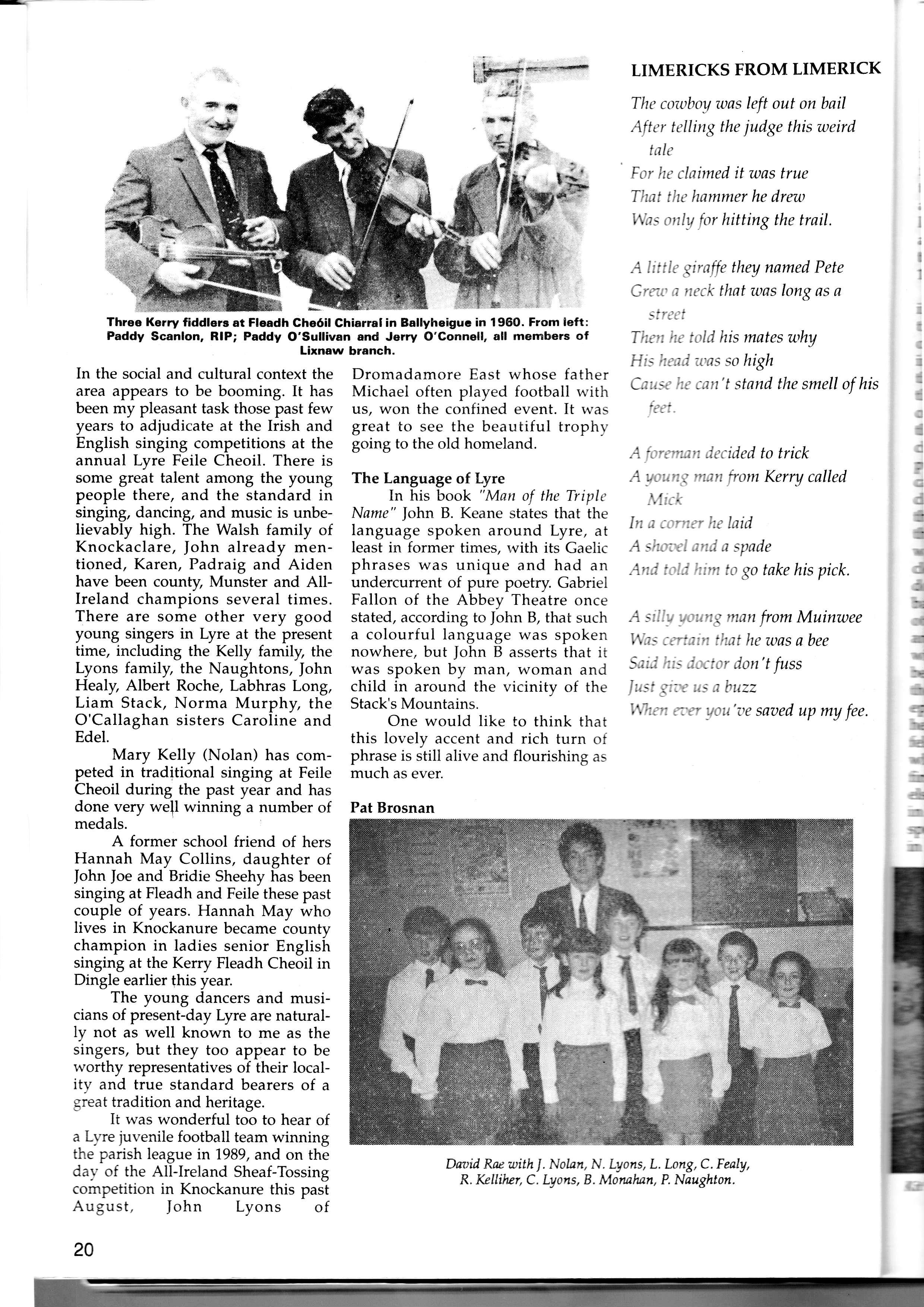
Mary Kelly (Nolan) has competed in traditional singing at Feile Cheoil during the past year and has done very wefl winning a number of medals.
A former school friend of hers Hannah May Collins, daughter of |ohn Joe and Bridie Sheehy has been singing at Fleadh and Feile these past couple of years. Hannah May who lives in Knockanure became county champion in ladies senior English singing at the Kerry Fleadh Cheoil in Dingle earlier this year.
The young dancers and musicians of present-day Lyre a1e naturally not as well known to me as the singers, but they too appear to be worthy representatives of their locality and true standard bearers of a great tradition and heritage.
It was wonderful too to hear of a Lyre iuvenile football team winning the parish league in 1989, and on the day of the All-Ireland Sheaf-Tossing competition in Knockanure this pastAugust, ]ohn Lyons of
Drornadamore East w-hose father Michael often played football n'ith us, won the confined event. It n'as great to see tire beautiful trophv going to the old homeland.
The Language of Lyre
In his baok "Msn of the Tri1tlc Name" John B. Keane states that the language spoken around Lyre, at least in former times, lvith its Gaelic phrases was unique and had an undercurrent of pure poetry. Gabriel Fallon of the Abbey Theatre once stated, according to John B, that such a colourfui Ianguage r,r,as spoken nowhere, but John B asserts that it was spoken by man, woman and child in around the vicinity of the Stack's Mountains.
One would like to think that this lovely accent and rich turn ot phrase is stili alive and flourishing as much as ever.
Pat Brosnan
LIMERICKS FROM LIMERICK
The couboy was left out on bail After telling the judge this weird tale
For he claimed it was true Tlut tlrc hammer he drew Was only for hitting the trail.
Alittle Srrrff, thry nnmed Pete Greu, a neck that was long as a
Then he told his mates why His hud uas so high Cauy he can't stand the smell of his
nan decided to trick tg man from Kerry called
r he laid md a spade him to go take his pick.
Wa Sai. lusi Ir.'7r
y yaung man from Muinwee 'stain that he was a bee is drctor don't fuss ioe us abuzz
I uou'tte saoed up my fee.
+ $!B#
Three Kerry fiddlers at Fleadh Che6il Ghiarral in Ballyheiguc in 196O. From left: Paddy Scanlon, RIP; Paddy O'Sullivan and Jerry O'Connell, all members of Lixnaw branch.
.t*.=-,* a*i
Daoid Rac with l. Nolan, N. Luons, L. Long, C. Fealy, R. Kelliier, C , Lyons, B. lvlonnfun, P. Naughton.
20
A cold Autumn breeze was blowing in from Kerry Head when two girls from Lyre planned their escape out their bedroom windows, and brave against it for 8 miles to Kilflynn Hall. In those days about 40 years ago, you were in bed at 8 o'clock on the dot and the dances were over at L1 o'clock.
Nell and Sheila, two neighbouring girls of 18 years, started off on their mission successfully at 9 o'clock, barefooted with their dancing shoes hanging by the lace around their necks. As they came nearer to the hall, they wondered why they could not hear any music, and in fact there wasn't a sinner around. They cleaned their legs in the grass and put on their shoes, but when they came up breathless to the door, 'twas closed against them. Little they knew that there was an old woman dead in the village and everyone was at the wake and, of course, the hall was closed as a mark of respect. They sat down at the door to get their breath back, with each of them blaming the other for being such an Oinseach, and the journey down being so short with the fall of ground sure it would be twice as long going home against the hill. No satisfaction out of their episode and furthermore they had heard of all the tall dark handsome fellows around Kilflynn and that is what took them down there in the first place. Pure disaster and nothing else. They took off their shoes again in case any extra wear would be spotted in them after the night, and in any case they hadn't another pair

to their names. So with scorn they turned for home. At least it wasn't raining but sure you did not get half the rain those days that you are getting now. You never heard the word "thumb" either for there was nothing to thumb, only "shanks mare", all the ways. They had only barely started when they heard the tapping of footsteps coming against them. Lo and behold they observed two donkeys. It did not take them long to put two and two together. After great persuasion they got the donkeys cornered in by the side of the hall. The bigger one was easy enough, but the small one was a devil. Sheila being light and handy, held him by the top of the head. "Get up", she said to Nell who was a bit on the heavy side and rather clumsy. You would also know by her gauche that she never rode a donkey. Sheila gave her all the help she could with the other hand and after great hardship eventually pushed her up, but what do you think happened - she fell off at the other side. That would try the patience of |obe whoever he was, which did not make a hell of a difference whatsoever at that stage. AIso not knowing but that the protective mothers at home were checking the beds to make sure that all their children were safe and sound for the night, with all the clothes to their backs before they'd retire themselves.
It took about 10 more precious minutes to repeat the procedure of getting Nell back on the donkeys back. At last she got her straightened for the road and wisha mo lear, no
Arkle ever took off with such speed. All she could hear was every scream out of Nell in the distance. She picked two long sally rods and got up on the slow one in short time. 'Twas with the power of the sallies that she got him up to the cross. By hook or crook he did not want to turn East for Lyre. Eventually after doing several rings around the road she got him straightened out and he moved at a snails crawl for about 400 yards until the sallies wore out and he stood up like a statue in the middle of the road. If he stood there now he'd be carried off in the front of a bus and Sheila with him. She gave up and jirmped off his back, but no sooner had her legs met the ground than the donkey whirled around on the road, let a screech out of him that woke the parish of Abbeydorney, and he hit the road for Tralee at a mile a minute. Sheila sat down in the side of the road to start thinking how would a wan get out of a situation like this. Where was the nearest Guards Barrack? Would she put them searching for Nell, but what idiot of a Guard would believe her story, she might only get herself locked up and maybe put in a straight jacket.
She got to her feet after coming to the conclusion that if Nell held on even though she had no control whatsoever, and it was likely that the two donkeys went the same direction, she must be going into Tralee by now and if not she's dead somewhere. So she set out after the chirse to try to find her herself, dead or alive. At any rate, she thought this is one story that there is no possibility it could have a good ending. With that she heard a complaint and there was Nell limping towards her. "Is that you", she said to Sheila. "You walking bitch you put me up on the foal and you took the trained donkey yourself. He took a sharp left into a farmyard and fired me into kingdom come". No words of mouth could upset Sheila when she saw Nell alive and they turned for LyreacromPane and they swore they would never again leave it, which they did not, and they married two local fellows, perhaps not as handsome as the boys from Kilflynn, and they are still footing turf in the bogs of Lyreacrompane.
Kit Sheehy, Renagowrt with lrcr grandchildten, the Collins family, Knockanure and in centre back,Yuonne Stack. Kit tuho is the aunt ofTbmnty Sheehy,is 85 years old.
21
THE MAGIC OF SPUR
(l oe Quille Reminisces)
Spur - what memories that name evokes and straight away one is reminded of the immortal lines of the Phil Coulter's ballad of another place, 'Those were happy days in so many, many ways, in the town I loved so well'.
Everyone has their own recollections of Spur, but for me those were happy days in so many, many ways that a trip down there nowadays brings a tinge of sadness. The houses that were filled with merriment and inhabited by hospitable people, are sadly no more.
An eerie silence broken only by the gentle flow of the river pervades the scene, and one is forcibly reminded of happier times when on your way down there you would get afriendly greeting from Tom Naughton, or it might be Costelloe|ack at his gate. You would almost certainly catch a glimpse of Mikey Nash, or Nora Kelliher, and very definitely you were liable to bump into Paddy Kirby (pronounced Keerby) to be regaled with the latest
news, more often than not embcllished by Pat in his own inimitabk style.
Or perhaps it might be tht friendly face of Kateen Lynch coming from the well laden down u'ith : bucket of water.
Alas, time marches on, nntl these people of conviviaiity and gtntleness are all gone. We shall not sec their likes again.
My earliest recollection of Spur was maybe at the age of eight or nine. The then teenagers and adults from Clahane and elsewhere r.r,ouI.-i gather at the "New House" for music and dancing. At the time the gramophone was in its inftrncy antl I remember more than one occasion t.. go down to ]ack Costelloes to hear the records of that era, and to marvel at this new gadget on the table, that had to be wound up with a handll., make sure the needle was o.k. put L)n the record and cff she goes. This prtrcess was repeated after each record. Ellie Mary would be at the controls and looking on benignly at each side
of the fire would be Jack Costelloe and his wife, affectionately known as lv{arv Leary. In later years when I n'rote a column for the Limerick Leader on music and the introduction of the gramophone, memories of that first encounter with this strange gadget at Jack Costelloe's came flooding back, and were fack and \{an' Leary alive today, how they rvouid marvel at the technology of todar''s musical gadgets, from the record player to the three-in-one up to the compact disc player.
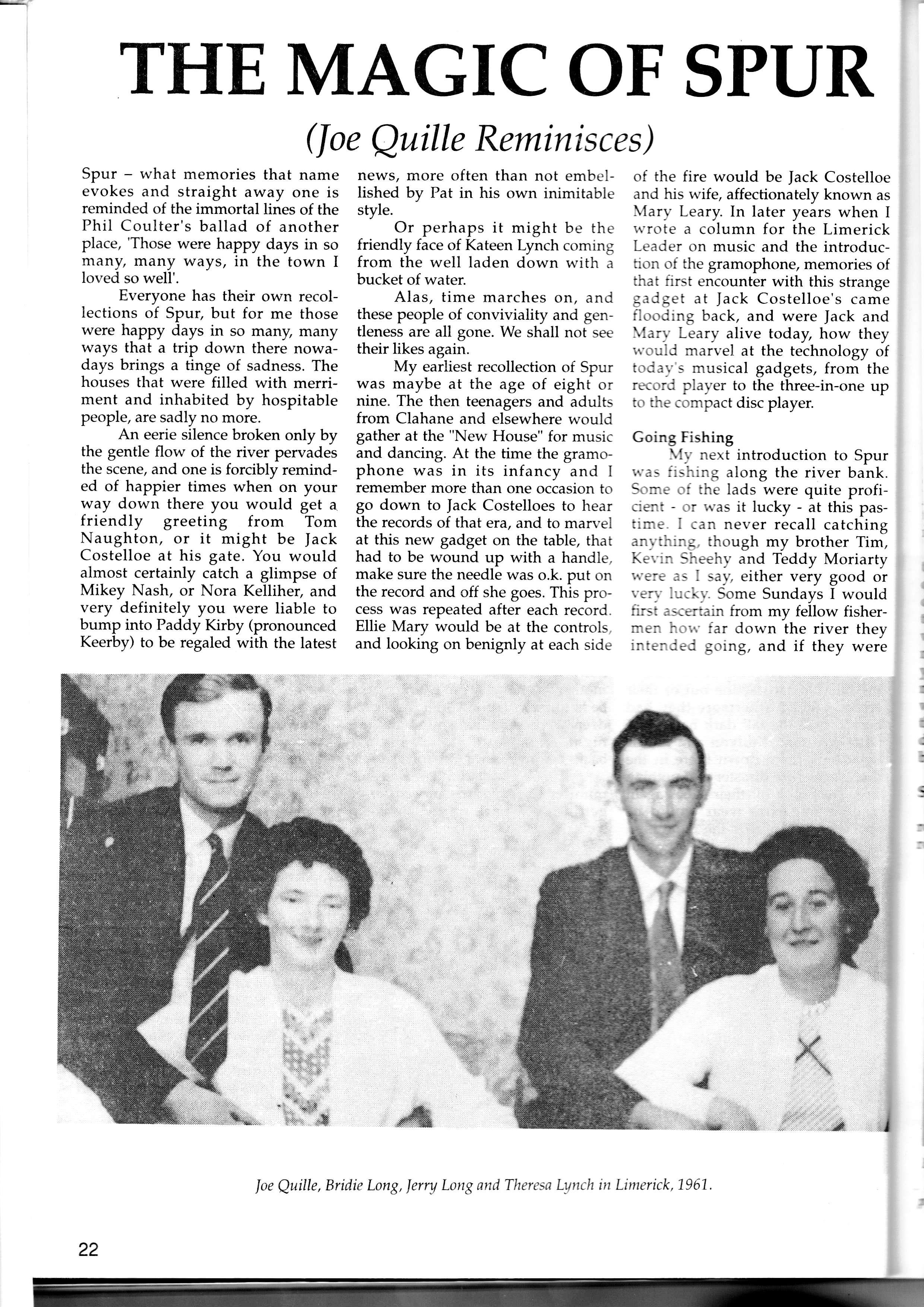
Coing Fishing
\{r, next introduction to Spur rsas fiihing along the river Uant. Some of the lads were quite proficient - or rvas it lucky - at this pastime, I can never recall catching hing. though my brother Tim, n Sheehy and Teddy Moriarty sar', either very good or
\
rv iar down the river they intended going, and if they were
I 22
loe Quille, Bridie Long,lerry Long and Theresa Lynch itt Limerick,1967
'
-.-ing as far as Johnny Macs or there-:outs I'd go, for the very good rea, -.n that even though I was a mere .:l of eleven or twelve I had a fierce :-lsh on a girl across the river from ,irnny Macs. Of course I couldn't :..11 that to my companions. Thev d -ake a show of me.
Being a cute little chap I u'ould ::i' to convince them that fishing .: orvn that fal would be more pro-,:,rctive. Sometimes it worked, some'.:rres it didn't, but when it did there as always the possibility that I --:qht catch a glimpse of a certain -.ung lady which interested me : rrre than catching a fish which is nv I was voted by my colleagues as '.-e rvorst fisherman in those ha r.ivs in so many, many ways ol1 :nks of Spur river.
:chool Days and Spur
Again in the pursuit
:r1ance, Spur was invariably'-:te I'd choose to go to sch,
pPy the of the ool,
though the usual route for Clahane would be out the road to Clahane Cross, down by Canty's and over Dorans Cross. My travelling companions would have been my brother fohn, Tom Moriarty and his sister Kathleen R.I.P. Again as in the case of the fishing, I would inveigle my colleagues to go to the Spur route, the object of the exercise being to meet up with this same younglady beyond Johnny Macs. It wasn't long before my travelling companions copped on to the reasons for this particular route to school and while they were sympathetic towards my romantic aspirations, they invariably left me to my own devices and while they'd go out the road to school I'd gown down Spur.
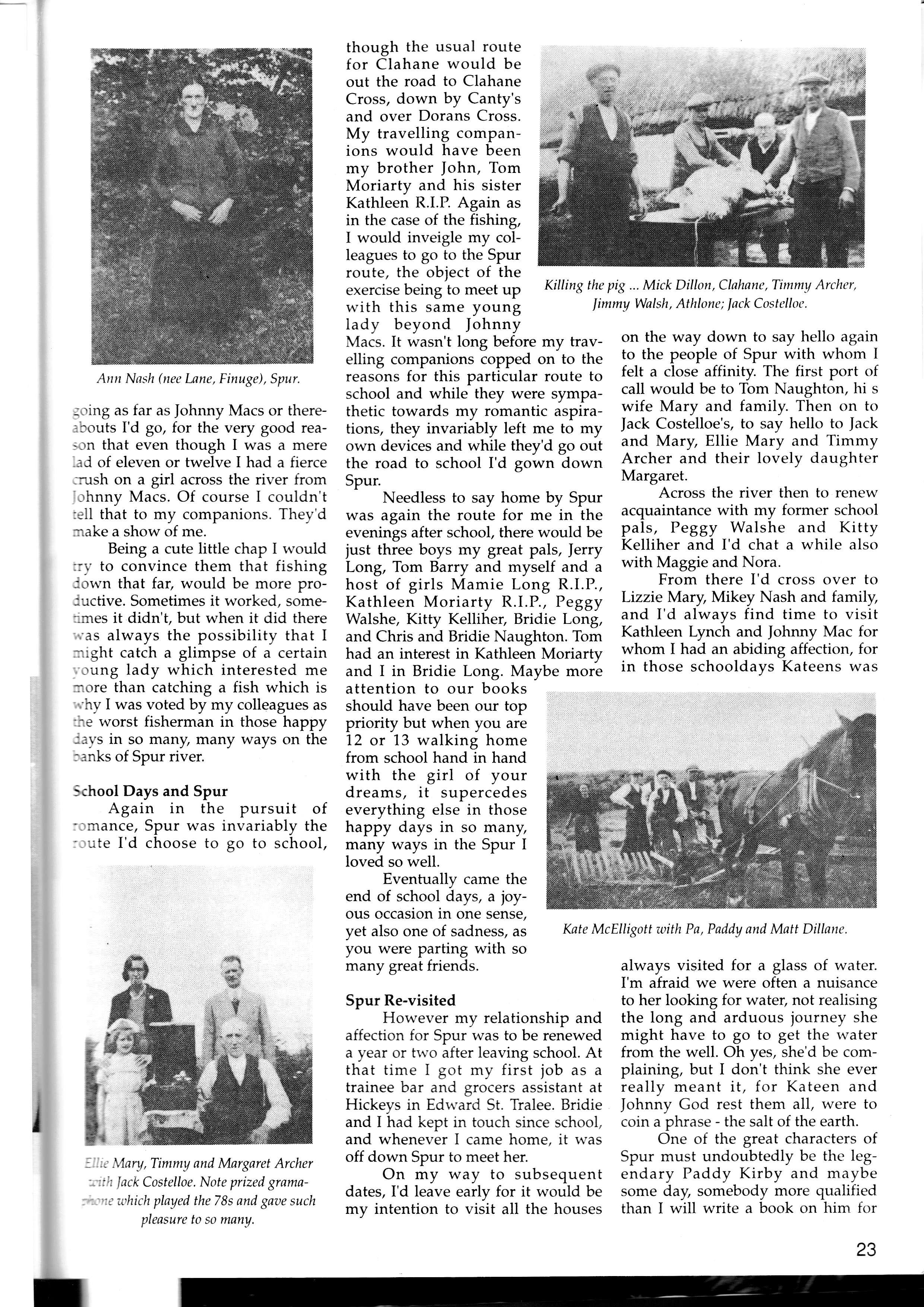
Needless to say home by Spur was again the route for me in the evenings after school, there would be just three boys my great pals, ferry Long, Tom Barry and myself and a host of girls Mamie Long R.I.P., Kathleen Moriarty R.I.P., P"ggy Walshe, Kitty Kelliher, Bridie Long, and Chris and Bridie Naughton. Tom had an interest in Kathleen Moriarty and I in Bridie Long. Maybe more attention to our books should have been our top priority but when you are '1.2 or 1.3 walking home from school hand in hand with the girl of your dreams, it supercedes everything else in those huppy days in so many, many ways in the Spur I loved so well.
Eventually came the end of school days, a joyous occaslon rn one sense/ yet also one of sadness, as you were parting with so many great friends.
Spur Re-visited
rc Mary,Timmy and Margaret Archer lh lack Costelloe. Note prized grama,te ithich played the 78s and gaoe such pleasure to so many.
Hon'ever my relationship and affection for Spur was to be renewed a vear or trvo after leaving school. At that time I got mv firit job as a trainee bar and grocers assistant at Hickevs in Edrrard St. Tralee. Bridie and I had kept in touch since school, and w'henever I came home, it u'as off down Spur to meet her.
On my way to subsequent dates, I'd leave early for it rvould be my intention to visit all the houses
on the way down to say hello again to the people of Spur with whom I felt a close affinity. The first port of call would be to Tom Naughton, hi s wife Mary and family. Then on to )ack Costelloe's, to say hello to Iack and Mary, Ellie Mary and Timmy Archer and their lovely daughter Margaret.
Across the river then to renew acquaintance with my former school pals, Peggy Walshe and Kitty Kelliher and I'd chat a while also with Maggie and Nora.
From there I'd cross over to Lizzie Mary, Mikey Nash and family, and I'd always find time to visit Kathleen Lynch and fohnny Mac for whom I had an abiding affection, for in those schooldays
Kateens was
always visited for a glass of water. I'm afraid we were often a nuisance to her looking for water, not realising the long and arduous journey she might have to go to get thc rvatcr from the well. Oh yes, she'd be compiaining, but I don't think she ever really meant it, for Kateen and Johnny God rest them all, rvere to coin a phrase - the salt of the earth.
One of tire great characters of Spur rnust r-rndoubtedly bc thc legendarv Paddy Kirby and maybe some day, somebodv more qualified tiran I will n,rite a book on him for
Killing the ptig Mick Dillon, Clahanc,Timmr1 Archtr, limmy Walsh, Athlonc; lack Costelloc.
Arrrr Ncsll (rrce Lane , Finuge), Spur.
Kate McElligott ,.tith Pn, Paddy and Matt DillanL:
I 23
"Keerby" as he was affectionately known, along with his wife Hannie, and family epitomised the real spirit of Spur.
A HappyEnding
Meanwhile the romance with Bridie which had began in the classroom at Lyre school continued to blossom so my trips up and down Spur continued unabated. By now it had become a double event with my brother Christy and Bridie's sister Mamie entering the romantic stakes and were eventually married, and sadly Christy was bereaved in 1984 by the death of his beloved Mamie.

For me, who began my association with Spur at ten or eleven, the ending turned out a happy one for on the 11th of February 1965 at St.
Brigid's Church, Duagh, the first met on the banks of the River Bridie Long, became Joseph Quille.
girl I Spur Mrs.
Yes indeed, those were happy days in so many, many ways in that place I loved so well.
My Father lohn ]oe Sheehy
In August 1914 the First World War began and 3 months later on the 21st. November my Father was born an onlychild to Michael (Mick) Sheehy anil Hannah (Dillane) Sheehy of Clihane, Banmore.
He attended Lyrecrompane School from 1921 to t9i9 and a?ter leaving school he stayed to work the family farur-. As a young man he took and interest in boxing and won many a match in the ring. His strength also helped him achieve beating all before and behindhim at the Sheaf Throwing in Abbeydorney in1942.
MY HOME IN SWEET TYREACROMPANE Air - Eileen McMahon by Paddy Faley
Far away from my homeland in Kerry I haxe been for a number of years, But although l'm contented and hnppy mu memory still fondly adheres, Tt that dear little spot by the Smearla it*ere I t'irst saw the light of the diiL.rl, .tttl sltent the young days of my childl1;tp;l i77 my home in sweet Lu"e:lcrompafie.
On Lyre I can neaer forget you no matter how long I'm away, In my mind you're as t'resh as the daisies like the sweet air blowing in from the bay,
And when lreland was fighting for freedom vour braae sons to the colours Tlrere dratDfi, In defence o.f their own natiae country and thtir homes in sweet Lweaoomwne.
The musb and songs at the crossroads I un still har them clearly today, When in fonq nry mefiory it wonders to thax ilays thnt are long passed ttMy, kck to tlr flag-fl@r in the kitchen rrtere 'tis often we danced until d&Dn, Gdb TDiththebright ikys of my boy-hd 'mund my home in sweet Ilracmmwne.
lln dreams I am sometimes awakened I W the riter that flows closer at I hand.
He married my mother Bridie (Barry) Sheehy, Daughter of Michael (Mici<) Barry and Nora (Sheehy) Barry of Pallas Banemorc on the l5th-Februai'195{ in Lixnaw Church. The bridesmaid was Dad's 1st cousin Kathleen (Sheehy) O'Rourke andthe Best man was Maai's brother Tom Barry. The ceremony was performed by Fr. Browne and they then honeymooned in Dublin.
--
My $her also had a great $ft with words. He has written many songs and has brought laughter to many a fie. All his songs are known farand wide.
Dad also became a member of the North Kerry I.C.M.S.A. in 1951 and r€tired in 1986 and it's nice to know that when he retired Mam took his place.
We only have one Father, Patient, kind and true. No other friend in all the World, Will be the same to you. When other friends foresake us,
lWnn, 'tb often I fished in it's waters I and .fine catches of salmon did land, lThne days they are now gone foreuer I b"t the wealth ot' the world l'd I wu'n, lTo return once more as a garsoon to | ^y home in sweet Lyreacrompane.
This ballad was originally written at the request of late Jack Molyneaux formerly of Glasmaroon, who later iived for many years in Killeaney near Glin.
To Father we will turn. For all his love and kindness He asks nothing in return. As we look upon his features Sweet memories we'll recall. Of a face so full of sunshine And a smile for one and all.
By Noreen Sheehy.
Margaret Archer €t Paddy Moloney.
24
A turfman in action
Paddy Kirby.
DAN PADDY ANDY OISULLIVAN
l.l. Sheehy
Dan Paddy was born and grew up here as did his father and grandfather before him. He was a dispatch carrier for the Volunteers during the Tan War, and allegedly thought nothing of walking through a ton'n full of Black and Tans with his dispatches in his pocket. Around about 1925 rvhen things had quietened down and the country had returned to normal he got the idea into his head, that he would build a dance hall. His obiect I am sure, was that it would be an investment for his future, in fact a guaranteed income at that, in the coming time. Already he had a farm, a big mountainy farm, but he rr-as not a great farmer, he disliked the continuous drudging inseparable from farming, so he had not much of an income from that. He had tried various other wavs oi making money. He had had a stab at cattle dealing or "jobbing" as it is called
oufstanding. \ext he stood for eiection ftrr the County Council. He rec,,.ived one \:ote, his own, and that one l\'as spoiled. So he built the dance hall. That was a huge success. He had it open for seven nights of rhe ir'eek at first. The admission charge rvas two pence and the year r.,'as 1925. I believe it was the first commercial dance hall built in Ireland at least in a rural district. As rime rvent on, other sharp-eyed entrepreneurs seeing the success of Dan Paddy's hall put up halls here and there until the countryside all over was dotted with them. There rvere actually three more dance halls built in this area over the next five vears. Then the Government got in on the act. It saw the dance hafs as a source of revenue and introduced legislation governing the opening and closing times and the number of nights per week on which dances could be held, and the hall owners
deteriorated as he grew older. Attempts to pass off a Holy Medal to him instead of a shilling or florin, seldom or ever succded all the same. One winters night a puck goat wandering around was lofted and pushed in through the only window, at the same time the paraffin lamp was extinguished. The floor being crowded at the time, the resulting confusion not to say hysteria can be better imagined than described.
':ere, but not being a good jud:e .rf -attie he lost more monev than he :rade at that. Next he tried his ha.;^.1 .'r matchmaking. I{e would hear ..i :irme man/ single, and anxious to --:range his status, and introduce him :. some wornan with similar ideas, ,:rd try to get them to accept each 'rh.er as man and wife. He would -:emand an introduction fee from =ach of them and would insist on rother payment if the initial intro-:uction resulted in marriage. His .,rck of success in this venture vsas
had to go before the District Court annually to get a license to carry on and pay for same. This legislation I need hardly say was anathema to Dan but he had to go along with it like all the others. However, he continued to make money and that was all that counted in the long run. The musicians who played for dancing in his haII were all local people. Their instruments were at first, the melodeon and later the accordion. The dances were the eighthanded reel,
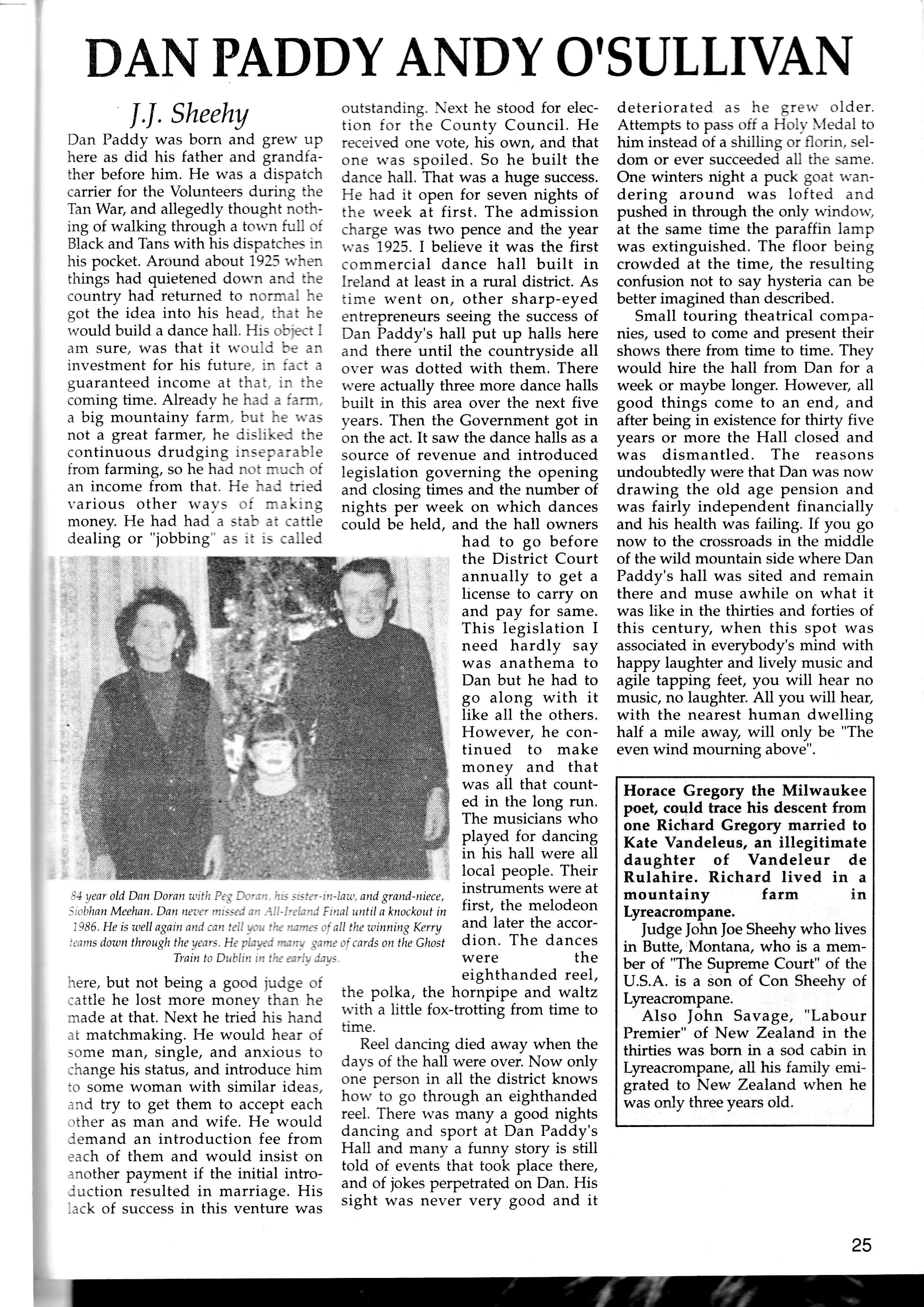
the poika, the hornpipe and waltz rlith a little fox-trotting from time to time.
Reel dancing died away when the davs of the hall were over. Now only on'e pe.son in all the district knows hou' to go through an eighthanded reel. There \vas many a good nights dancing and sport at Dan Paddy's Hali and manv a funny story is stili told of events that took place there, and of jokes perpetrated on Dan. His sight was never very good and it
Small touring theatrical companies, used to come and present their shows there from time to time. They would hire the hall from Dan for a week or maybe longer. However, all good things come to an end, and after being in existence for thirty five years or more the Hall closed and was dismantled. The reasons undoubtedly were that Dan was now drawing the old age pension and was fairly independent financially and his health was failing. If you go now to the crossroads in the middle of the wild mountain side where Dan Paddy's hall was sited and remain there and muse awhile on what it was like in the thirties and forties of this century, when this spot was associated in everybody's mind with happy laughter and lively music and agile tapping feet, you will hear no music, no laughter. All you will hear, with the nearest human dwelling half a mile away, will only be "The even wind mourning above".
Horace Gregory the Milwaukee poet, could trace his descent from one Richard Gregory married to Kate Vandeleue, an illegitimate daughter of Vandeleur de Rulahire. Richard lived in a mountainy farm in Lyreacrompane.
Judge |ohn |oe Sheehy who lives in Butte'Montana, who is a member of "The Supreme Court" of the U.S.A. is a son of Con Sheehy of Lyreacrompane.
Also |ohn Savage, "Labour Premier" of New Zealand in the thirties was born in a sod cabin in Lyreacrompane, all his family emigrated to New Zealand, when he was only three years old.
25
I84 year old Dan Doran toith Peg Doron, hb sbter-in-law, and grand-niece, Siobhan Meehan. Dan neoer misd an All-lrcland Final until a knockout in 1986. He is well again and can tell you tle nana of all the winning IQrry teams down through the years. He floyed tmtry game of cards on the Ghost Train to Dublin in tle arly drys.
FROM ROSCREA
The sun it shone down on the scene bright and fair
And hundreds ot' people were assembled there
T'uas the annual sports day in sweet Lyreacrompane
INhere the Smearlagh flows down by Meehans green lawn.
We had jumping and running and weight throwing as well
Young and old they competed I'm glad for to tell
And the central attraction on that famous day
Was the sheaf-throwing that was won by Big lohn from Roscrea.
lolm ll;,tssell's a mafi who's broad, brazuny and tall
The strength in his arm is apparent to
all
INhen his name it was called, 'nenth the bar he did stand
Prepared to take on the best throzuers in the land
Who stood all around on the green grassy sward
To compete and to uin they usere all well prepareC.
Determined and ready to engage in the froy
But in the end they gaoe best to Big lohn from Roscrea.
The Mullanes t'rom Kilmeadv were there to the fore
And the great lack Dwyer t'rom Toomeaara's green share.
Pat Loony was there, Vincent Casey as ruell
And the honour of Cork, Eddie Buckley upheld.
Billy Delaney, Rathdozoney, he took secand place
Joe Hogan, Mountcollins was next in the race
And the mighty McSweeneys who came from Coolea
But no one could equal Big lohn from Roscrea.
Pat Delaney was there and strong is his hand
Derry Donooan for Kerry t'rom Banna's lone strand
And Clareman Dick Pickington from the uillage of Cree
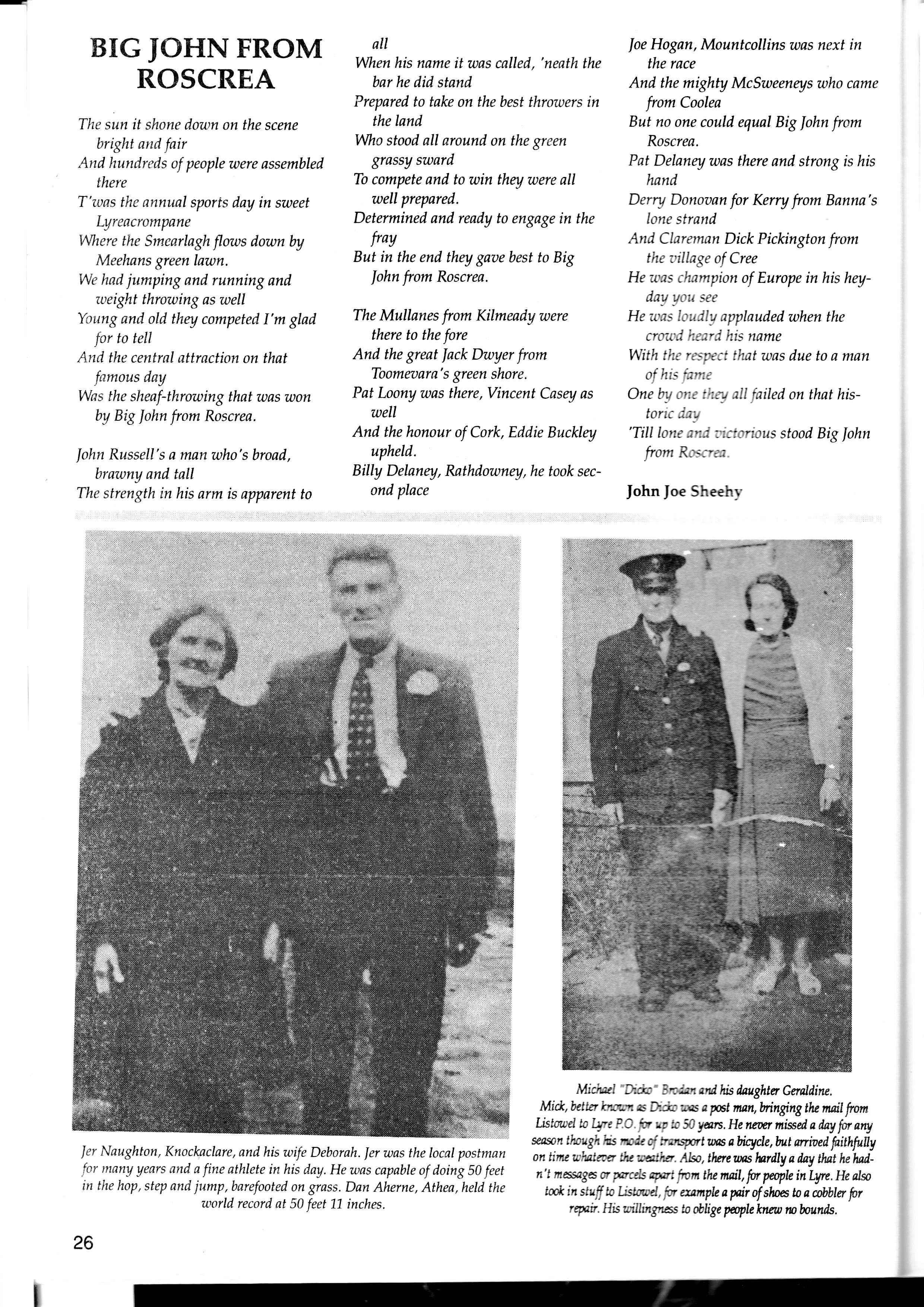
He uas champion of Europe in his heyday you see
He was loudly applauded when the croud heard his name
With the respct that was due to a man of his fame
On, W ore thev all failed on that histonc dov
'Till lone and dctorious stooil Big lohn from Roxru.
John |oe Sheehr'
Mi:iu! |r.i,-' : -;;t anlhis daughfu GeralCine. Mick, btt trr lr::r :s D i- -,c,. a pt man, hinging tlu nail t'rom Lktouel tc b-e I C \:, c ': 5ij yars. He nwr missed a day t'or any *ax,n tbugh ns -;:e c: tirs,frrt ans abicycle,but tnioed feitht'ully on time uLsi*r lu;e!|a .4lso, thereanslurdly a day that hehadn'i ness*ges a *z:"* *a; .hm the nail, fur pople in Lyre. He aJso imk in s!u,4 h L:sttri'e! b eranple a pir of shoa to a cobbla for rqtn. Il,s lillrn_1-rzss to ollige patpleknrw rcbaunds.
BIG IOHN
Jer Naughton, Knockaclare, and his wife Deborah. ler was the local postman for rnany years and a t'ine athlete in his day. He was capable ol doing S0 t'eet in the hop, step and jump, barefooted on grass. Dan Aherne, Athea, held the u:orld record. at 50 t'eet 11 inches.
26
;r'riting about the early fifties is a :aunting task. After all almost forty '. ears has elapsed, and in the :bsence of records of that period, I .,ave to rely to a great extent on the :,ld memory box.
My association with Lvre :-,otball, began in 1950 when as a -:ere lad of 15 along rvith Pat ::rrsnan, the Lvre C.A.A. Club was ' ,unded, and I assumed the role of -:cretary, with Pat as chairman, Jerry Jrlg (Jnr.) as asst. secretarv, and oth.rs involved at the time would have --een Jim Horan, John D. Nolan, .:rmy Roche, Iggv Lyons and others hose names have unfortunately
between Lyre teams and such notables as Duagh, Behins, Kielduff, Clounmacon, and Knocknagoshel to mention but a few.
I can only faintly remember some of these encounters so any attempt on my part on a fair analysis would be futile.
Prior to the 50s of course foot:all flourished in the district and :nere were many stirring games
So I will deal with an era that I was more familiar with, during the years I was club secretary though regrettably that reign was all too brief. As having gone to Wicklow early in 19il I had to sever my connection with the club, and that believe me was a matter of great personal regret for during the three years plus that I was in the helm I found the job truly rewarding, the highlights being the acquiring of the Healy Memorial Cup which I shall come to later and the Memorial7952 League Final in Carrig. Although working in Tralee during the fifties, I'd cycle out to Lyre for meetings and so on, and of course I carried out other aspects of my duties through correspondence with my colleagues in the club notably Pat Brosnan. Meetings were usually held at Dan Paddy's, over at the creamery and in Carrig. We had a few meetings at what was then ferry McSweeney's in Lr. Castle St. Tralee. At this time we were not afflicted to the Co. Board, and consequently were regarded as rebels. In fact one Co. Board meeting, was reported afterwards in the paper under the heading "A Law unto Themselves in Lyre". To this day I cannot give a logical reason as to
why we didn't affiliate. I think the reason being we wanted to do our own thing and not be subject to their rules and regulations. Funnily enough at the time I was quite friendly with some of the officials notably, Gerry McCarthy Co. Board Secretary and |ohn Mitchels, |erryFlynn, a friendship that was to endure, and the amount of unselfish help I was to get from The |ohn Mitchels Club for our big day in Carrig in 1952 is something I will always treasure.
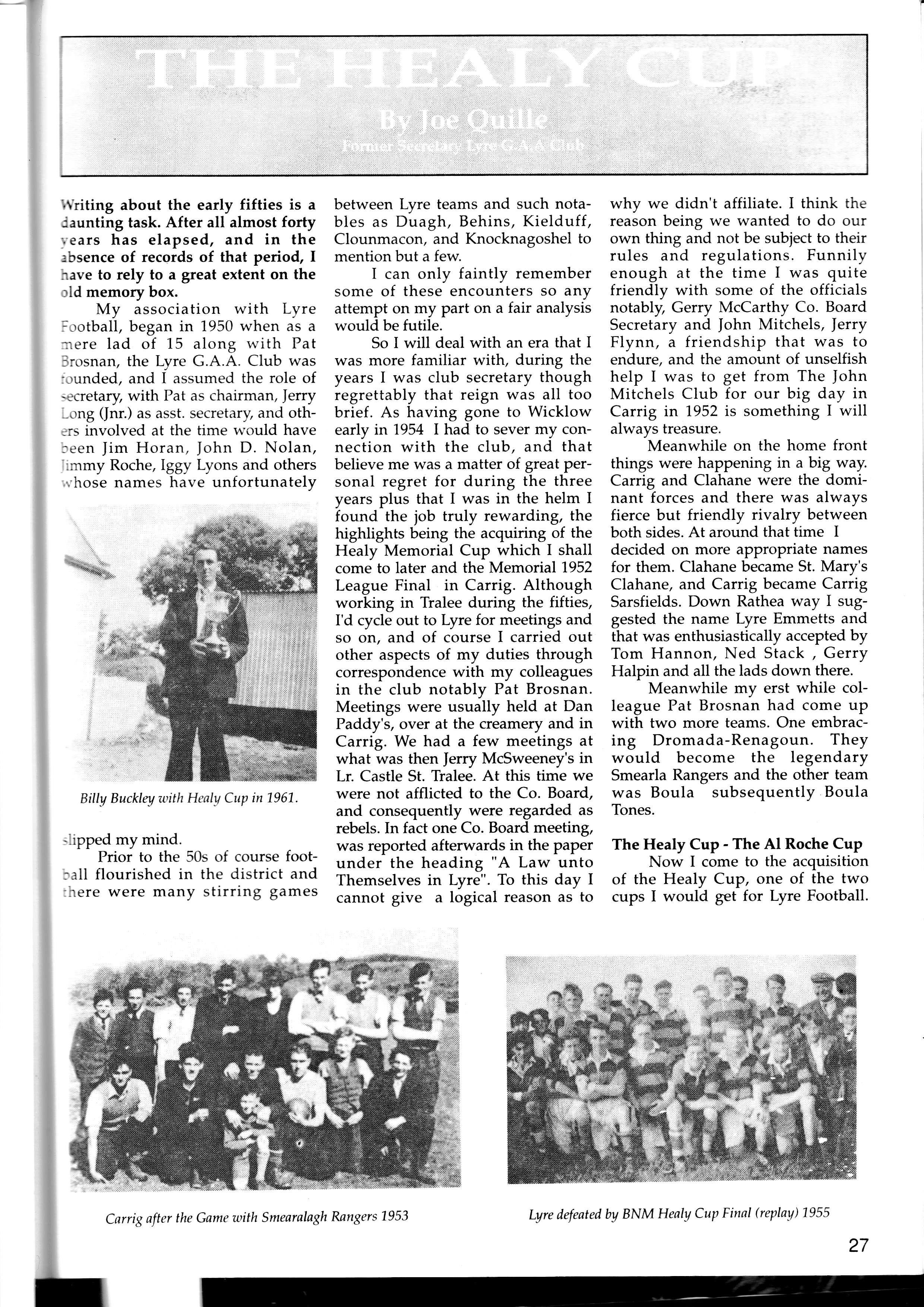
Meanwhile on the home front things were happening in a big way. Carrig and Clahane were the dominant forces and there was always fierce but friendly rivalry between both sides. At around that time I decided on more appropriate names for them. Clahane became St. Mary's Clahane, and Carrig became Carrig Sarsfields. Down Rathea way I suggested the name Lyre Emmetts and that was enthusiastically accepted by Tom Hannon, Ned Stack , Gerry Halpin and all the lads down there.
Meanwhile my erst while colleague Pat Brosnan had come up with two more teams. One embracing Dromada-Renagoun. They would become the legendary Smearla Rangers and the other team was Boula subsequently Boula Tones.
The Healy Cup - The Al Roche Cup
Now I come to the acquisition of the Healy Cup, one of the two cups I would get for Lyre Football.
Billrl Bucklal u,ith Hmlrt Cup in 1961 .lipped my mind.
I Carrig after the Game with Smearalagh Rangers"l95j Lyre defeated bv BNM Healy CuTr Final (replarl) 1955 27
The other would be years later in memory of Al Roche, a dedicated G.A.A. enthusiast and a gentleman of rare qualities. Before going on to deal with the Healy Cup perhaps a brief few words on how the Al Roche Cup,came into being would be of interest to readers the exact year in the 60s I'm not sure of, even though I was no longer active in the G.A.A. circles at home as I was then domiciled in Limerick. It was my earnest hope that under 18 football could be organised in Lyre and the Al Roche Cup would go to its eventual winners. One of my friends in Beamish & Crawford at the time was a chairman, |ack Hillinan. He had been a personal friend of Al's and when I mentioned to fack what I had in mind he was only too happy to help out. I got other contributions from Brownes and McElligotts of Castle Island and with the permission of the Roche family the Al Roche Memorial Cup was launched. However the original intention that it be for the under 18s in Lyre did not for some unforeseen circumstances materialise, and that for me was a matter of deep personal regret, believing in the saying that the Minors of today are the Seniors of tomorrow. However the story has a happy ending. The Al Roche Cup was eventually presented to the North Kerry Board for senior football competition. Maybe it's still there-Idon'tknow.
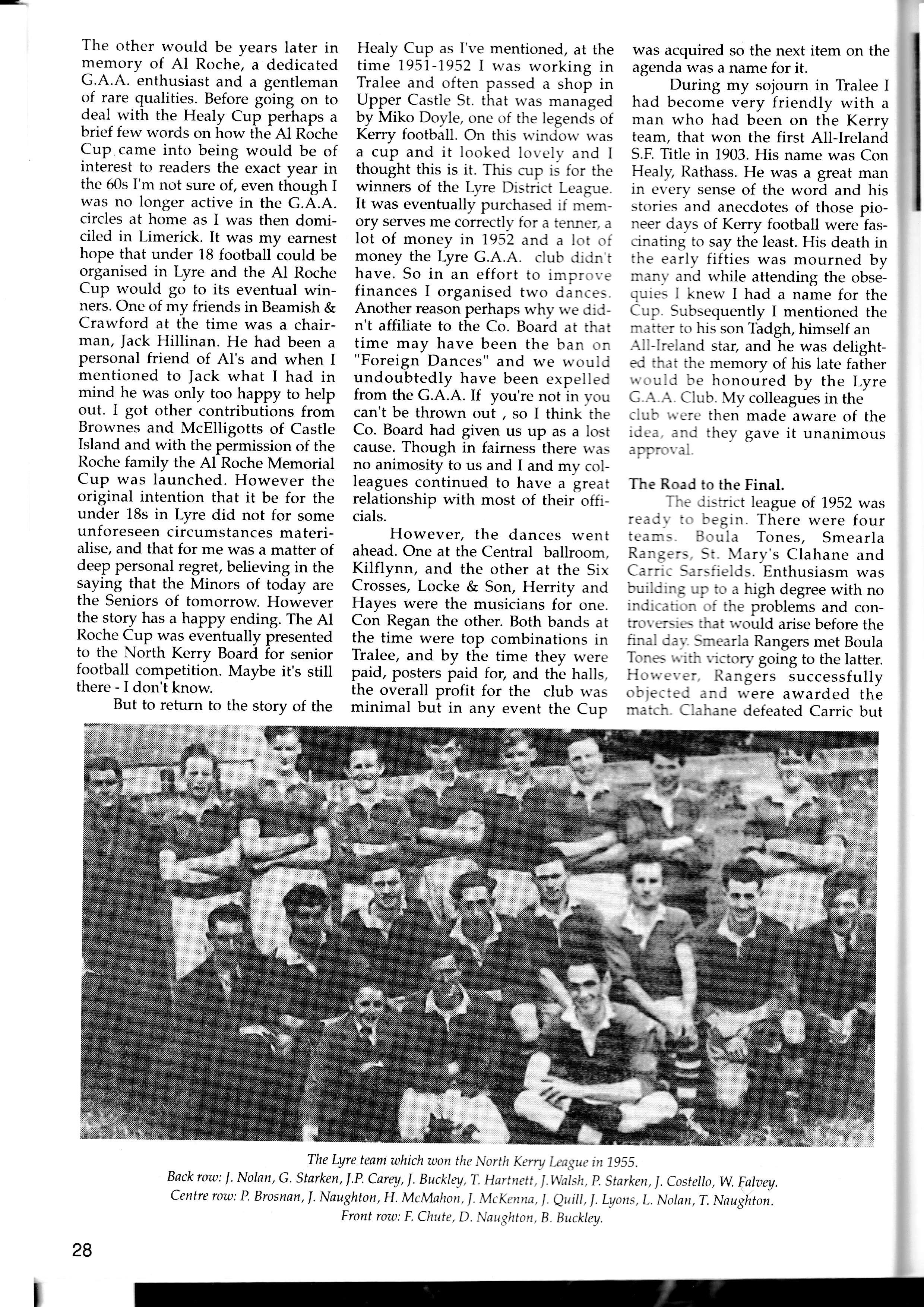
But to return to the story of the
Heal1, Cup-r 35 I'r'e mentioned, at the time 1951-1952 I rvas rvorking in Tralee and often passed a shop in Upper Castie St. that rvas managed by Miko Dor,le, one oi the legc.nds of Kerry football. On this rvindou' \\-as a cup and it looked ir.rvelr' and I thought this is it. Thi: cup r: tr'r thc winners of the Lr.re Di:lrict Lea*r-re. It was eventuallv prrrcha:ej :i :1.:rory serves me correctlr' for a :t r.ner a lot of money in lqil an.l a l .: : money the Lyre G.A.A. club, i::r I have. So in an effort to in.:r, f inances I organised trr't, i a :;Another reason perhaps rvhv rr'.. j:;n't affiliate to the Co. Board at ti-a: time may have been the ban ,..: "Foreign Dances" and r.t,e rr'rruij undoubtedly have been expelle; from the G.A.A. If you're not ln r'.rr-: can't be thrown eut , so I think r1-. Co. Board had given us up as a 1rr>t cause. Though in fairness there rr'as no animosity to us and I and rrl\, ct-rileagues continued to have a grca: relationship r,r'ith most of their orircials.
However, the dances rvent ahead. One at the Central ballroom, Kilflynn, and the other at the Six Crosses, Locke & Son, Herritv and Hayes were the musicians foi one. Con Regan the other. Both bands at the time were top combinations in Tralee, and by the time they u'ere paid, posters paid for, and the halls, the overall profit for the club rr-as minimal but in any event the Cup
was acquired so the next item on the agenda was a name for it.
During my sojourn in Tralee I had become very friendly with a man who had been on the Kerrv team, that won the first All-Irelani S.F. Title in 1903. His name was Con Healr', Rathass. He was a great man in ever',' sense of the word and his stories and anecdotes of those pioneer davs of Kerry football were fas;inatinq to say the least. His death in :hY earlv fifties was mourned byr'::ri. and h,hile attending the obse::^e: I kneu' I had a name for the C';': Subsequently I mentioned the :-.r::.: io his son Tadgh, himself an .:...-.::l.anci star, and he was delight;.r rr.:.i :he memory of his late father',', ',:.: :c honoured by the Lyre C :- 1- C.ub. \4v colleagues in the -.*: '... r:t then made aware of the -jt., t:; rher-gave it unanimous -:.:::-'. -r..
The Road to the Final.
The district league of 1952 was readr- trr begin. There were four teams. Boula Tones, Smearla Rangers. St. \{ary's Clahane and Carric Sarsfields. Enthusiasm was building up to a high degree with no indicalion of the problems and contror-ersis that rvould arise before the final dar'. Smearla Rangers met Boula Tons rrith rictory going to the latter. Horter-er, Rangers successfully objected and n'ere awarded the match" Clahane defeated Carric but
The Lyre team which won the North Kerry kague in 1955.
Back row: I. Nolan, G. Starken,l.P. Carey, |. Buckley, T. Hartnett, |.Walsh, p. Starken,l. Costello, W. Ealaey.
Centre row: P. Brosnan,l.Naughton, H. McMahon,l. McKenna, J. euill,l. Lyons, L. Nolan,T. Naughton.
Front row: F. Chute, D. Naughton, B. Buckley.
28
the latter lodged an objection, and a meeting to deal with this ot'iectirrn n,as held at Dan Paddvs. \1r'self, Jerrv l-ong and the laie E...trtr)o11 Moriarty were representir: Clahane. John D. Nolan, j.P. Carer anJ Iggv Lvons rvere the Carric .lelesates. Pat Brosnan was in the chalr and there rvas a big attendance in tne ha1l.
However, despite rir.rn: argument from delegates .':r ':-rth sides, reqarding the merits : lc nrerits of the objection no Pr(rgres! rt'as made until eventuallt' a pr-':..sal bv Jerry P. Moloney PC. the ci'.r': president that the game be replaved was accepted. Carric SarsirelCs u'on the replay but the saga cirdn i end there. Clahane objected this time. At that time I abhorred ot,iec:rtrns and I still do, for it is mr' .r.ntention that matches should be ".',-.n on the field of play, not off it. Thr. rrf course is a personal vieu', an.-l tlrere are. times when breaches t: a relevant rule must be penalise.i in anv event I managed to persuade mv Clahane colleagues to n'ithdrar',' tht' objection so at last the rr'av rr'as clear for the final and I could flrr\.,' f r-rnC€htrate on making this final a ti:.r trr remember in Carrig.
My personal contacts rvith )ohn Mitchels in Tralee rtere a*ain Put to good use. I asked Getrr*Y \\'are, then an inter county referee , lf he x'ould officiate, and it rl'as a nleasure of his graciousness that ht' instantlY agreed, and brought aiLrnt other members of the club t.r act as umpires, one of whom \\'as a voung Niail Sheehy, later to rlin rr'ide acclaim as Kerry's full back. The John Mitchels Club also lend us their famed green and gold jersies rvhich were worn on the day by Smearla Rangers. The Carrig men had their own jersies green and red -the Mavo colours and here I must comPliment the Carrig club, who had the race course in impeccable condition, goal posts down, and the field lined and io on. I invited our recently appointed P.P. Very Rev. Dennis MoriartY to throw in the ball which he very kindly did and mY thanks to PaddY
Doran and others f or iooking after his rel'erence that day. As I'r,e already mentioned the Con Healy \lemorial Cup would be going to the winners at the end of the match. So I thought that it would be a nice gesture to invite along some of Con's colleagues who were the sole survivors of Kerry's A11 Ireland Football win in 1903. They were Maurice McCarthY and Dinny Curran, Tialee, and Dinny Breen Castleisland. They were delighted to accept the invitation and what's more declined travelling expenses as did our other friends from the |ohn Mitchels club. I should at this point mention the outstanding hospitality offered to our guests by Abbie and Al Roche and by Maggie Mai and Bill Nolan among others. Another big attraction that day was the Scartaglin Pipe Band. I had decided that their Presence would add a touch of colour to the occasion and now thirty-seven years later, I can visualise their arrival in Carrig, and the usually tranquil scene which is Carrig on a Sunday afternoon was shattered by the sound of PiPes and drums.
We had an admission charge or sixpence to the field, and anyone who knows the racecourse can appreciate how difficult it would be to man it properly. It was very oPen, and anyone could pop in over the ditch if they so desired. But there was such a fund of goodwill towards the club that day that few, if anY went in without paylng the sixpence. ]erry Long, the late fack Buckley and others, whose names I can't recall now helped me in collecting the tanners. I can't remember now how much was collected, but I do remember going direct from Carrig that evening to do a date at Clahane Cross with Bridie and mY Pockets laden down with tanners, having had no opportunity of disPosing of them in the meantime.
The Match
And so to the big game itself. As I've said thirty seven years have elapsed, and I'm sure my Carrig and Dromadda friends will forgive me if mv attention to detail is not what it should be. Apart from the laPse of time, mv duties on that Particular day were such that at times I was kind of here, there and everYwhere. Carrig had some fine PlaYers in John D. Nolan, the Connells, AndY
and Sedn, iack \lcKerna IEgt and Ned Lvons, Jimmv iirrche. \e.ieen Somers, \\'ilile Fali ei' ,lr.i the Careys, Richard,\<c a:'l' -
Smearla Ranger= :.'\r :.--r j ::'.r:: stars, notably Humphrer' \lc\1an..i, Sean Healy - later to n'in iurther fame in San Francisco, the Srr'eener'. Peter and Martin, Pat Brosnan, Charlie Collins, Denis Nolan and his brother Eddie, and if rrlemory serves me correctly one or two of the Bernard family and Jim, or was it John, Cronin. The referee as I've mentioned was Georgie Ware, John Michaels Tralee. His task was an easy one. The game itself as I recall was even enough in the first half, but in the second half Carrig asserted their authority and in the end were deserving lt'inners, the final score reading Carrig Sarsfields 3-5, Smearla Rangers 2-2. At the final whistle it was my Pleasant dutY to introduce Maurice McCarthY who then presented the Con HealY Memorial Cup amid scenes of great enthusiasm to John 'DaveY' Nolan, captain of the victorious Carrig Saisfield team and Carrig remained alive for a long time afterwards in celebration.
It was goodbye from me on behalf of the club to our guests from Tralee and Scartaglin, thus bringing down the curtain on what was a memorable August daY in Carrig in 1952.
The Years After
There would never again be the same sense of glamour and excitement as that which was in evidence in 1952.
The following Year due to internal problems in their club, Smearla Rangers did not particiPate in the district league, and eventually Lyre Emmetts met the defending chamPi ons Carrig and again Carrig were victorious. I had a new role that year in that I refereed the game, which was a new experience for me and I must add quite an enioYable one.
'54 turned out a bit of a fiasco with Boula failing to turn out against Smearla Rangers. Carrig beat LYre Emmetts in the other game but the final between Smearla Rangers and Carrig Sarsfields remained unfinished. In the meantime I had gone to work in Wicklow, and subsequentlY, to Limerick thus ending regrettably, may I add, my three Years Plus as secietary of the LYre G.A.A.Club with 1952 being undoubtedlY the highlight.
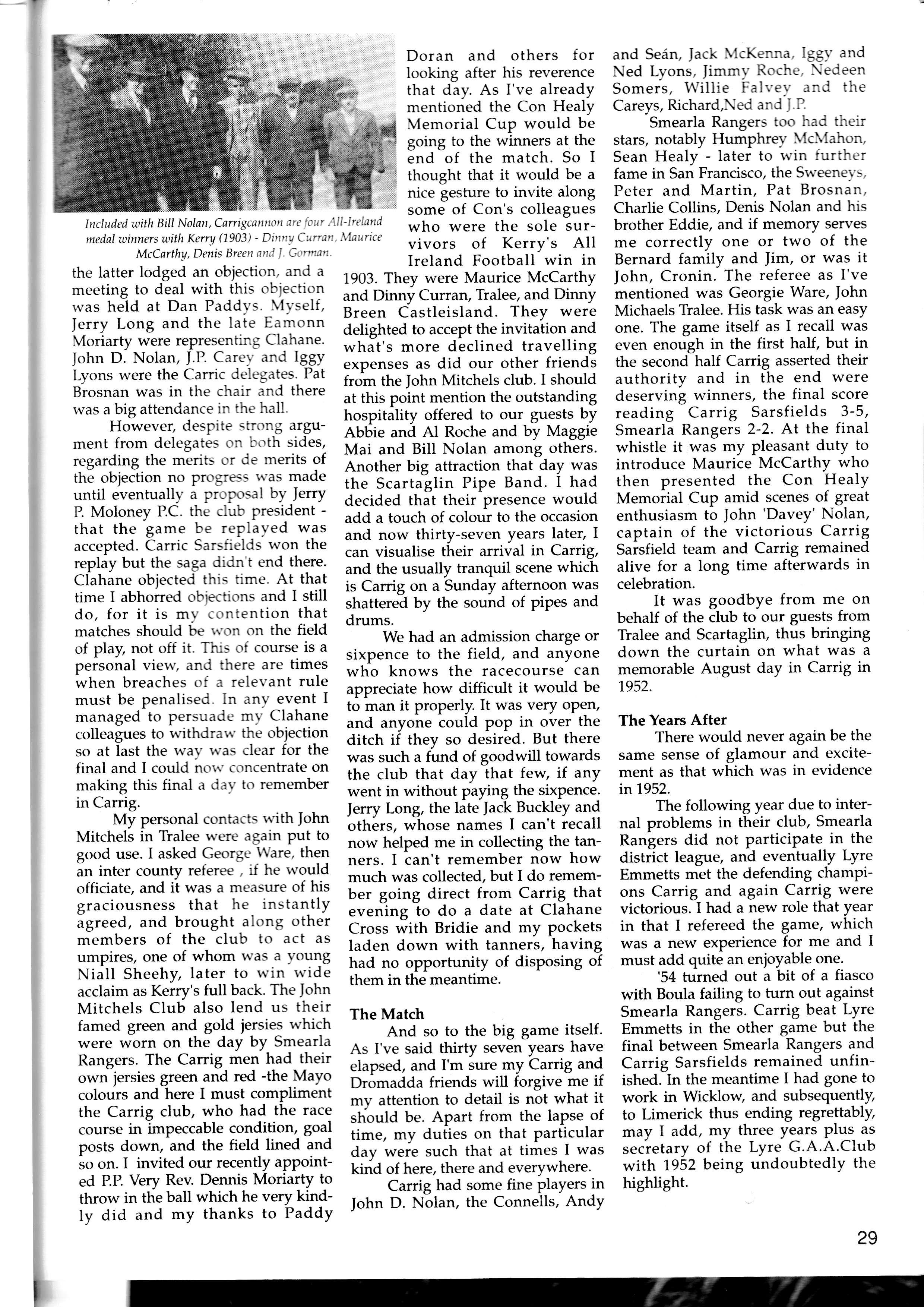 lncluded with Bill Nolan, Carrigcannon are four .All-lreland medal winners with Kerry 0903) - Dirrrrv Curran, Maurice McCarthy, Denis Breen and J Corman.
lncluded with Bill Nolan, Carrigcannon are four .All-lreland medal winners with Kerry 0903) - Dirrrrv Curran, Maurice McCarthy, Denis Breen and J Corman.
29 I
THIruGS WE fiIIIGHT COflSIDER PRESERVING
Being a mountainous area, almost inaccessible from the fertile and highly populated lowlands of North Kerry, Lyreacrompane remained until recently largely uninhabited. This has meant that today we have no castles, no great houses and no ancient tombs. This contrasts with the situation a few miles to the north where Rathea boasts a passage grave and Mountcoal has its HolyWell.
But while we have nothing that might be classed as a National Monument I believe there are some aspects of Lyre's past that should not be allowed to disappear. For example Bord na Mona played a major role in Lyreacrompane from the '30s to the '60s and, in Carrigcannon, into the '70s. Special tools were employed in the turf cutting operation ind these have all but disappeared. The bog was 'stripped' before the machine bf a special wide'bog spade'which had a short bowed t-handle - a real backbreaker. Lumps of bog that fell off the bank were returned to the path of the machine with a special s uarenosed shovel which was of little use for anything else.
While it is still possible to do so,
the best preserved of each of these and other artefacts relating to Bord na Mona should be assembled and put on permanent display at some suitable vantage point in the locality. This might be done by constructing a weather proof display case with a perspex window in which the imple ments etc. could be sealed. A notice in large print, describing their use and a short history of Bord na Monain the Lyre area should also be included for the information of the passing- stranger or the youthful person. Likely sites for such a permanent exhibition might be the tip a Ca\g, the local post office or the tip at Glountain.
The lime kiln or 'kill' as it was pro-nounced locally, was a feature in practi_cally every farm in Lyre up to the 1950s. Limestone was transpbrted from Lixnaw and burnt in the kiln to produce lime to fertilise the land.

Most of these structures have crumbled or have been demolished. At least one should be preserved. Perhaps the one in best cbndition is located near Sheehy'Bridge, just off the Lyre end of the Banemore Road. This summer we hope to clear the overgrowth, point the stonework and
erect a sign giving brief details of hort'the kiln was operated. Any helpin this project would be gieatly appreciated.
\{anv farmyards and sheds contain old farm machinery discarded and iust rusting away. It might make a rrorthrshile project for a school class, l'outh group or retired people's Eoup to assernble the best preserved of each itesr and set them up on permanmt di-splav at a strategic location with app,rcrprrate rrritten information describrng their u- and how theyoperatd. To prer-ent their removal by scap msdLants the site should be in the r-i,lruft- .-i a house and the items clrui - -r rnto a concrete slab v.-hLrch rr'r1.&ri hold them fast. There are Ela:r- :"::-d rmror-ing, rust preventire a-r: -:a-pie F\alnts on the market nfir* ;;q} he wrployed in the task
The att-re ={:€..ans rvould, if implemenre: =-air.e i_rre a more interestine s--= :,- r-i the native and the i-::i[:!-r Jr ;,;sr lsould be small and arr --jE= gn:rated from the sale cr * -= :-=rl3 issues of the Lvrea.-:--=:i:€ :ni District )ournil rt-oqii - =a- asarlable for any s-lch F"ril:lc.
E
^i
lrc Fitzge_rald t'amily, Knocknaglo_ugh, celebrating the Golden lubilee of St. Hillary,sPrcfession..Margaret Walsh, Nori Stick, Sr. Eiteenj pakistan, Si. ttittan/, London, SRM Aletrc. Prestntation Conuent Trolee, Rose Shcehq. Back: lct & iiichael.
H. 5 30
foe Haningho
E*"&I Lr ! l= J I
-HE shortest road "om Limerick to - ralee doesn't go :'r rsugh Castleisland, : nd at doesn't go 'rrough Ligtowel. lt I o es between the :wo. After Ab: eyfeale, having -- one about two -niles, there is a turn : o the right, there the 'oad crosse$ a river, 'cllowed by a sharp :urn to the left, and tsob's your uncle un: il you arrive at Tralee racecourse.
The first place one :rassas (or misses by a rew hundred yardsl ir : hat great metroPolir with the magical sounding namo of Knocknagothel, 'enowedn in song and ctory (the song is eimPle and goer ar followr: 'Abbeyf eale, Abbeyfeale, Abbeyfeale, Abbeyfeale, Abboyfeale, Knocknagoohel and Duagh'). The story on tho other hand,, refore to a Parnelite meeting held at Abbeyfeale, at which the rtaunch and hardy People of Knocknagorhel arrived with a banner proclaiming: 'Arige, Knocknagoshel, and take your place smong the Nationr of the Earth'.
Tho little road windr onward and uPward, Paat a place which hardlY exists at all; but which hag the even more magical name of LyreocromPane. You arrive at the outsxirts ol this fabled Place as you cross the Mearla river. This river, in Summer, is benign, whitestoned, clgar-watored, grass-verged or reedverged, its trickle-sound mingling with the twittersound of the birds and the fickle feathery sound of the breeze through the flat heather on the treeless, tireless, timelacs landocaPe. ln Winter the flood and ureathor wreak vengoanco for the mollYcoddling Summer daYs.
And, as ono comoa uP from the awkward bridge over tho awkward river, built by en awkward Peo-
KI{OCKNAGOSHEL AND BEYOND
ple in awkward aYs, one comes to a croSaroads. Straight on, Tralee; to the right, the Six Crosges, and Finuge, or Listowel if your fancy takes You; and to ths lsft, the descent into Castleisland. You have arrived at Reanagown Crossroads.
And at this crossroads, in the middle of the Stacks Mountains, desolate and bare, lies the hoa!'t of ons of the most evocative, most entertaining and most informative books to como on the market in recont tames. lt is also a book which proves beyond a doubt that John B. Keane ir not just a funny writor, but that he haa a brilliant eye for what was, and remains amportant in the liver of any civiliced, thinking, caring peoPle.
After a lapse of some yearr into aomewhat flippant writing, in which many, including this writer, had felt that John B. might have fallen into the trap of trading on hie name lor commercialirm alone, Dr. Keane has confounded all critica with hir work on the exploits, times, friends and relationr of Dan PaddY AndY, of Reanagowan Crossroads tho last of the groot Kerry matchnukerl, owner ol a ballroom of Practical romanco, philoroPher, rage, and 3cou?go of trryo generationa of clergy.

Keene haa alao ghown that the ordinary Engligh as epoken in North Kerry has retoined tho onomatopooic lYricirm of lrish, the clinical Precirion of Latin (the eecond language of the clergY, who were the leaderr of rocietyl, ac well as tho native Kerry qualitier of oproariouc underrtatement and healthY cyniciem. One foels that if the Hydrogen bomb were to fatl in Ahtlone, all of lreland would diraPPear, leaving Kerry untouched. And if ! stray irotope or
two managed to penotrate the Kingdom, there would be holY mayhem, but tho Peopla would !ay, aa did Dan Paddy Andy:- 'M'anam on diabhal, ien't a row a noble thing'.
tn truth, John B. might ac welt have been telling of the faction fight! at Cappawhhe or Doon; of the rivalriea and loveo in Broadford (elther of them, come to think of itl, or the Gurkiea or Foatheriec of old Limerick itoelf. The formula ir agelear: take an identifiable communitY, hill, dats or citY; add a Por8on or peopte who are out of the ordinary, and who doee do strange things; add a cuperb writer with a tuned ear for the music of tho language and a hawk eye for the loalong and their colours.
ln addition, this book (MAN OF THE TRIPLE NAME, Brandon, f4.95 paperback) tellc ar much about John B. than it doer of Dan PaddY AndY. Whether Keane antondod it or not, he uses Dan as a vehicle - a time machinein which to travel back to his own Youth. And traces of that Youth, however faint or distinct, are in every ono of us oven y€t. tn fact Keane is himself part of tha agelecs formula too: take
a definable communitY (Listowel and ite hinterlandl, add a Peraon out of the ordinarY (and who could be more ao than a publican who writes intornationallY bert-aelling playr and books? BrYan McMahon waa 6 teach€r, ro hig literary exPloitc woro more erPected). And add the alter-Keane, who can write his own story through the eYea of another.
John 8'c latert book provot three thinge: Firatly, it ahowa that laterature and Powerful storio! need not involve Tolstoy and hie kind, writing on tho livee of kings. SeeondlY, it dsmonstratos that, when one is immersed in a culture and itg PooPle, it takes a sPecial ckill to identify the obvious and, finally, it shows that, with a bit of application, there should be a John B. in every parieh.
Rarely does this Paper devoto such sPace in praise of a book (unpaid and unbidden, let us add)But it ie as bright as a turf fire btazing an wantoT, and aa warm; it ie a Picture more faithful than anY camora could Produce, and thir book will stand as a tottamont to John BKeane for longer, and leea weatherod than will hir headfione - when, that ir, he finde occasion to require one.
Martin BYrnee
From the'Limerbk Echo' June 2, l9&4
Paddy Dillone andNora, Clountnne, a'lfh Siss Nolan and other relatit,e (1933).
31
with Ioe Quille
Former Lyre Conespondent withThe Kerryman
St. Mary's G.A.A. Club Clahane 1952
Officers elected at the Annual General Meeting of the above club, Joseph Quille presiding were:
President - Joseph Quille Vice Chairman - Eamonn Moriarty Secretary - f erry Long (f nr.), Treasurers - Christy Quille, Sean Dillon. Delegates to iyreacrompane 9.A.A. ,Club - foe Quille and jerry Long (fnr.). Committee - Kevin heehy, Ted Moriarty, To* Horgan, ].]. S-ngeny, T. Barry Ml. McEllifott, Ned Dillon, M.I. Costelloe. S.F. Captain - Teddy Moriarty. M.F. Captain - fohn Quille.
Lyreacrompane G.A.A. Convention lanuary 1957
"It is not for us as members of a national sporting organisation to either condemn or condone the activities which led to the untimelydeaths of these two patrioticIrishmen", said Mr. Pat Brosnan, Chairman, when he proposed a resolution of sympathy (passed unanimously) to the relatives of Se6n South and Fergal O'Hanlon at theAnnual General Meeting of Lyreacrompane G.A.A. Club at Carrigcannon on Sunday.
The report of the treasures showed a debit balance of f,I.9s.
The following officers were elected:
Patron - Very Rev. D. Moriarty p.p. Duagh (outgoing).
President - Albert Roche (outgoing). Vi_ce Presidents - Jerry P. Moloney P.C. (outgoing) and Harry Starken. Chairman - Pat Brosnan (outgoing). Vice Chairman - John D. Nolan. Secretary - |.P. Carey (outgoing). |oint Treasurers - Chairman and Secretary.
Delegates to North Kerry and Co. Board - J.P. Carey and Pat Brosnan. Selection Committee - John D. Nolan, Tom Naughton, P. Nolan, Pat Brosnan, Richard Carey.
Team Manager - John D. Nolan. Intermediate Team Captain - lgsy Lyons.
Committee - joe Quille, T. Cronin, D. Sugrue, Jerry Long (fnr.), Darby Naughton, F. Ahern, Jimmy Roche, J.
Walshe, Tim Neville and Dan Doran. Healy Cup Committee President - |oe Quille, Chairman Tim Horan. Vice Chairman - ]ackMcKenna, Secretary - IgW Lyons all outgoing.
Feb.25th 1957
The death at an advanced age has taken place of Mr. Jack Quilli,Gortclohy. He was brother of Mr. Thomas Quille, Clahane, Mrs. M. Lyons, Carrig and Mrs. William O'Connell, Lissahane, Lixnaw.
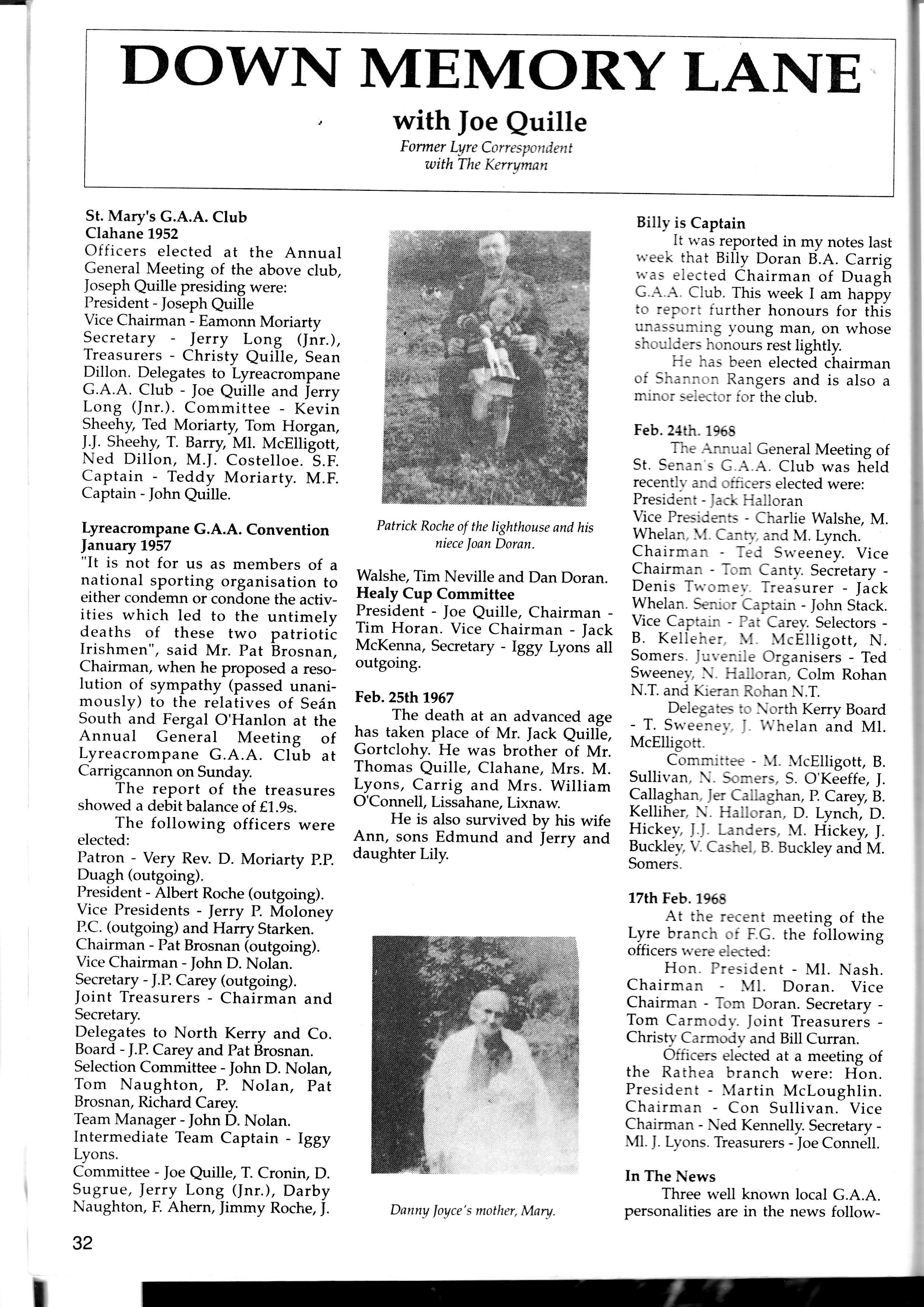
He is also survived by his wife Ann, sons Edmund and Jerry and daughter Lily.
Billy is Captain
It was reported in my notes last h'eek that Billy Doran B.A. Carrigrtas elected Chairman of Duagh G.A.A. Club. This week I am happyto report further honours for this unassuming young man/ on whose shoulders honours rest lightly.
He has been elected chairman of Shannon Rangers and is also a minor -iector for the club.
Feb.24th. 1!)'5E
The Annual General Meeting of St. Senan s G.A.A. Club was held recentlv and officers elected were: President - Jack Halloran
Vice Presidmts - Charlie Walshe, M. Whelan, \1. Cantl', arrd M. Lynch. Chairman - T;d Sween'ey. Vice Chairman - Tom Canty. Secretary Denis Trsomer-. Treasurer - fack Whelan. Senior Captain - Iohn Siack. Vice Captain - Pat Carey. Selectors B. Kelleher, \t. McElligott, N. Somers. Juvenile Organisers - Ted Sweenev \. Halloran, Colm Rohan N.T. and Kieran Rohan N.T.
Delegates to \orth Kerry Board - T. Sweener', J. lVhelan and Ml. McElligott.
Committee - !I. McElligott, B. Sullivan, \. Somers, S. O'Keeffe, |. lallaghan, fer Callaghan, P. Carey, B. Kelliher, \. Hatlorin, D. Lynch, D. lickey, ].J. Landers, M. Hickey, J. Buckley, V. Cashel, B. Buckley and M. Somers.
17th Feb.1!)56
At the recent meeting of the Ly_re branch of F.G. the following officers rvere elected: Hon. President - Ml. Nash. Chairman - Ml. Doran. Vice Chairman - Tom Doran. Secretary Tom Carmodv. Joint Treasurers Christy Carmodv and Bill Curran. Officers elected at a meeting of the Rathea branch were: Hon. President - Martin Mcloughlin. Chairman - Con Sullivan. Vice Chairman - Ned Kennelly. Secretary Ml. ]. Lyons. Tieasurers - ]oe Connell.
In The News
Three n'ell knorvn local G.A.A. personalities are in the news follow-Danny loyce's mother, Mary
DOWNMEMORYLANE
32
Patrick Roche ot' the lighthottse and his niece loan Doran.
Danntl lorlce , Billtl Nolan, Willie Edgeutorth.
ing recent conventions.
Billy Doran Carrig is the new Chairman of the North Kerry Board. Pat Brosnan formerly of Dromadda has been elected Vice President of Athea G.A.A. club and Denis Horgan, Cloghane, is Secretary of St Brendan's District Board. This is indeed a great honour for their native Lyre and on behalf of their many friends here I extend warmest congratulations.
lTth April1968
Lyreacrompane's wedding of ::1e year took place on Thursday of .ast rveek, when Mr. James Roche ,..-ell known licensed vintner, son of \Irs. A. Roche and the late Mr. Albert Loche, Carrigcannon, married Miss'..an Enright, daughter of Mr. & Mrs.ratrick Enright, Glashnanoon.
The ceremony with Nuptial l.lass and Papal Blessing at the -hurch of the Sacred Heart, Lyre,'.rs performed bv Very Rev. T. I Sullivan P.P., Duagh.
Miss Christine Haves (cousin of'= bride) was bridesmaid and the ::st man was Gdrda Joe Carey -.usin of the groom).
Seventy guests attended the -=:eption at the Grand Hotel Tralee.
-ate Mrs. M. Lynch
Sincere regret was occasioned -:oughout the district by the death :. \Vednesday of last week of Mrs. larv Lynch (nee McElligott) of : : trcknacurra, Lyreacrompane, rich occurred at the residence of .r daughter, Mrs. John Moloney, :rrnada.
A rnember of a highly esteemed,rrilv deceased who had reached an :,.'anced age, was a great friend and
neighbour, and enjoyed well deserved popularity in the district. The universal respect and affection in which she was held by all were testified by the huge cortege that followed the remains to the Sacred Heart Church, Lyre, where Solemn Requiem Mass was celebrated for the repose of her soul. Her funeral to O'Brennan Cemetery on Thursday was extremely large and representative.
The late Mrs. Lynch is survived by her sons, daughters, sons-in-law, daughters-in-law, grandchildren and relatives to whom the sympathy of the entire community is extended.
July 5th 1958 Sweep Win
Big news on the home front during the week was the winning of €100 in the Sweep. The ticket which was sold bylocal postmaster Mr. Cornelius Nolan, was shared by Messrs. fohn Mahoney, Dromada, Paddy Hickey, Knockanebrack, |ack Naughton, Knocknaclare and Mick Naughton, Glashnacree.
The Late Mick Sweeney
Sincere and widespread regret was occasioned in the district by the death of Mr. Michael Sweeney which occurred at his residence, Broughane.
The exceptionally large attendance at the removal of the remains to Knocknagoshel Church, and at the funeral which took place to the new cemetery Castleisland, bore adequate testimony to the high esteem in which deceased was held.
St. Senan's football team followed the good example of their hurlers when they defeated Clounmacon in the first round of the Frank Sheehy Memorial Crp. Although their margin of victory wis not as high, 0-6 to 0-2, their performance was however, quite impressive.
Scorers Ted Sweeney 0-3, P. Carey 0-2 and J. Hayes 0-1 and the team was P. Buckley, K. Lynch, M. Hickey, P. Drughton, J.Walshe, D. Twomey, D. McCarthy, P. Carey,l. McCarthy, T. Quiltea T. Sweeney, I.
Hayes, J.J. Buckle1,, C. Walshe ancl V. Carey.
7th September 1958
The death of Mr. Thomas Quille, Clahane which occurred at his residence recently evoked widespread feelings of regret in the district.
Deceased who was in his 83rd year is survived by his wife Margaret, sons Christy, Clahane, Tim, Chesterfield, England. Joe, Cecil St., Limerick and |ohn, New York and by his sisters Mrs. M. Lyons,Carrig and Mrs. W. O'Connell, Knockbrane, Lixnaw.
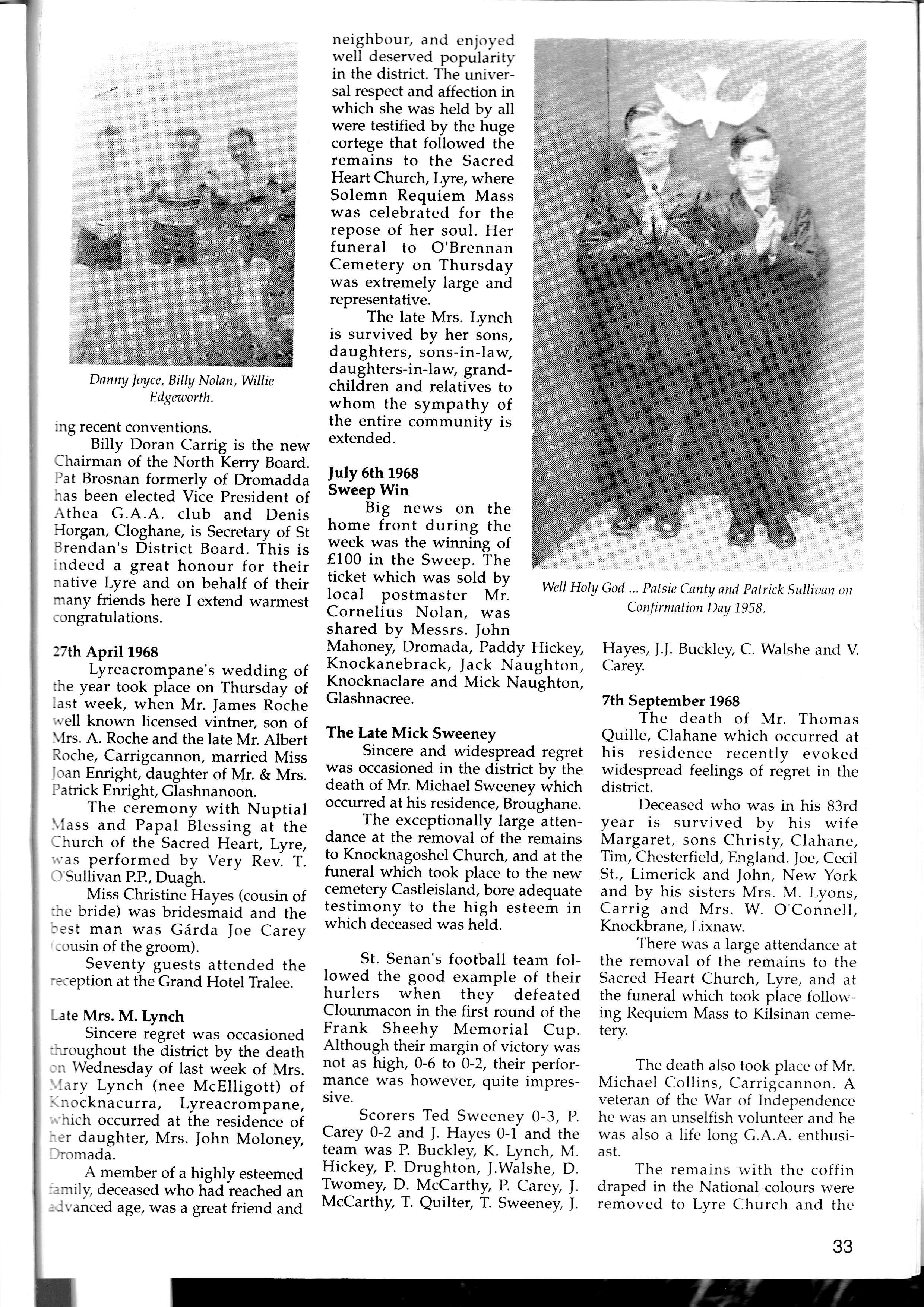
There was a large attendance at the removal of the remains to the Sacred Heart Church, Lyre, and at the funeral which took place following Requiem Mass to Kilsinan cemetery'
The death also took place of Mr. Michael Collins, Carrigcannon. A veteran of the War of Independence he was an unselfish volunteer and he was also a life long G.A.A. enthusiast.
The remains rvith the coffin draped in the National colours were removed to Lyre Church and the
Well Holy God Pntsie Canty and Patrick Sullitan on Confirnntittn Datl 1 958.
33
funeral Requiem Cemetery.
took placeMass to following Knockane
Wedding Bells
_ The marriage took place in Birmingham recently of Miss Ann Nolan, daughter of Mr. & Mrs. Moss Nolan, Lyreacrompane, and Mr. Malachy Lyons a former Kilkenny hurler.
Sept.14th 1968
The Late Ml. Dillon
With the death over last weekend of Mr. Michael Dillon, Clahane, at the residence of his daughter, Mrs. Dick Twomey, Gortclohy. :Kilflynn, yet another link with Lyre's storied past has been severed.
Attendances at the removal of remains to Kilflynn Church and at the funeral following Requiem Mass at Kilsinan Cemeterli were large and representative.
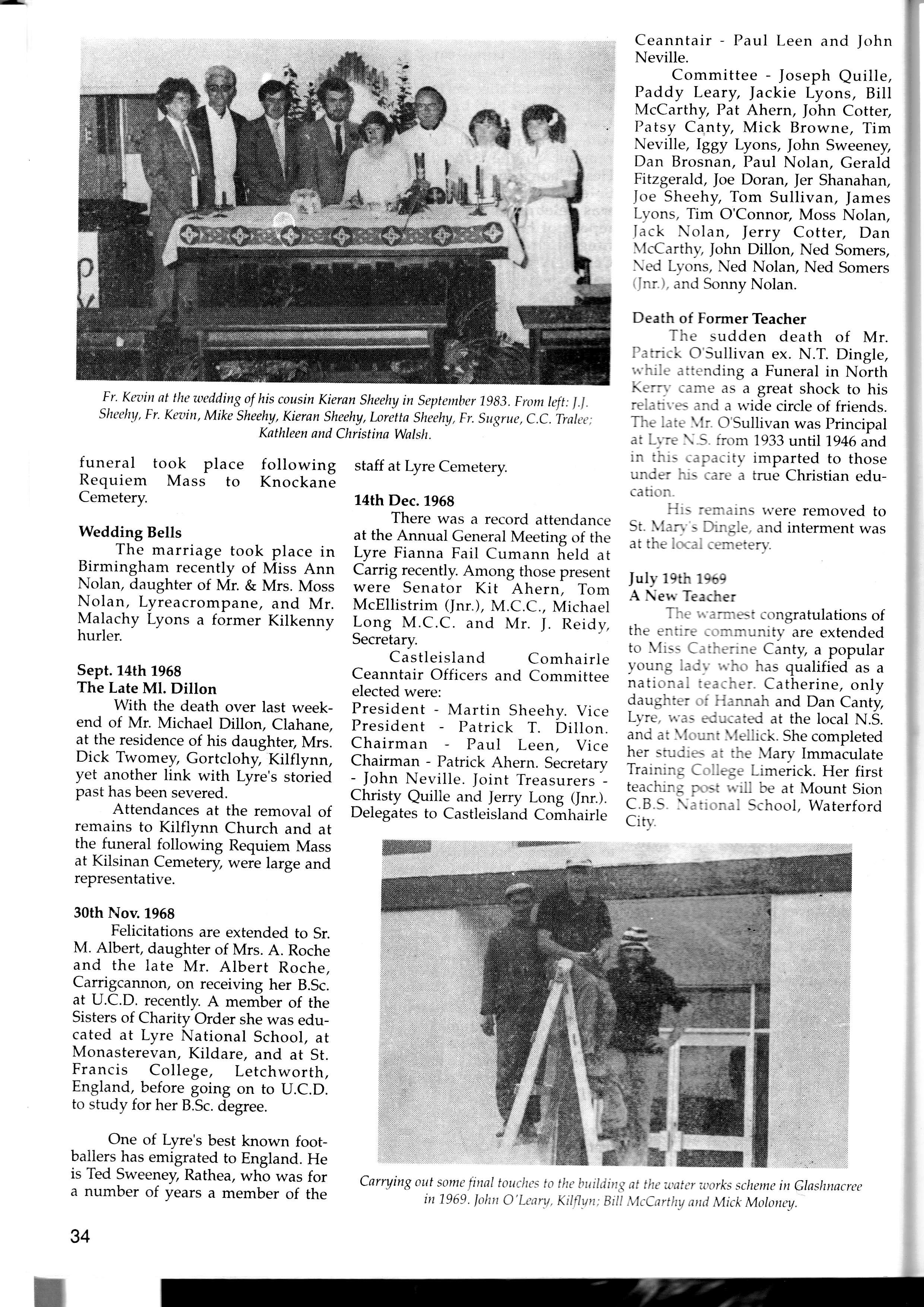
30th Nov.1968
Felicitations are extended to Sr. M. Albert, daughter of Mrs. A. Roche and the late Mr. Albert Roche, Carrigcannon, on receiving her B.Sc. at U.C.D. recently. A member of the Sisters of Charity Order she was educated at Lyre National School, at Monasterevan, Kildare, and at St.Francis College, Letchworth, England, before going on to U.C.D. to study for her B.Sc. degree.
One of Lyre's best known footballers has emigrated to England. He is Ted Sweeney, Rathea, who was for a number of years a member of the
staff at Lyre Cemetery.
14th Dec. 1968
There was a recrtrd attendancr. at the Annual General Meeting of the Lyre Fianna Fail Cumann held a t Carrig recently. Among those present were Senator Kit Ahern, Tonl McEllistrim (Jnr"), M.C.C., Michael Long M.C.C. and Mr. J. Reidr,, Secretary.
Castleisiand Comhairle Ceanntair Officers and Comrnittee elected were: President - N{artin Sheehv. Vice President - Patrick T. bilto.r. Chairman - Paul Leen, Vice Chairman - Patrick Ahern. Secretarv - john Neville. Joint Trr,asurers Christy Quiiie and Jerry Long (]nr.). Deiegates to Castleisland Comhairle.
Ceanntair - Paul Leen and John Neville.
Committee - Joseph Quille,Paddy Leary, Jackie Lyons, Bill McCarthy, Pat Ahern, ]ohn Cotter, Iratsy Canty, Mick Browne, Tim Nevilie, Iggy Lyons, Iohn Sweeney, Dan Brosnan, Paul Nolan, Gerald Fitzgerald, joe Doran, Jer Shanahan, Jtre Sheehy, Tom Sullivan, James Lvons, Tim O'Connor, Moss Nolan, Tack \olan, ]erry Cotter, Dan \1;Carthr', John Dillon, Ned Somers,\t.l Lvons, )Jed Nolan, Ned Somers r-: f,r1rl Sonny Nolan.
Deeth of Fonner Teacher
The sudden death of Mr. Patrick O'Sullivan ex. N.T. Dingle, r*'hile attending a Funeral in North Kerr)'came as a great shock to his relatives and a wide circle of friends. The late Vr. O'Sullivan was Principal at Llne NS. from 1933 until 1946 and in this capacity imparted to those under his care a true Christian education-
His remains were removed to SL Man"s Dingle, and interment was at the local ceryretery.
fuly 19h 196,9
A New Teacher
The r,r-arrrest congrafulations of the entire community are extended to Miss Catherine Canty, a popular young ladn r,t'ho has qualified as a national teacher. Catherine, only daughter of Hannah and Dan Canty, Lyre, n'as educated at the local N.S. and at Mount Mellick. She completed her studies at the Mary Immaiulate Training College Limerick. Her first teaching post wiI be at Mount Sion C.B.S. National School, Waterford Citv.
F.r. Kn,in ot the ruedding of his cousin Kieran Sheehy in Septonbcr 1gg3. Fronr l$t: | Sltcthy,| Fr. Ktrtin, Mike Sheehy, Kieran Sheehy, Loretta Sheehy, Fr. Srryruc, C.C. Tt.ttltt Kathleen and Christina Walsh.
Carrying out some final touches to the buitding at the water works scheme in Glashnacree in 1969.lohn O'kary, Kilflvn; Bitt McCarthy and Mick Moloney.
I 34
School Closed
As part of the Dept. of Education's amalgamation of smaller schools, Maugha N.S. has closed and the pupils there will be transferred to O'Brennan. O'Maugha has been a one teacher school, a position that was held by Miss Dowling.
Sept. 2nd. 1968
Youth at the Helm
Our voung boys and girls were certainly in the news last week. At the Feis in Ballylongford the following were very much to the fore in the Jancing competitions.
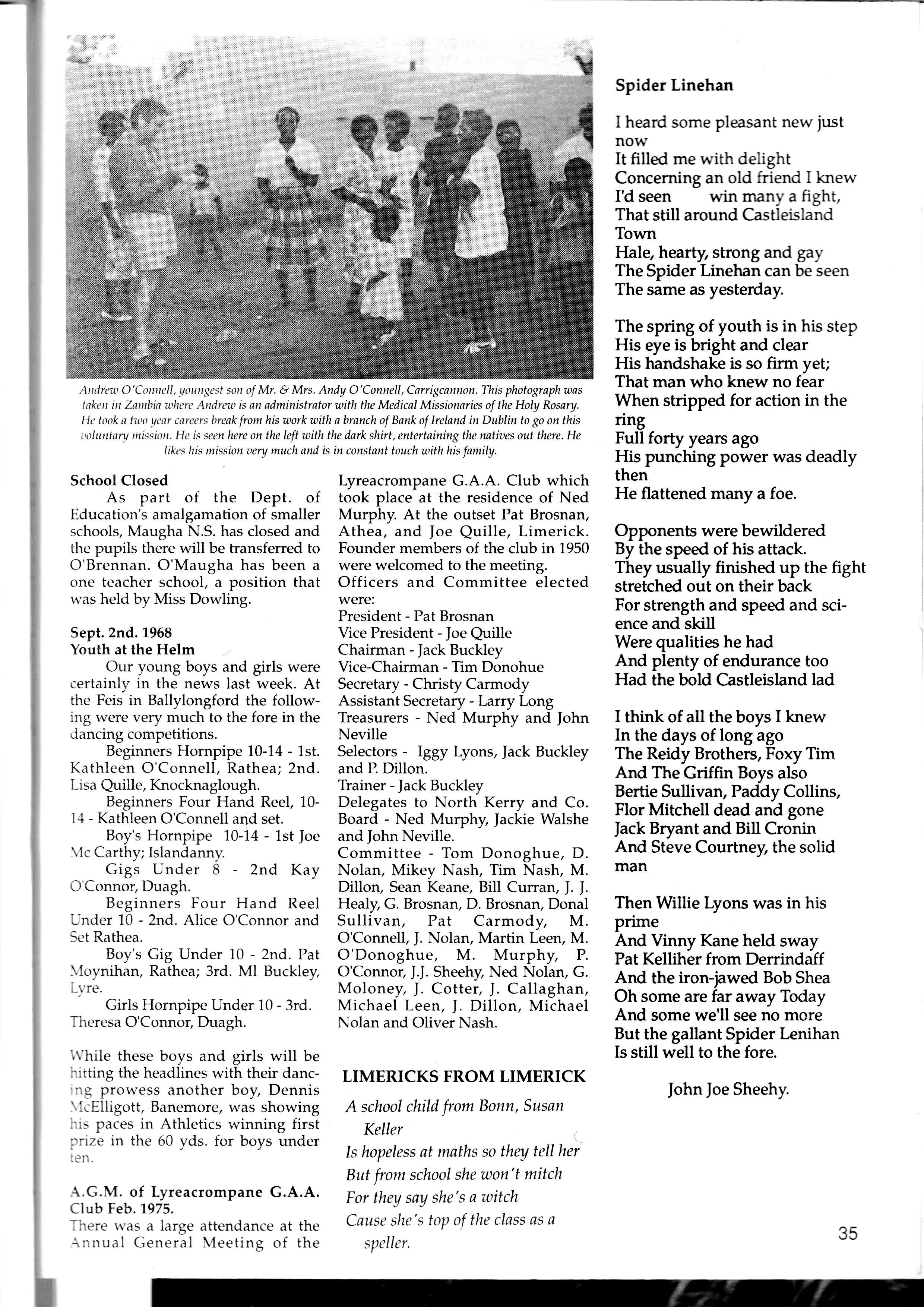
Beginners Hornpipe 10-14 - 1st. Kathleen O'Connell, Rathea; 2nd. I-isa Quille, Knocknaglough.
Beginners Four Hand Reel, 101-i - Kathleen O'Connell and set.
Boy's Hornpipe i0-14 - 1st Joe \1c C;rrthy; Islandannv.
Gigs Under 8 - 2nd Kuy'i Connor, Duagh.
Beginners Four Hand Reel Urrder 10 - 2nd. Alice OConnor and Sct Rathea.
Boy s Gig Under 10 - 2nd. Pat ),1ovnihan, Rathea; 3rd. Ml Buckley, -\'IC.
Girls Hornpipe Under 10 - 3rd. ireresa O'Connor, Duagh.
.,\-liile these boys and girls will be .'rrting the headlines with their danc:'.9 pro\.vess another boy, Dennis ' 1.Elligott, Banemore, was showingi: pacc's in Athletics rtinning first ::rze in the 60 vds. for boys under :-I
-A,.G.M. of Lyreacrompane G.A.A. Club Feb.1975.
There lvas a large attendance at the .{nnual General Meeting of the
Lyreacrompane G.A.A. Club which took place at the residence of Ned Murphy. At the outset Pat Brosnan, Athea, and |oe Quille, Limerick. Founder members of the club in 1950 were welcomed to the meeting. Officers and Committee elected were: President - Pat Brosnan Vice President - foe Quille Chairman - Jack Buckley Vice-Chairman - Tim Donohue Secretary - Christy Carmody Assistant Secretary - Larry Long Treasurers - Ned Murphy and |ohn Neville Selectors - lgsy Lyons, |ack Buckley and P. Dillon.
Tiainer - |ack Buckley Delegates to North Kerry and Co. Board - Ned Murphy, ]ackie Walshe and |ohn Neville.
Committee - Tom Donoghue, D. Nolan, Mikey Nash, Tim Nash, M. Dillon, Sean Keane, Bill Curran, |. |. Healy, G. Brosnan, D. Brosnan, Donal Sullivan, Pat Carmody, M. O'Connell, |. Nolan, Martin Leen, M. O'Donoghue, M. Murphy, P. O'Connot ].]. Sheehy, Ned Nolan, G. Moloney, ]. Cotter, |. Callaghan, Michael Leen, |. Dillon, Michael Nolan and Oliver Nash.
LIMERICKS FROM LIMERICK
A school child t'rom Bonn, Susan Keller
ls hopeless at maths so they tell her But frorn school she won't mitch For they satl she's n ittitch Cnusc she's topt of the class ns n spelltr.
Spider Linehan
I heard some pleas.lnt new just now Itfilled mewithdelight Concerningan old fr:ieilt I lcrew I'd seen win many a fight, That still around C-asileisland Town
Hale, hearty, strong and gay The Spider Linehan can be seen The same as yesterday.
The spring of youth is in his step His eye is bright and clear His handshake is so firm ye$ That man who knew no fear When stripped for action in the ring
Full forty years ago
His punching power was deadly then He flattened many a foe.
Opponents were bewildered By the sped of his attack. They usually finished up the fight stretched out on their back Forstrength and sped and science and skill Were qualities he had And plenty of endurance too Had the bold Castleisland lad
I think of all the boys I knew In the days of long ago The Reidy Brothers, Foxy Tim And The Griffin Boys also Bertie Sullivan, Paddy Collins, Flor Mitchell dead and gone ]ack Bryant and Bill Cronin And Steve Courtney, the solid man
Then Willie Lyons was in his prime And Vinny Kane held sway Pat Kelliher from Derrindaff And the iron-jawed Bob Shea Oh some are far away Today And some we'll see no more But the gallant Spider Lenihan Is still well to the fore.
]ohn joe Sheehy.
.\nLlrnL,O'Contnll,;lorirrtrs/5p11 1rfMr. EMrs.Andy()'Connell,Carrigcannon.T'hisphotographuas ltkt'tt itt Zanfuia iL.ltt'rL' Atl"lrt'.a, is an adrninistrator urith tltc Medical
Missionnries of lhe Holy Rosary.
Ht, took a ti:,o r1,,Ltr cnrtL,rs ltrcak frottr his tL,ork utith a branch of Bank of
lrcland in Dublin to go on this
, oltrrrtdrtl lrissirrir. Hr is s.rn ht:re on the left with the dark shirt, mtertaining the
natiues out there.
He /itcs lris niissiun tery nuch and is irt constant touch utith his
family.
35
James ferome Kennelly, who wrote the story of "The Kelly Gang",lived in Essendon, Australia in the 1940s. He was a strong supporter of the Labour Party and on one occasion unsuccessfully contested a Parliamentary seat for the Party.
His mother, |ulia Dillon, came from Lyreacrompane and arrived in Australia on the 10th of August, 1865 with four children, foan, Matthew, Nora and Dan who died on 16 of ]uly 1933. Another child, Patrick, had died in Listowel.
|ames ). Kennelly had married |ulie Dillon in Fermoy around 1850 and had preceeded her to Australia in 1961.
Other children born to the couple after they arrived were Julia, (now Mrs. Ryan), Ieremiah who died 31st August 1884, James |erome (the writer), Elizabeth and Mary who became Mother Benedict of the Presentation Convent, Winsor, Melbourne.
Matt became a farmer at Eleven Mile Creek, Glenrowan West, Victoria. ]ames |erome was first cousin to Margaret Kennelly who married Dan Donoghue of Duagh. His grandfather lived near Woodview, Athea, and had a very large family. fohn T. Flaherty of Knockanure remembers it being said that Kennelly used to go to Listowel and bring home a bag of shoes of several sizes. He would throw the shoes in the middle of the kitchen. After the free-for-all, any shoes that didn't fit were taken back to the shoe maker.
A LIST OF PRIESTS, BROTHERS AND SISTERS FROM DUAGH AND LYRE
Fr. Kevin Sheehy
Fr. Pat O'Connor (d)
Fr. Mce. O'Connor (d)
Fr. |ames Molyneaux (d)
Fr. )ohn Molyneaux (d)
Fr. |ames McElligott (d) Fr. john Nolan
Fr. Denis Moloney (d)
Fr. Brian Starkin Bro. Thomas Enright Bro. Christopher O'Connor Sr. Philomena Sheehy Sr. Mgt. O'Connor Sr. Catherine O'Mahony (d) Sr. Pauline Moloney (d) Sr. Pauline Moloney Sr. Brigid Moloney Sr. Elizabeth Moloney Sr. M. Anne Dillon (d) Sr. Berchmans Kennelly (d) Sr. Concepta Kennelly Sr. Margaret M. Murphy (d) Sr. Teresa Murphy (d) Sr. Maura Nolan Sr. Elizabeth Starkin Sr. Elizabeth Roche Sr. Mary Rose Gleeson Sr. Walter Gleeson Sr. Eileen Enright Sr. Adrian Doran Sr. Hannah Ahern Sr. Mary Ahern Sr. Elizabeth Gorman Sr. Elizabeth Ahern Sr. Alexis Fitzgerald Sr. Hilary Fitzgerald Sr. Eileen Fitzgerald Sr. Mary Dillon Sr. Nora Dillon Sr. Dympna Costello Sr. M. Molyneaux (d) Sr. Philomena Morriarty
CHURCH
The quest to provide Lyre with a church of its own began back in the 1860s. At this time people from the area went to Rathea for mass or to Stacks farmhouse which was given permission by the bishop to be used as a place of worship on Sundays and holy days.
The local landlord, fohn Hurley of Fenit gave land for a church on a site of the parish priests choice in September 1870.
In 1912 the present site was chosen for Lyres first permanent church, rvhich was completed in 1916. Untorrunately for the local people it rtas not long before major structural defects developed in the church rr'hich rgas meant to stand for 150 vears or more.
Fortv vears after its construction a nerr- church was built approx. where the 1915 structure stood.
\{anv local men found much needed rsork during the year of construction.
The nerr- church was opened with much ceremonv in September 1956 b1' the Bishop of Kerry, Dr. Moynihan.

Seven thousand pounds was collected bv lcral people towards the replacement of the church in 1956.
Rer'. Denis Voriarty, Parish Priest and Curate Rer'. Flavan, oversaw the construction.
Some stone, glass and timber from the original church was incorporated in the present church.
The church rras built by Fitzgerald Bros. rvho still operate from the same address at Basin View, Tralee.
|. Sugrue
Fr. Tim O'Sullimn retires after 25 years in the prbh. kft to right: Betty C^anty, Eilleen Moloney, Mary A. Nohn, Nelius Nolan, Chnsty Qoill, Ando Brosnan, John Moloncy, Fr. Tim and Bridie Shrrhy, Anily O'Connell, Mickey Carmdy,Chris Quinn and limmy Roche.
IULIA DILTON
LYREACROMPANE
36
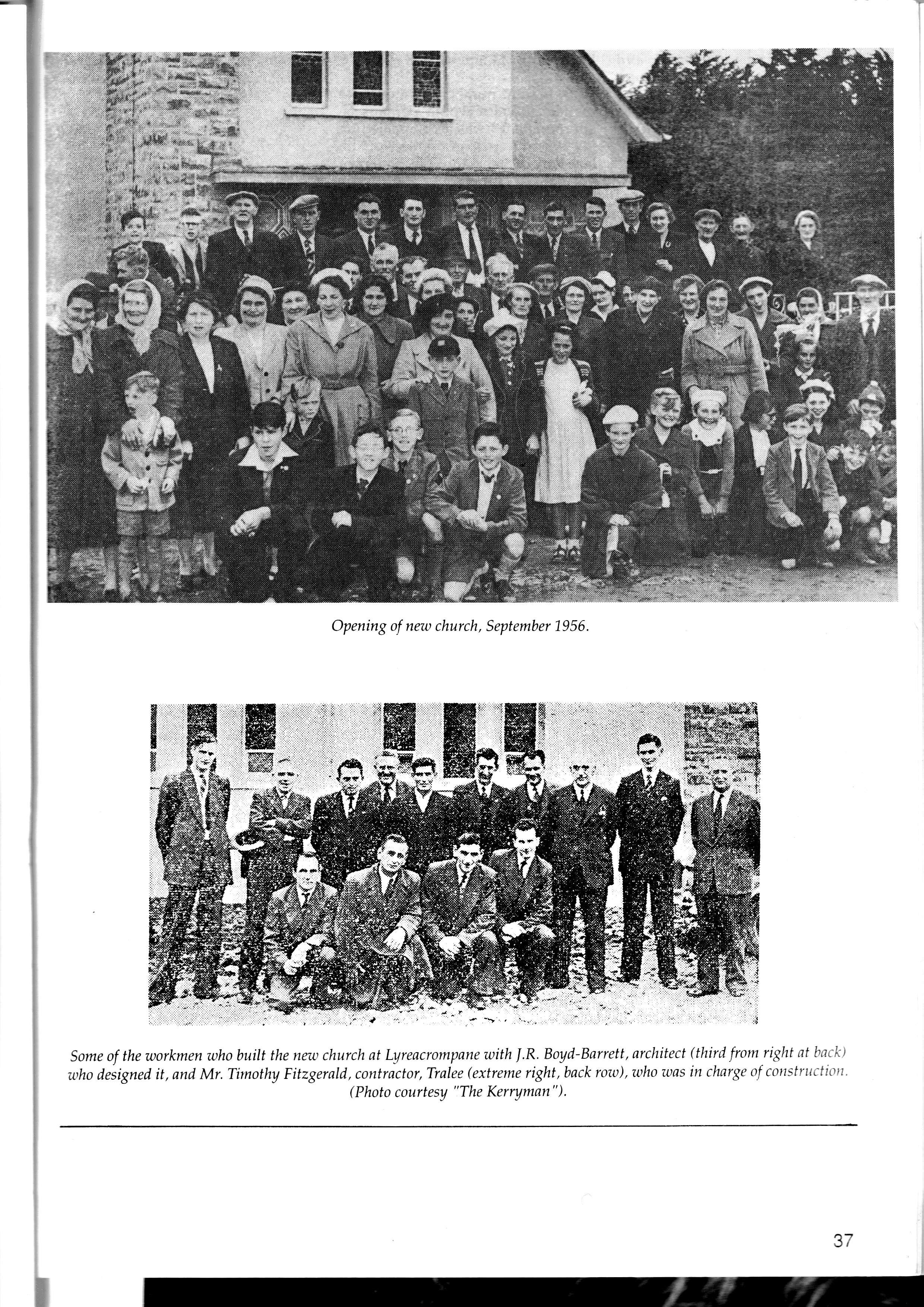
I
Opening of new church, September 1956.
Some of the workmen who bttilt the new church at Lyreacrompane with l.R. Boyd-Barrett, architect (third from right at hack) who designed it , and Mr. Timothy Fitzgerald, contractor, Tralee (extreme right , back row) , who was in charge of constructitltr (Photo courtesY "The KerrYman").
37 T E -r i
I
The late lulie Haruington was well known fot her hearty laugh and sense of humour. As a skit she once sent the following letter to the Queen of Englanil.It utould a?pear that the Palace loasfi't sure if it was from a genuine source and sent a reply.

P.S. I presume that my cousin, Lord Harrington of Limerick will attend.
P.P.S. If I am numbered among the invited guests it w.ould perhaps be appropriate if I was accompanied by my partner, a close relation of the late Earl of Banemore (an honorarv
title; no royal blood) and of Maurice M. Palmer, who lived in the "Great House" near Listowel.
MountainView House Banemore Cross Listupel Co. Kerry
Dear Mr. Secretary
Please convey my heartiest congratulations to Her Majesty, Queen Elizabeth, on the glorious occasion of her son's engagement to that nice lady Diana. It is my firm belief that this marriage will not only bring happiness to this lovely young couple, but will prove to be of immense importance to all true British people.
It is with the utmost hesitation that I venture to broach the question of obtaining an invitation to the wedding of the Prince and Lady Di. Normally I do not presume to make so bold. Since the death, 20 years ago, of my late husband, Lord Crotta, (an acquaintance of Lord Kitchener, who, as you probably know, was born in the nearby barony of Lixnaw) I have kept a very low social profile. Lord Crotta was very much a iecluse and preferred to concentrate his energies on his research into the influence of Irish culture on the literature of the British Empire; unfortunately, as yet unpublished. Howevel, this event is of such importance to the future of the monarchy, the British Commonwealth and, dare I say it, world democracy, that I feel I must do my part. The prospect of this great event has even-taused a certain amount of interest among the local native people and although-Eire has, to its loss, placed itself outside the Commonwealth, I believe it is important to give them the opportu-nity of feeling someway assbiiated with the ceremony. We must think of the future, especially now'that Mr. Haughey seems to be sending out feelers on possible re-admission to the Commonwealth.
_ I would appreciate an early reply, as you can imagine the travel arrangements that must be made for a trip out of this rather primitive backwater.
Yours sincerelv LaCv Harrington.
LoE O{ErLs{'s OFFtcE. S.r J.rc€ s PaLAcE, S.W. l.
llhe Conptroller acknowledges the receipt of your letter but wishes to point out that attendahce at St Paulrs Cathedral- lor the Weddlng of llhe kince of lrlales alxd th€ IAqy Diana Spencer will be by iaritation onty {or which he regrets it is not possible to nalre application.
7th lray 1981
lulia Nash (Haringtod, ight, in Cwentry in1943 withher friend Bidie Boyle (Roscommod.
38
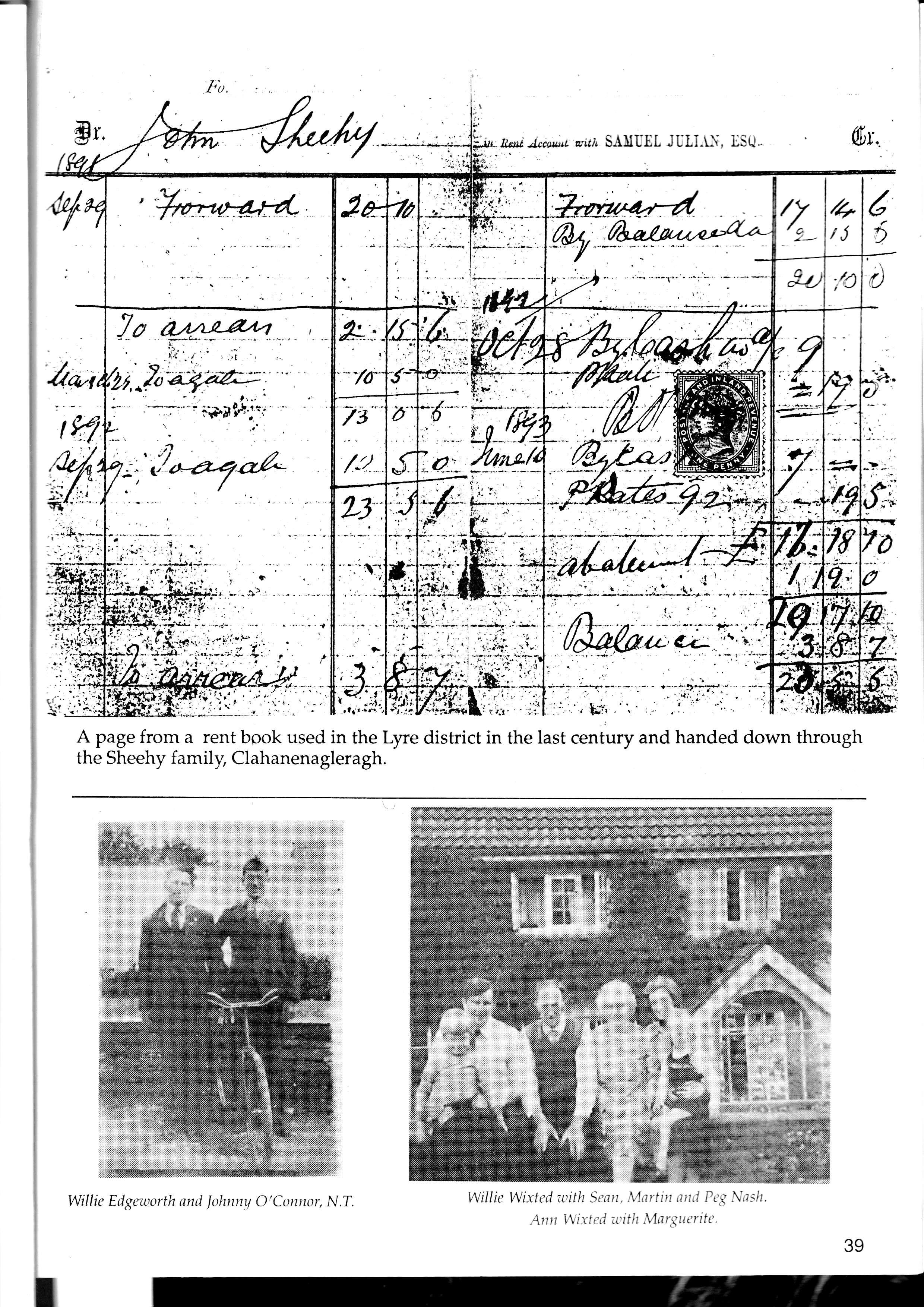
Fb -r/ctu) fir *co*'t a,ila SAlliiIL JULI-L\, LSQl" / tyf I I /z .1 6 +i d 4 iJ lo j,'.t ii l' .:' .L+.---**.-,--t A page from a rent book used in the Lyre district in the last century and handed down through the Sheehy family, Clahanenagleragh.
Willie Wixted with Sean, Martin and Peg Nash Ann Wixted with Marguerite.
Willie Edgeutorth and lohnny O'Connor, N.T.
39 L/' flo*trlar-tt /a /3 /:)?3 fr,t.. .,t ). 1 t. '\i ,-, -.,ii;."'"..;.- '
This tributary, the second on the left-hand bank of the Feale, is approxi.mately 26 miles from Cashen mouth. It is l5 miles in length and rises between the townlands of Knockatarriv and Broughane at a height of 1,062 feet, not far from Knight's Mountain (1083), the highest peak in the Glanaruddery range. As the crow flies it is scarcely two miles from the historic wooded Glounageentha (The glen of the mourning), where in 1583 when the Desmond Rebellion was crushed, the hapless, Gerald, the sixteenth Earl of Desmond was captured by an O'Moriarty from the Maharees and beheaded.

Since the Smearlagh flows mainly through blanket bogland which dominates the landscape for much of its course, or through rather unattractive rushy pastureland, and since it cannot even boast of a village on or near its banks, there is really little that can be written about it unless one wishes to enter the rather eletist domain of the botanist or plant ecologist. The same can be said about many of the Feale tributaries; it is the catchment area as a whole that is of interest, mostly because of its scenic variety, its bleak mountain boglands, its undulating hills and its rich limestonb-based flat lands nearer its mouth.
Of course, one can halt a while here and there, along the banks of any of these tributaries, recall a ballad extolling its beauty, or reminisce perhaps on some near forgotten facet of its local history. One cant but admire the many fine stone bridges with rounded arches, often over what appears to be but an insignificant stream; one can explore its pools and its meanders, watch the trout dimple its still waters, or listen if one has ears for such things, to the faint symphony of its waters trickling through the shallows.
The Smearlagh, a spate river, flows northwards at first through blanket bog and some recent forestry plantations, receiving rivulets or glashas as they are locally called, cheerfully on either bank as it ripples along towards Lyrecrompane (The land enclosed by two converging streams). Here it is joined by its main tributary, the Crompane. Up to the beginning of the last centuryall this countryside was without roads, and was used only as summer grazing - buailing - for cattle.
Lyrecrompane was the focal point for the Bord na Mona turf cutting operations during World War II. Now the bog is practically cut away, and forestry is taking over. There is a church in Ilyrecrompane, a chapel of ease attached to Duagh parish, whose cler_ey are responsible for services there. After Lyrecrompane the river turns abruptly westward through a ravine, then winds north by east again till it empties into the Feale between the townlands of Inchymagilleragh East and West.
Inchymagilleragh means the inch of McGilreavy - a Clare surname.
THE SMEARLAGI"I
40 L I ) ! -/ {
There is a very interesting patch of natural woodland called Beheens wood on a bend in the river before it flows northwards towards the Knight's bridge on the Listowel, Abbeyfeale road. This bridge, now usually known as Smearlagh bridge was built by R. Griffith in 1829.
An English landowner, Sir John Benn-Walsh ( 1788-l 88 I ) owned Derrindaffe. a townland in Duagh parish to the south east of Knight's bridge. Nothing unusual in that, you might say, but Sir John visited his Kerry and Cork properties over twenty times between l82l and I 864, staying a fortnight each time, and what is more, he kept a diary of his visits which is still extant, and which presents a most valuable picture of an absentee landlord's relations with his tenants during this time. He was a man who strove to increase thb profitability of his estates through improvements, and as he was convinced that Derrindaffb was an admirable place for improvement, "since it had a large population arrd sincc thcy (1'hc tenants) ltad tto work lor rtruclr of thc yc;rr. lhcy would e:hccrf trlly givc high rcnts lirr tlteir farnrs"' 'l'lrus l)crrirrdal'l'c was wltitl oltc tttigltt call. ottc ol'his "pct" l':trltts, thc whole appcarancc ol'which he changed during his lil'ctime' Evcn today one can noticc thc dil'lcrelrcc bctwccn p:rrts of I)errindafl-c and thc surrounding townlitttds - it has a "plitntcrs look" about it - rcaspnably largc liclds and sornc becch trccs which arc unusu:ll hercttbouts. His favouritc walk was by the banks ol-thc Sutcurlagh abovc tlrc britlgc. llvctt to<lay it is a sccnic spot of quict bcauty.
--I'he parishes of llallynracelligott, Abbcydorrrcy, I.ixnaw and I-ist<lwcl arc all houndcd by thc Srttcitrlagh. Notc: '['hc Smczrrlagh is altnost always slttlrtcttcd to Sltrcrla norvadays. Its ttreaning would ilppcar to bc:I-he lllackhcrry ['rod ucing I{ ivcr.
THESTIEARLAGH

r
A descriptbn of the Smearlagh td<en from the'The River Feale'by Paddy Lysaght, a native of Duagh and now living in Limerick.
(lr, - "': ..\ F "'irlr
The 4Ah annioersry of Aruly anil Peg O'Connell, Carrigcanaon, at kllingarry Hotzl on Saturilay 6th Se?teiher 1987. Frort row: lohn O'Connell, Andrcu O'Cottrcll, Maureen Hanis, Andy O'Connell, Peg O'Conull, Norrie O'Conncll, Michael O'Connell. Miilillc rout: lerry Satnge, Kathleen O'Connell, Dennis Harrb, Helm O'Conrcll, Maurcen Saoage, Kitty O'Conncll, hu Lynch, Tere* Long, Eileea Lynch, Hanna Lymch, Ann O'Connell, Bernie O'Coancll, Pal Quina, Chiss Quian, Pegic Lyach.
4th roro:I-arry
Martin,leMartin,MiclaelLynch,lury Loag,SeamusLynch,Toildy Lyach, Marguel O'Coanell.
(J A1 +t 'i: t
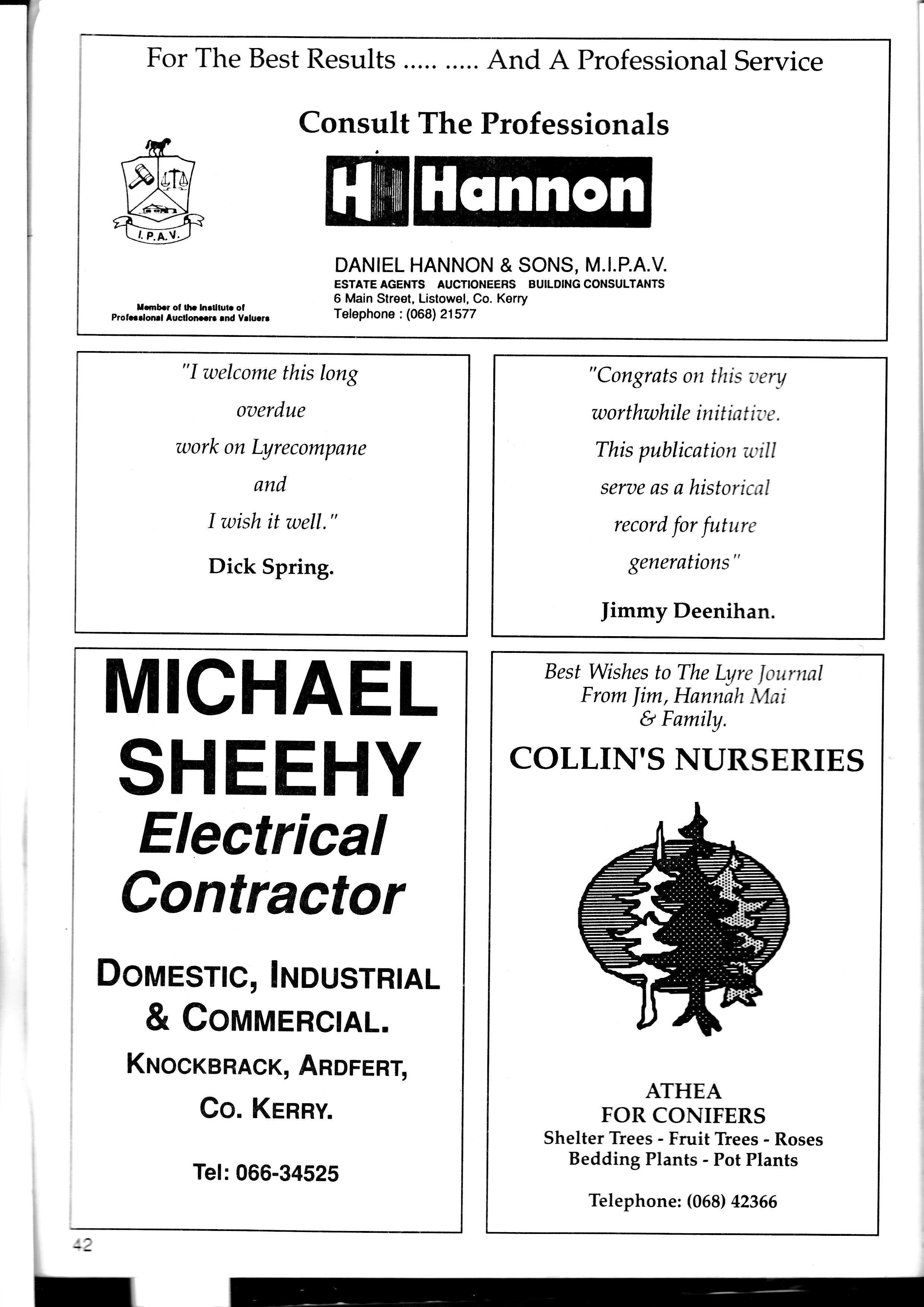
For The Best Results ... And A Professional Service Consult The Professionals lfmb., o, lh. hrlllul. ol Protidonrl Aucllomr rnd Vrluc[ DANIEL HANNON & SONS, M.I.P.A.V. ESTATEAGENTS AUCT]ONEEBS BUILDINGCONSULTANTS 6 Main Street, Listowel, Co. Kerry Telephone : (0681 21577 Hsnnon "I welcome this long oaerdue work on Lyrecompane and I tpish it well." Dick Spring. "Congrats on this aery wor thwhile init iat it e This publication will serae as a historicnl record for future generations" |immy Deenihan. MIGHAEL SHEEHY Electrical Contractor DonaesTlc, IttousrRtAL & ConanaERctAL. KnocxBRAcK, Anorenl Co. KERRY. Best Wishes to The Lyre lournal From lim, Hannah Mni I Family. COLLIN'S NURSERIES ATTIEA FOR CONIFERS Shelter Tiees - Fruit Trees - Roses Bedding Plants - Pot Plants Telephone: (068) 42366 Tel:066-34525
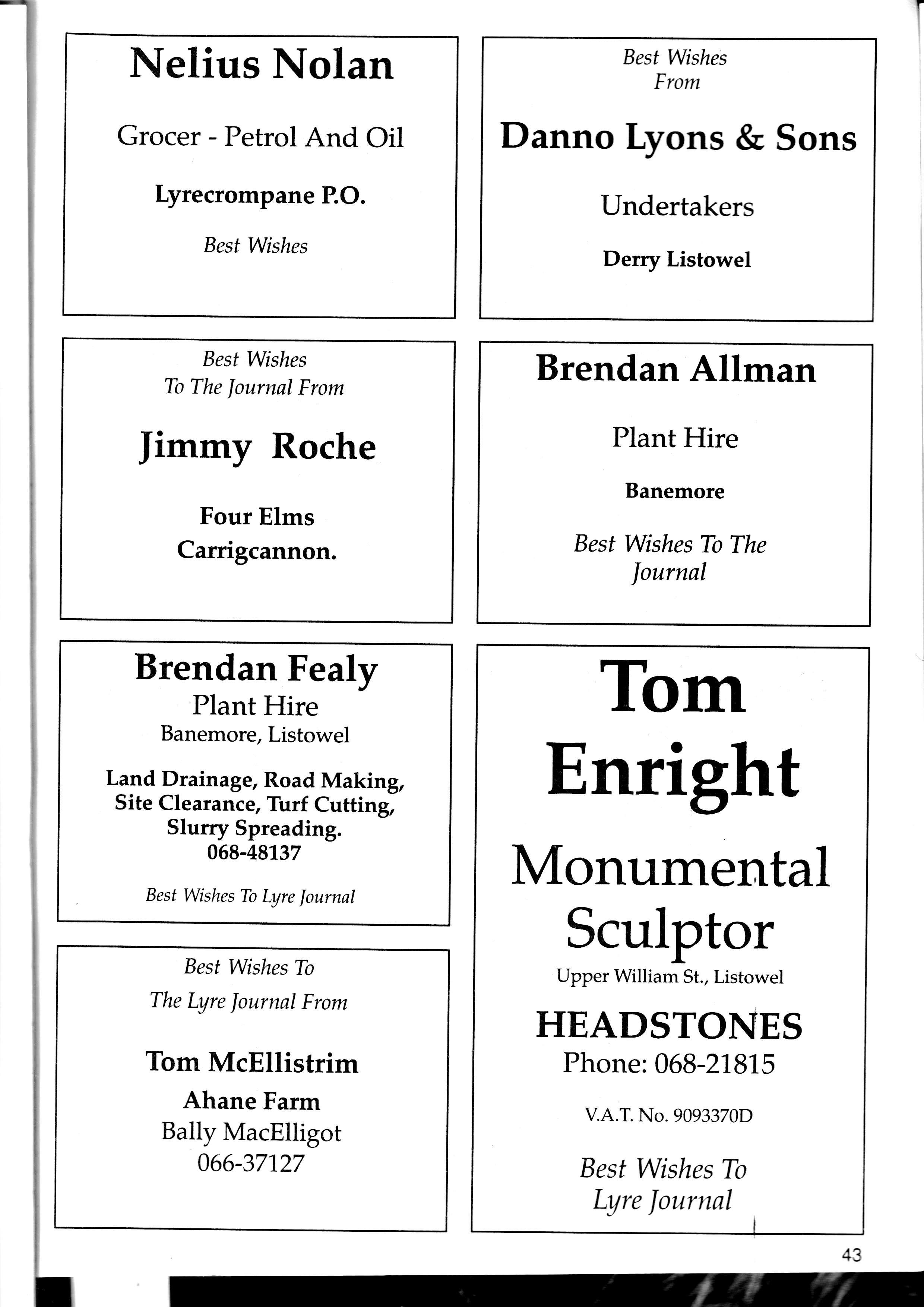
Nelius Nolan Grocer - Petrol And Oil Lyrecrompane P.O. Best Wishes Best Wishes To The lournal From |immy Roche Four Elms Carrigcannon. Land Drainage, Road Making Site Clearance, Turf Cutting Slurry Spreading. 068-48137 Brendan Fealy Plant Hire Banemore, Listowel Best Wishes To Lyre lournal Best Wishes To The Lyre lournal From Tom McEllistrim Ahane Farm Bally MacElligot 066-37127 Best Wishes From Danno Lyons & Sons Undertakers Derry Listowel Brendan Allman Plant Hire Banemore Best Wishes To The lournal r Enright Monumental Sculptor Upper William St., Listowel HEADSTONUS Phone: 068-21,815 Tom V.A.T. No.9093370D Best Wishes To Ltlre lourrml 43
All
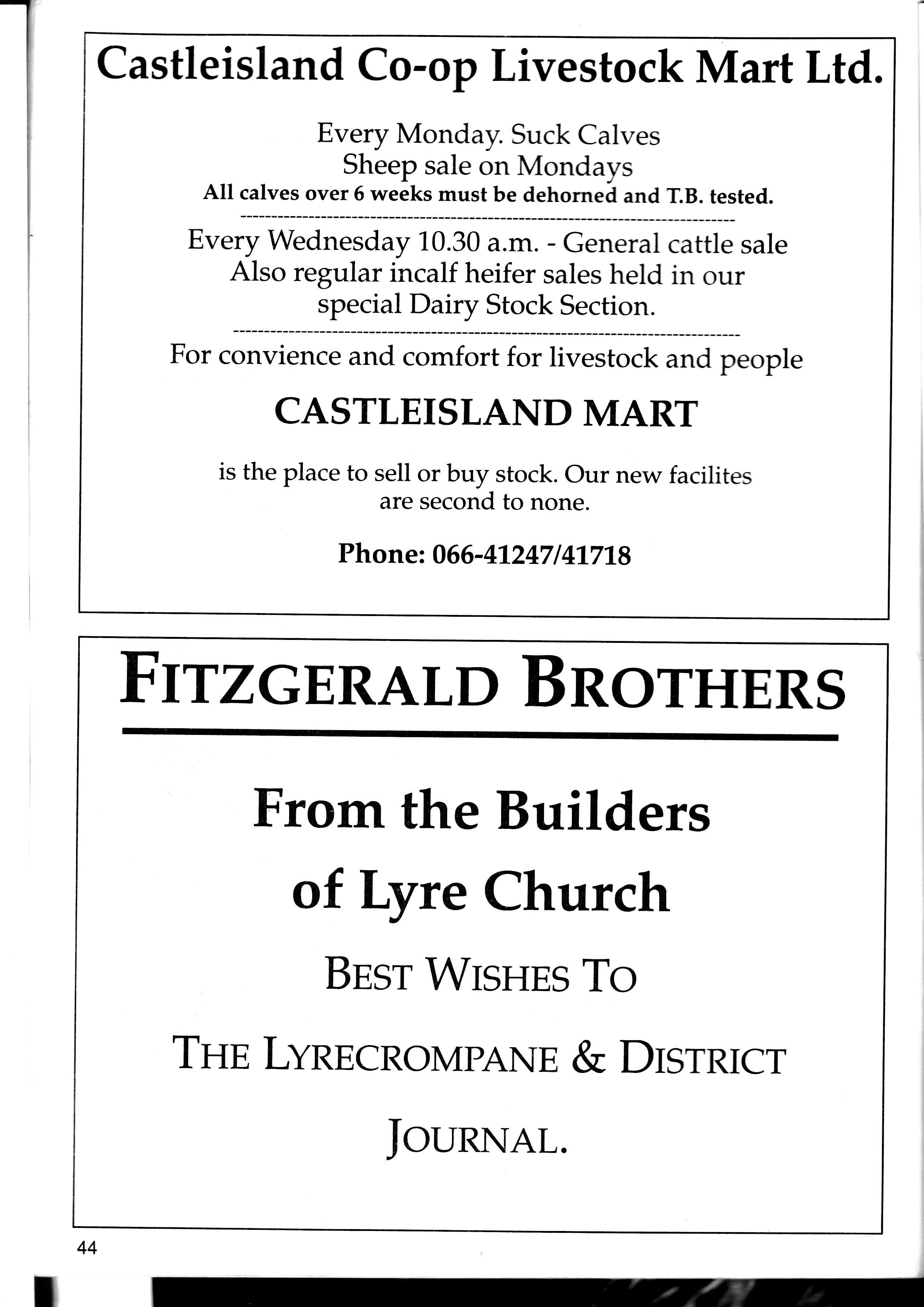
Every
is
Castleisland Co-op Livestock Mart Ltd.
Monday. Suck Calves Sheep sale on Mondays
calves over 5 weeks must be dehorned and T.B. tested. Every Wednesday 10.30 a.m. - General cattle sale Also regular incalf heifer sales held in our special Dairy Stock Section. For convience and comfort for livestock and people CASTLEISTAND MART
the place to sell or buy stock. Our new facilites are second to none. Phone : 066-4\247 I 41718 FruZGERALD BRoTHERS From the Builders of Lyre Church Brsr Wrsurs To THp LynpcRoMpANE & DrsrRrcT ]ounNAL. I 44
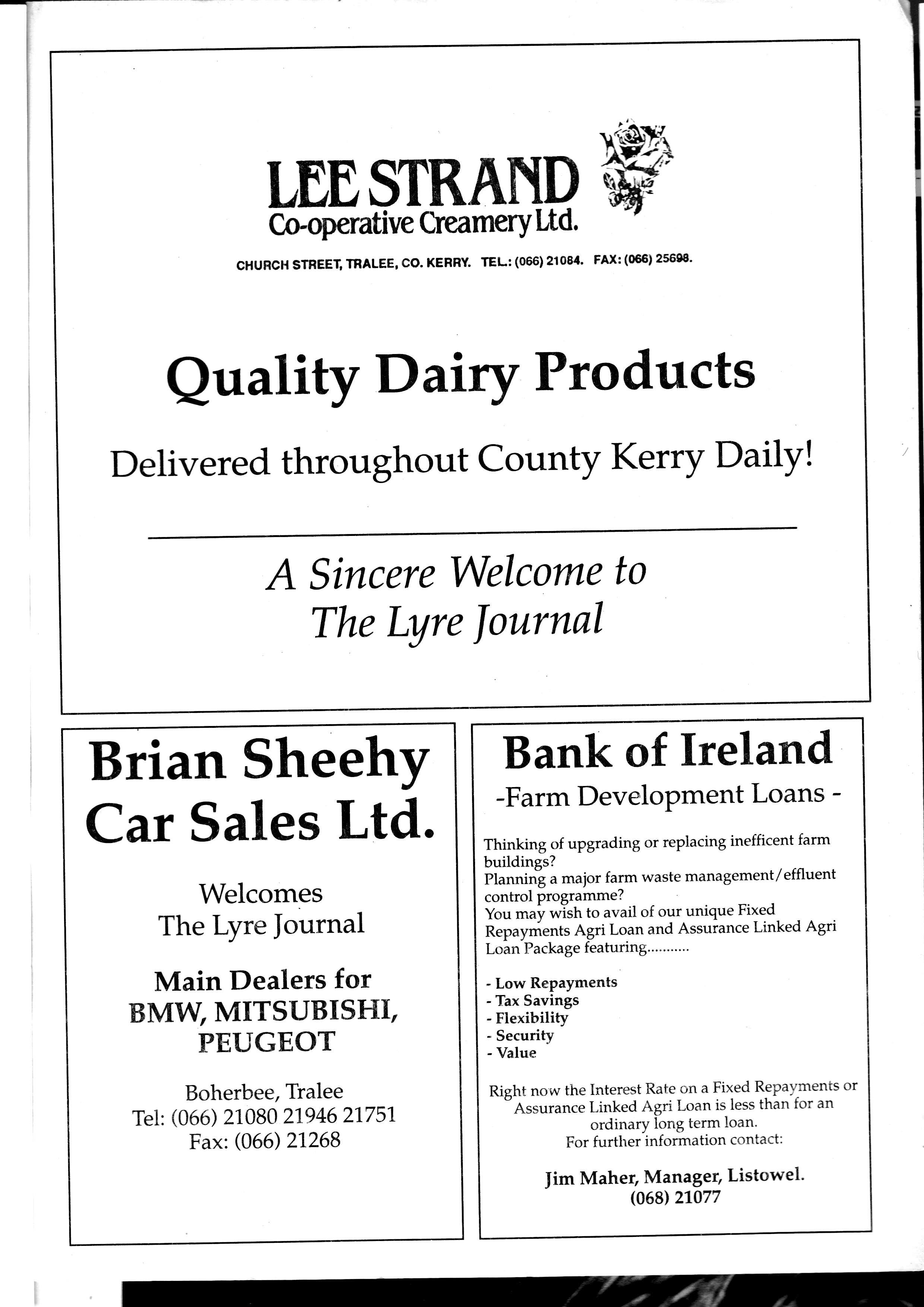
LED STRAND CYeameryLtd. CHURCH STREET, TRALEE, CO. KERRY. TEL: (066) 2108'l' FAX: (066) 2s6e8' auality Dairy Products Delivered throughout County Kerry Daily! A Sincere Welcome to The lryre lournal Brian Sheehy Car Sales Ltd. Welcomes The Lyre )ournal Main Dealers for BMWMITSUBISHI, PEUGEOT Boherbi:e, Tialee Tel: (066) 21080 21q4621751 Fax: (066) 21268 Bank of Iretrand -Farm DeveloPment LoansThinking of upgrading or repiacing inefficent farm buildings? Plannin"g a major farm waste management/effluent control programme? You may wlsh to avail cf our unique Fixed. Repayments Agri Loan and A.ssttratrce I-inked Agri Loan Package featuring....'.....' - Low Repayments - Thx Savings - Flexihility - Securitv - Value Rieht now the Interest Rate on a Fixed Repayments or "Arrr.rr,." Linked Agri Loan is less than for an ordinarY long term loan' For further information contact: )im Maher, Manager, Listowel' (0581 21077 Cooperative
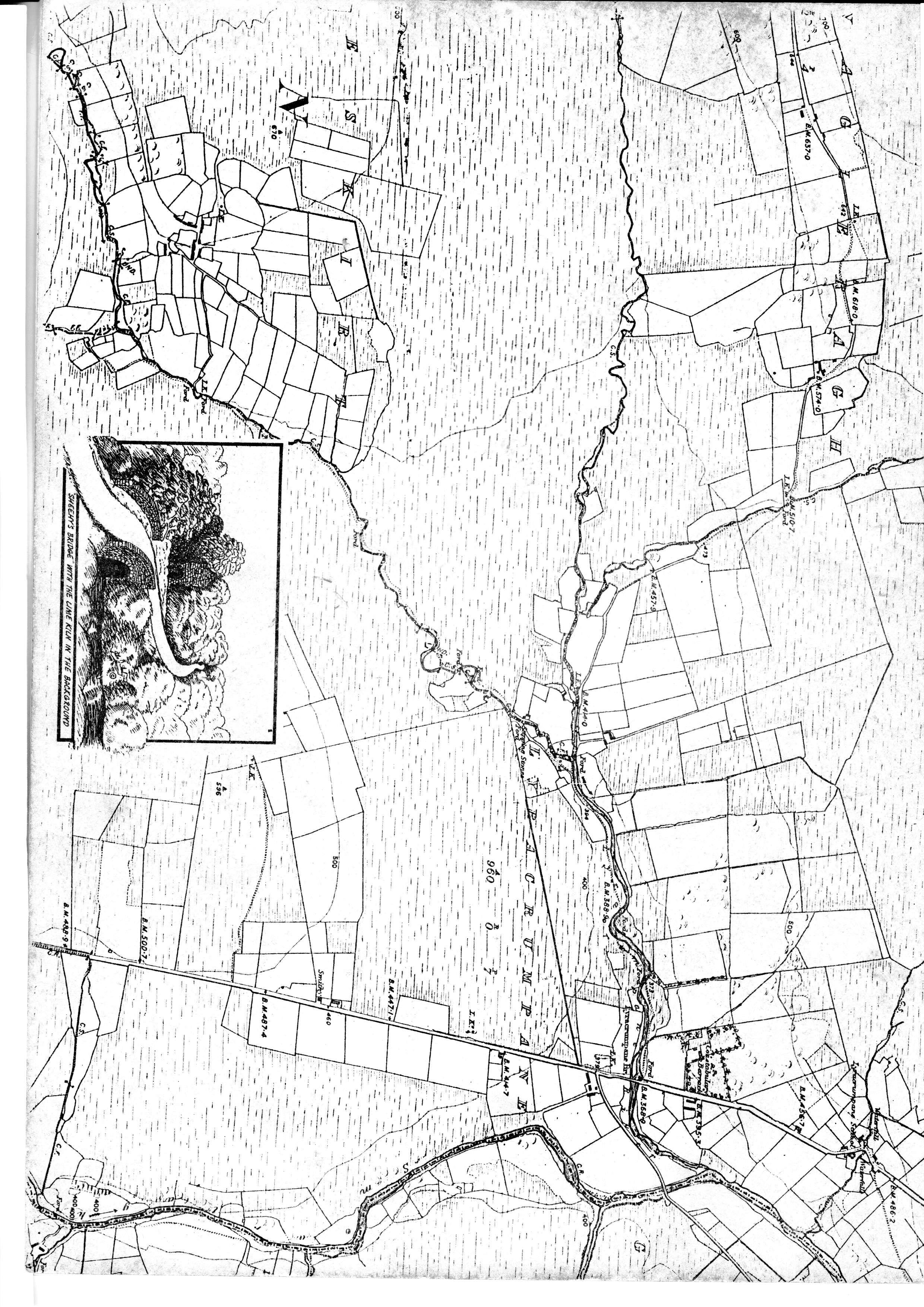
B!) I il, I I li ,l I I l1 .' ,i lr it. ii l iri I j j' I i ti !o, i ol\: .o1 il rjirl i P:r li |,' '4,,r' is i, lF; (s{; i) H ,l I ,i N I 1l i. il ,:l ri Hr, 1l I -t I h '-,., .) ii; i Ir, i! ,::i !, ! I ,l ,i I I :: i rji 'l 'ti I ii j:lt' i, t! lr I i I .l 'i. I I I l ,l ,l JI I i. t: !i I' 'i, ;;{ il ti tr t' l-r o, Iri ,l I Ir 'I l' lr, it! i'i I ,'l ,\II l:l ! t',, ri !1, i!i ....1 ,i il II i I I I il I ",1'i ll li ,.1 ,l'I rl I ,j ,i,,r,, 'ir' i: ; il,'i i. r,, lftli 'i I l. .t, ii lrrriiji i, i'l :,iji,' it ' tlr I i!IJ t; ijl, !rj tl ti .i I !' 1r I J I i, i'i,, rj i: rlll, rl li I I' I I I ! l.i ! i iiI I I I ir t; ii I t, j",1 I 'i , , '. t ;j l tt rl I I ,l !l :!i .: ,il : i I ,i'i, il ,i I I I ,, i I i! .,: 1 tl i, ):: I i i t' ,l' ,.rl il :i ;i j, ,il
















 Michael Sheehy R.LP., deliuering the mail. No doubt he was telling Peg O'Connell, Carrycannon, a good joke.
Michael Sheehy R.LP., deliuering the mail. No doubt he was telling Peg O'Connell, Carrycannon, a good joke.

 (From Kern's Fighting Story)
(From Kern's Fighting Story)


 Kate Connor, Tom Naughton and Moy loyce, Ellen Lynch (Danny Joyce's grandmother) , Mick Edgeworth, Kate Edgeworth, Danny Joyce and Cathy Kelliher, daughter of "Sharper".19j0s.
Kate Connor, Tom Naughton and Moy loyce, Ellen Lynch (Danny Joyce's grandmother) , Mick Edgeworth, Kate Edgeworth, Danny Joyce and Cathy Kelliher, daughter of "Sharper".19j0s.









 lncluded with Bill Nolan, Carrigcannon are four .All-lreland medal winners with Kerry 0903) - Dirrrrv Curran, Maurice McCarthy, Denis Breen and J Corman.
lncluded with Bill Nolan, Carrigcannon are four .All-lreland medal winners with Kerry 0903) - Dirrrrv Curran, Maurice McCarthy, Denis Breen and J Corman.
















